Draft GST/HST Technical Information Bulletin B-103, Harmonized Sales Tax – Place of supply rules for determining whether a supply is made in a province
GST/HST Technical Information Bulletin B-103
June 2012
Note: This Technical Information Bulletin supersedes the version dated June 2010.
The information in this bulletin does not replace the law found in the Excise Tax Act (the Act) and its regulations. It is provided for your reference. As it may not completely address your particular operation, you may wish to refer to the Act or appropriate regulation, or contact a Canada Revenue Agency (CRA) GST/HST rulings office for more information. A ruling should be requested for certainty in respect of any particular GST/HST matter. Pamphlet RC4405, GST/HST Rulings – Experts in GST/HST Legislation explains how to obtain a ruling and lists the GST/HST rulings offices. If you wish to make a technical enquiry on the GST/HST by telephone, please call 1-800-959-8287.
This publication explains the place of supply rules (including new place of supply rules included in the New Harmonized Value-added Tax System Regulations published on June 9, 2010) that determine whether a supply is made in a province for purposes of determining whether the supply is made in a participating province and consequently subject to the provincial part of the HST in addition to the federal part of the HST.
Unless otherwise indicated, all legislative references in this bulletin refer to the Excise Tax Act and its regulations and all references to supplies are to taxable (other than zero-rated) supplies made in Canada.
If you are located in Quebec and wish to make a technical enquiry or obtain a ruling related to the GST/HST, please contact Revenu Québec at 1-800-567-4692. You may also visit their Web site at www.revenu.gouv.qc.ca to obtain general information.
Table of Contents
- Introduction
- Tangible personal property
- Real property
- Intangible personal property
- Overview
- Intangible personal property – General rules
- General rule 1 – Intangible personal property that can only be used primarily in non-participating provinces
- General rule 2 – Intangible personal property that can only be used primarily in participating provinces
- General Rule 3 – Intangible personal property that can be used otherwise than only primarily in participating provinces and otherwise than only primarily outside participating provinces
- General Rule 4 – Participating provinces with the same highest tax rate
- Intangible personal property that relates to passenger transportation services
- Intangible personal property that relates to tangible personal property
- Rule 1 – Intangible personal property that relates to tangible personal property that is not ordinarily located primarily in participating provinces
- Rule 2 – Intangible personal property that relates to tangible personal property ordinarily located primarily in participating provinces
- Rule 3 – Highest tax rate
- Rule 4 – Same highest tax rate
- Intangible personal property that relates to real property
- Intangible personal property that relates to real property in Canada and outside Canada
- Rule 1 – Intangible personal property that relates to real property that is not situated primarily in participating provinces
- Rule 2 – Intangible personal property that relates to real property situated primarily in participating provinces
- Rule 3 – Highest tax rate
- Rule 4 – Same highest tax rate
- Services
- Overview
- Services – General rules
- Personal services
- Services in relation to tangible personal property
- Services in relation to real property
- Services in relation to a location-specific event
- Services rendered in connection with litigation.
- Customs brokerage services
- Repairs, maintenance, cleaning, adjustments, alterations and photographic-related goods
- Services of a trustee in respect of a trust governed by an RRSP, RRIF, RESP, TFSA or RDSP
- 1-900 or 976 service
- Computer-related services and Internet access
- Air navigation services
- Passenger transportation
- Freight transportation services
- Postage and mail delivery services
- Telecommunication services
- Deemed supplies
- Appendix A – List of examples
- Appendix B – Sales of specified motor vehicles
- Appendix C – Place of supply rules for supplies of intangible personal property
- Appendix D – Place of supply rules for services
This publication sets out examples illustrating how the place of supply rules apply to each of the various situations discussed. Appendix A provides a reference list of all of the examples included in this publication along with the applicable legislative references.
Introduction
Generally, before July 1, 2010, taxable supplies made in Canada were subject to the goods and services tax (GST) at a rate of 5% unless they were made in the participating provinces of Nova Scotia, New Brunswick or Newfoundland and Labrador, in which case they were subject to the harmonized sales tax (HST) of 13% (of which 5% represented the federal part and 8% the provincial part). Schedule IX to the Act and the previous Place of Supply (GST/HST) Regulations set out the place of supply rules to determine whether supplies that were made in Canada were made in those three participating provinces or in the rest of Canada.
The following changes occurred effective July 1, 2010:
- The Government of Ontario introduced a 13% HST, of which 5% represents the federal part and 8% the provincial part.
- The Government of British Columbia introduced a 12% HST, of which 5% represents the federal part and 7% the provincial part. On August 26, 2011, Elections BC announced that British Columbians have voted in favour of eliminating the HST in British Columbia. On February 17, 2012, the Department of Finance published a news release, Department of Finance Announces Transitional Rules for the Elimination of the Harmonized Sales Tax in British Columbia (2012-017), announcing proposed transitional rules for the provincial decision to eliminate the HST in British Columbia (B.C.). The proposed transitional rules specify how and when the B.C. part of the HST would cease to apply to transactions that straddle that date. The implementation date for the transition from the HST to the GST on taxable supplies made in B.C. would be April 1, 2013, subject to the approval of the British Columbia Legislature.
- The Government of Nova Scotia increased the provincial part of the HST from 8% to 10%. The HST rate in Nova Scotia is now 15%, of which 5% represents the federal part and 10% the provincial part. On April 2, 2012, the Government of Nova Scotia announced that the province's surplus will be significant enough in 2014 to lower the HST by one percentage point, and another percentage point in the following year, bringing the rate of the HST back to 13% in 2015.
- On April 18, 2012, the Government of Prince Edward Island announced they were entering into formal negotiations with the federal government to implement an HST, effective April 1, 2013. The combined HST rate will be 14% with a provincial part of 9% and a federal part of 5%.
Because different tax rates came into effect in July 1, 2010, and to modernize the rules, a number of changes were required to be made to the place of supply rules, including the introduction of some new place of supply rules. For this reason, the Place of Supply (GST/HST) Regulations were repealed and replaced by Part 1 of the New Harmonized Value-added Tax System Regulations, that set out the new place of supply rules applicable to certain supplies made:
- on or after May 1, 2010; and
- after February 25, 2010 and before May 1, 2010 unless any part of the consideration for the supply became due or was paid before May 1, 2010.
The place of supply rules explained in this publication are set out in Schedule IX and the New Harmonized Value-added Tax System Regulations . Under section 144.1, a supply is deemed to be made in a province if it is made in Canada and it is deemed to be made in the province under the place of supply rules in Schedule IX, but is deemed to be made outside the province in any other case. Also, a supply that is made in Canada that is not made in any participating province is deemed to be made in a non-participating province. Pursuant to section 3 of Part IX of Schedule IX, notwithstanding the place of supply rules in any other Part of Schedule IX, a supply of property or a service is made in a province if it is prescribed to be made in the province by Part 1 of the New Harmonized Value-Added Tax System Regulations. Unless otherwise indicated, all references to the place of supply rules in this publication are to these place of supply rules, and any references to the Regulations are to these regulations, unless otherwise indicated.
The GST (or federal part of the HST) is imposed under subsection 165(1) in respect of taxable supplies that are made in Canada. The provincial part of the HST is imposed under subsection 165(2) in addition to the federal part of the HST in respect of taxable supplies that are made in a participating province.
The provincial part of the HST does not always apply at the same rate to supplies made in the participating provinces, nor does it apply to supplies made outside the participating provinces. Consequently, the place of supply rules are complemented by new rules requiring self-assessment of the provincial part of the HST where personal property and services are brought into a participating province from a non-participating province, or another participating province or from outside Canada for consumption, use or supply in the participating provinces. These rules are set out in Division IV.1, Schedule X, and Part 5 of the New Harmonized Value-Added Tax System Regulations No. 2, including proposed amendments issued on January 28, 2011. Rebates of the provincial part of the HST paid on supplies of property or services made in the participating provinces may also be available if the property or services are removed from a participating province for consumption, use or supply outside the participating province. These rules are set out in Division VI and Part 5 of the New Harmonized Value-Added Tax System Regulations No. 2, including proposed amendments issued on January 28, 2011. In addition, changes have been made to the imported taxable supply rules to ensure that the provincial part of the HST applies consistently irrespective of whether a supply is made in Canada, or outside Canada. These rules are set out in Division IV.
It should be noted that generally, selected listed financial institutions (SLFIs), as defined in subsection 225.2(1), are not required to self-assess the provincial part of the HST under Division IV.1, and are not entitled to claim any rebates in respect of the provincial part of the HST. Also, SLFIs are not generally required to self-assess the provincial part of the HST under Division IV. Instead, SLFIs generally account for the provincial part of the HST through adjustments to their net tax calculation under subsection 225.2(2), and related regulations, including proposed regulations issued on January 28, 2011.
Issues to consider in applying the place of supply rules
The place of supply rules explained in this publication apply to determine whether a supply that is made in Canada is made in a province for purposes of determining whether the supply is made in a participating province and is consequently subject to the provincial part of the HST in addition to the federal part of the HST. This publication is intended to explain the application of these place of supply rules. However, there are several issues that must be considered in order to properly determine the application and relevancy of the place of supply rules.
i) Single and multiple supplies
In determining the place of supply, it is necessary to determine whether a transaction consisting of several elements is a single supply or multiple supplies. This is necessary because the application of certain place of supply rules can provide a different result depending on whether single or multiple supplies are involved, which can in turn result in the application of different tax rates. The determination of whether single or multiple supplies are made can also affect which place of supply rule applies. For instance, where it is determined that a single supply consisting of different types of elements is made, it would generally be the relevant general place of supply rule that would apply to that supply, rather than the specific place of supply rule that would apply to each of the elements of the supply if they were instead determined to be supplied separately.
For GST/HST purposes, the determination of whether a transaction consisting of several elements is to be regarded as a single supply or multiple supplies is based on a determination of fact. The following principles are used to determine whether a transaction consisting of several elements is to be regarded as a single supply or multiple supplies:
- Every supply should be regarded as distinct and independent.
- A supply that is a single supply from an economic point of view should not be artificially split.
- There is a single supply where one or more elements constitute the supply and any remaining elements serve only to enhance the supply.
There are various issues to consider in conducting a single/multiple supply analysis.
It is necessary to identify the various elements of a supply. An element of a supply is any property or service that could reasonably be supplied on its own. In identifying and analyzing the various elements of a package of property and/or services, a distinction must be made between elements that are actually supplied to the recipient and those that are simply inputs consumed or used in making a supply.
Consideration of the following issues can help to determine whether a transaction consists of a single supply or multiple supplies:
- Whether the property/services are provided by two or more suppliers.
- Whether there is more than one recipient.
- What the supplier is providing for the consideration received.
- Whether the recipient is made aware of the elements (in detail) that are part of the package.
- Whether, in the context of the particular transaction, the recipient has the option to acquire the elements separately or to substitute elements.
Incidental supplies
(Section 138)
If a single/multiple supply analysis concludes that there are multiple supplies, it is then necessary to determine whether one of those supplies is incidental to another and whether it may consequently be deemed to form part of a single supply pursuant to section 138. To be considered incidental, a supply generally plays only a minor or subordinate role in relation to the provision of another supply.
Section 138 deems a supply to form part of another supply provided that they are supplied together for a single consideration. For this provision to apply, it must be reasonably regarded that the provision of one property or service is incidental to the supply of the other. With respect to the conditions that must be met for section 138 to apply, see GST/HST Policy Statement P-159, Meaning of the Phrase "reasonably regarded as incidental" and GST/HST Policy Statement P-160, Meaning of the Phrase "where a particular property or service is supplied together with any other property or service".
There are also several legislative provisions that deem single or multiple supplies to be made, some of which are explained in the relevant sections of this publication.
The above explanation is merely intended to highlight the relevant issues to consider in conducting a single/multiple supply analysis. The determination of whether a single or multiple supplies are made requires consideration of the relevant facts of each case. The examples throughout this publication are based on an assumption of fact that single or multiple supplies are being made in those examples based on a single/multiple supply analysis. For further information regarding this issue, refer to GST/HST Policy Statement P-077, Single and Multiple Supplies.
ii) Characterization of supplies
The determination of the nature of a supply is relevant for various GST/HST purposes. It is relevant for purposes of the place of supply rules because there are different place of supply rules that apply to different types of supplies.
Defined terms
(Subsection 123(1))
There are several general legislative definitions that are relevant to the determination of the nature of a supply.
"Property" means any property, whether real or personal, movable or immovable, tangible or intangible, corporeal or incorporeal, and includes a right or interest of any kind, a share and a chose in action, but does not include money.
"Personal property" means property that is not real property.
"Real property" includes:
- in respect of property in the Province of Quebec, immovable property and every lease thereof,
- in respect of property in any other place in Canada, messuages, lands and tenements of every nature and description and every estate or interest in real property, whether legal or equitable, and
- a mobile home, a floating home and any leasehold or proprietary interest therein.
Tangible personal property generally means personal property that may be seen and touched, and that is movable at the time the supply is made. Intangible personal property generally means property other than tangible personal property and real property.
As an exception, the manner in which a supply of real property or tangible personal property is made can affect its characterization and the place of supply rules that consequently apply to that supply. For example, a supply, by way of lease, licence or similar arrangement, of the use or right to use real property or tangible personal property is deemed under the Act to be a supply of real property or tangible personal property, as the case may be. There are also different place of supply rules that apply to sales and leases of tangible personal property.
A "service" means anything other than:
- property,
- money, and
- anything that is supplied to an employer by a person who is or agrees to become an employee of the employer in the course of or in relation to the office or employment of that person.
Determining whether a supply of intangible personal property or a service is made continues to be important for purposes of the general place of supply rules that apply to these types of supplies. The definition of property includes a right or interest of any kind and can therefore include a wide range of rights. A service generally includes anything other than property.
In determining whether a particular supply is a supply of intangible personal property or a supply of a service, a number of factors must be considered. The nature of the agreement between the supplier and the customer, and whether the agreement is in substance for work (or work and materials), or for property (including a right or interest of any kind) must be determined. A key factor in making the distinction between a supply of intangible personal property and a service is whether the supply includes the provision of any rights and if so, whether those rights are the predominant element of the supply. If the supply includes the provision of rights and the rights are the predominant part of the supply, the supply is likely a supply of intangible personal property. If the rights are merely incidental, the supply is likely a supply of a service.
Factors that generally indicate that a supply is one of intangible personal property are:
- a right in a product or a right to use a product for personal or commercial purposes is provided, such as:
- intellectual property or a right to use intellectual property (e.g., a copyright), or
- rights of a temporary nature (e.g., a right to view, access or use a product while on-line);
- a product is provided that has already been created or developed, or is already in existence;
- a product is created or developed for a specific customer, but the supplier retains ownership of the product; and
- a right to make a copy of a digitized product is provided.
Factors that generally indicate that a supply is a service are:
- the supply does not include the provision of rights (e.g., technical know-how), or if there is a provision of rights, the rights are incidental to the supply;
- the supply involves specific work that is performed by a person for a specific customer; and
- there is human involvement in making the supply.
There are specific place of supply rules that apply to supplies of specific types of property and services. Therefore, once a supply has been characterized as a supply of property or a service, it must sometimes also be determined whether it is a supply of a specific type of property or service. For example, in some cases it is necessary to determine whether a supply that is made is a supply of a general service or a service in relation to tangible personal property.
A supply that has been characterized as a specific type of supply for which there is a specific place of supply rule may be subject to the general place of supply rule for that type of supply where the conditions for the application of the specific place of supply rule have not been met.
The manner in which a supply is made can also affect its characterization and the place of supply rules that consequently apply to that supply. For example, a supply made by way of lease, licence or similar arrangement, of the use or right to use real property or tangible personal property is deemed under the Act to be a supply of real property or tangible personal property, as the case may be. There are also are different place of supply rules that apply to supplies of tangible personal property made by way of lease, licence or similar arrangement.
There are more specific legislative definitions and interpretative positions that are relevant to the determination of the nature of certain supplies as explained in this publication.
iii) Place of supply rules for Canada
The place of supply rules explained in this publication only apply to determine whether a supply that is made in Canada is made in a province. Before considering the application of the place of supply rules, it is therefore necessary to determine whether the supply is made in Canada. Different place of supply rules determine whether a supply is made in or outside Canada for purposes of determining whether the GST or the federal part of the HST applies to the supply. These rules, that are also based on the nature of the supply that is made, are explained in GST/HST Memorandum 3.3, Place of Supply. In some cases, a supply may be deemed to be made outside Canada based on the status of the recipient, such as with respect to supplies involving drop-shipments as explained in GST/HST Memorandum 3.3.1 Drop-Shipments. In other cases, a supply may be deemed to be made outside Canada based on the status of the supplier such as where the supply is made by a non-resident who is not registered and is not carrying on business in Canada. If a supply is made outside Canada based on these place of supply rules, it is not necessary to consider the application of the place of supply rules explained in this publication.
iv) Tax status of supplies
The place of supply rules explained in this publication are only relevant for purposes of determining whether a supply is made in a province for purposes of determining whether the provincial part of the HST is payable in respect of taxable supplies that are made in Canada. Such a determination is not necessary with respect to exempt supplies (supplies included in Schedule V) in respect of which tax is not payable and zero-rated supplies (supplies included in Schedule VI) in respect of which the rate of tax is 0%. For more information on zero-rated and exempt supplies, refer to Chapters 4 and 5 of the GST/HST Memoranda Series.
Tangible personal property
For the purposes of the place of supply rules that determine whether a supply is made in a province,
- a floating home and a mobile home that is not affixed to land are each deemed to be tangible personal property and not real property; and
- where an agreement for a supply of tangible personal property is entered into but the property is never delivered to the recipient, the property is deemed to have been delivered where the property was to be delivered, as the case may be, under the terms of the agreement.
Tangible personal property supplied by way of sale
(Section 1 of Part II of Schedule IX)
The place of supply rules for sales of tangible personal property have not changed. A "sale", in respect of property, includes any transfer of the ownership of the property and a transfer of the possession of the property under an agreement to transfer ownership of the property.
Generally, a sale of tangible personal property is deemed to be made in a province if the supplier delivers the property or makes it available in the province to the recipient of the supply.
This rule is generally based on the province in which legal delivery of the goods to the recipient occurs which can generally be determined by reference to the terms of the agreement for the sale of the goods and the applicable sale of goods law.
A new place of supply rule which is explained later would apply with respect to the sale of a specified motor vehicle in certain circumstances.
Deemed delivery
(Section 3 of Part II of Schedule IX)
The above place of supply rule is generally based on the province in which legal delivery of the goods to the recipient occurs. However, for the purposes of this rule, tangible personal property is also deemed to be delivered in a particular province, and not in any other province, if the supplier either:
- ships the property to a destination in the particular province that is specified in the contract for carriage of the property;
- transfers possession of the property to a common carrier or consignee that the supplier has retained on behalf of the recipient to ship the property to such a destination;
This rule requires the supplier to be sufficiently involved in securing the transportation of the good by the common carrier or consignee. The supplier must retain a common carrier or consignee on behalf of the recipient (rather than on the supplier's behalf or on behalf of a person other than the recipient) to have the good shipped to a province pursuant to terms negotiated, and instructions provided, by the supplier. A supplier that merely contacts a common carrier or consignee to indicate that the good is ready to be transported pursuant to an arrangement that has already been established by the recipient with the carrier or consignee, or that is merely made aware of such an arrangement, is not considered to have retained the carrier or consignee on behalf of the recipient. - sends the property by mail or courier to an address in the particular province.
Example 1
A supplier in Ontario sells a good to a purchaser in British Columbia. Based on the terms of delivery in the agreement for the supply of the good, legal delivery of the good to the purchaser occurs in British Columbia.

Because legal delivery of the good to the purchaser occurs in British Columbia, the supply is made in British Columbia and is subject to HST at a rate of 12%.
Example 2
A supplier in Alberta sells a good to a purchaser in Ontario. Based on the terms of delivery in the agreement for the supply, legal delivery of the good to the purchaser occurs in Alberta. However, the supplier also hires a common carrier to ship the good to the purchaser in Ontario. Ontario is specified as the destination in the contract for carriage of the good. The carrier invoices the supplier for the freight service. The supplier pays the amount to the carrier and invoices the purchaser for the amount.
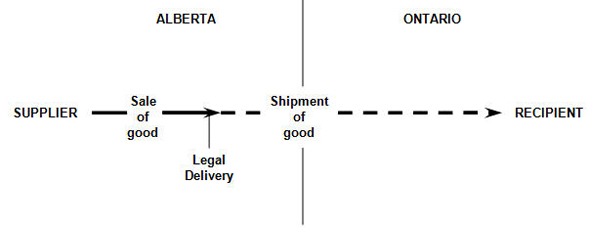
Although legal delivery of the good to the purchaser occurs in Alberta, delivery of the good to the purchaser occurs in Ontario because the supplier ships the good to Ontario. Therefore, the supply of the good is made in Ontario and is subject to HST at a rate of 13%.
Example 3
A retailer in Ontario sells a good to a purchaser that is a resident of British Columbia and is visiting Ontario. The purchaser picks up the good at the retailer's premises in Ontario and then transports it by car to British Columbia. Legal delivery of the good occurs at the Ontario company's premises.
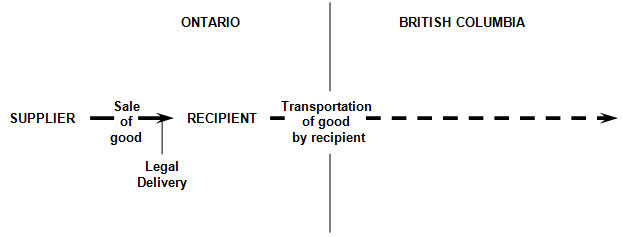
The good is delivered to the purchaser in Ontario. Therefore, the supply is made in Ontario and is subject to HST at a rate of 13%.
Example 4
A company in New Brunswick sells a good to a company in Ontario. The Ontario company picks up the good at the New Brunswick company's premises using its own truck and then transports it to Ontario. Legal delivery of the good occurs at the New Brunswick company's premises.
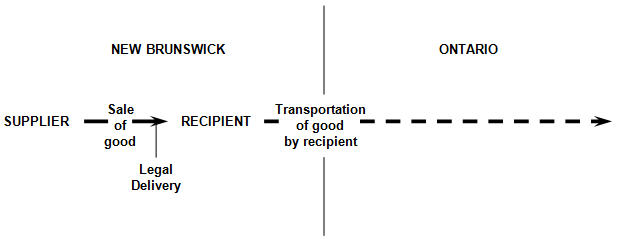
The good is delivered to the purchaser in New Brunswick. Therefore, the supply is made in New Brunswick and is subject to HST at a rate of 13%.
Example 5
A manufacturer in Ontario sells a good to a wholesaler in Manitoba. Legal delivery of the good occurs in Ontario at the manufacturer's premises. The wholesaler regularly purchases goods from the manufacturer and establishes freight terms with a common carrier for the regular transportation of goods from the manufacturer's premises to Manitoba whenever required. The wholesaler instructs the manufacturer to contact the carrier directly to advise the carrier whenever goods are ready for pick-up. The carrier invoices the wholesaler for any transportation service that is provided pursuant to their arrangement.
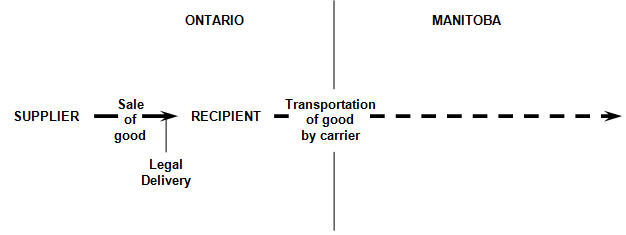
The good is delivered to the purchaser in Ontario. Therefore, the supply is made in Ontario and is subject to HST at a rate of 13%.
Example 6
A wholesaler in British Columbia sells a good to a retailer in Alberta. Legal delivery of the good occurs in British Columbia at the wholesaler's premises. The retailer requests that the wholesaler retain a carrier on its behalf for carriage of the goods to its Alberta premises. The wholesaler negotiates freight terms with a common carrier on behalf of the retailer and provides the carrier with instructions regarding the shipment of the goods to Alberta. The wholesaler pays the carrier for the cost of the freight and is reimbursed for the cost by the retailer.
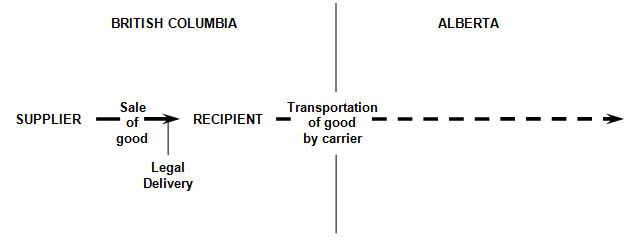
Although legal delivery of the good to the purchaser occurs in British Columbia, delivery of the good to the purchaser occurs in Alberta because the supplier retains a common carrier on behalf of the recipient to ship the good to Alberta. Therefore, the supply of the good is made in Alberta and is subject to GST at a rate of 5%.
Example 7
A manufacturer in Ontario sells a good to a company headquartered in British Columbia. The British Columbia company arranges to have one of its branches in Ontario pick up the good at the manufacturer's premises in Ontario with its own truck and then transport it to British Columbia.
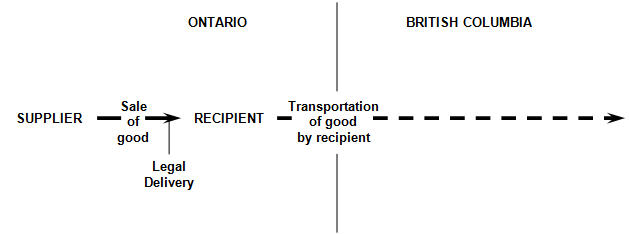
The good is delivered to the purchaser in Ontario. Therefore, the supply is made in Ontario and is subject to HST at a rate of 13%.
Example 8
A mail-order company located in Nova Scotia sells goods to customers across Canada. The company places some of the packages of goods in the mail for delivery to its customers in Ontario.
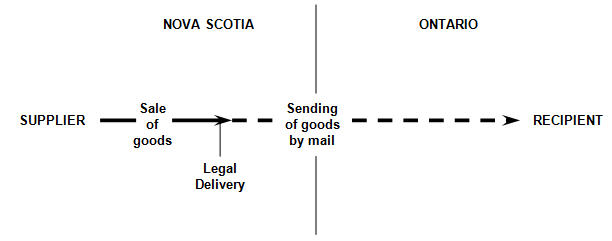
Although legal delivery of the goods occurs in Nova Scotia, delivery of the goods occurs in Ontario because they are sent by the supplier to Ontario by mail. The supply of the goods is made in Ontario and is subject to HST at a rate of 13%.
Example 9
A supplier in British Columbia sells a good to an Ontario company. Based on the terms of delivery for the supply of the good, legal delivery to the purchaser occurs in British Columbia. The supplier hires a courier to send the good to an address outside Canada.
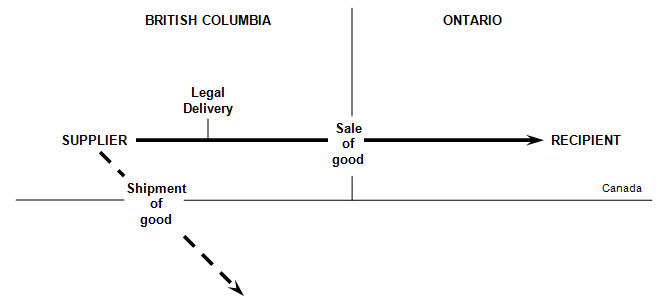
Although the supply of the good is made in British Columbia, the supply is zero-rated as an export under section 12 of Part V of Schedule VI because the supplier sends the good by courier to an address outside Canada.
Delivery of tangible personal property on exercise of option
(Subsection 136.1(1.1))
For GST/HST purposes, a recipient of a supply by way of lease, licence or similar arrangement of tangible personal property that exercises an option to purchase the property under the arrangement is, for greater certainty, deemed to take delivery of the property supplied by way of sale at the place and time at which the recipient ceases to have possession of the property as a lessee and begins to have possession of the property as a purchaser. Therefore, the place of supply rules for the sale of the tangible personal property are based on the place at which the recipient begins to have possession of the property as a purchaser rather than the place where the recipient first obtained possession of the property as a lessee.
New place of supply rule for sales of specified motor vehicles
A "specified motor vehicle" is defined in the Act to mean a vehicle that is, or that would be, if it were imported, classified under one of several tariff items in Schedule I to the Customs Tariff. Generally, this includes all motor vehicles, other than racing cars classified under heading number 87.03, and any prescribed motor vehicles.
As explained in GST/HST Info Sheet GI-119, Harmonized Sales Tax – New Place of Supply Rule for Sales of Specified Motor Vehicles, for purposes of administrative simplification, the Department of Finance has indicated that it intends at the earliest opportunity to recommend a regulatory change to the place of supply rules made under the Excise Tax Act that would deem the supply of a specified motor vehicle by way of sale to be made in the particular province in which the vehicle is registered if that registration occurs within seven days after the day on which delivery of the vehicle to the recipient in a participating province (other than the particular province) occurs. The proposed regulatory change would be published in the Canada Gazette in accordance with the federal regulatory process and would come into force at that time. However, it will be proposed that the regulatory change have retrospective application in some circumstances to July 1, 2010.
In anticipation of the recommendation by the Department of Finance of such a regulatory change and to allow affected parties to benefit from the administrative simplification that it would provide, the CRA has begun administering the new place of supply rule, where suppliers choose to apply the rule. Therefore, as an exception to the general place of supply rule for sales of goods, where a supplier makes a supply by way of sale of a specified motor vehicle, the supply would be administratively considered by the CRA to be made in a particular province if:
- the vehicle is registered (other than on a temporary basis) by or on behalf of the recipient under the laws of the particular province relating to the registration of motor vehicles within seven days after the day on which the vehicle is delivered or made available to the recipient in a participating province (other than the particular province), and
- the supplier maintains evidence satisfactory to the Minister of National Revenue of that registration.
The documentary evidence that a supplier would be required to maintain in its records to substantiate the application of the new place of supply rule would be:
- a dated copy of the permanent registration of the vehicle in the province in the recipient's name, and
- a copy of the vehicle purchase agreement, or other sales document such as a bill of sale, that indicates the date of delivery of the vehicle.
In order to substantiate to the relevant vehicle registration authority of a particular participating province that self-assessment of the provincial part of the HST is not required when the vehicle is registered in the particular participating province, a recipient would be required to make available to the vehicle registration authority a copy of the vehicle purchase agreement or other sales document such as a bill of sale showing the date of delivery of the vehicle in another participating province and that the provincial part of the HST in respect of the particular participating province is payable, or has been paid, in respect of the supply.
Based on the recommendation to be made by the Department of Finance, the new administrative place of supply rule would apply to:
- any supply of a specified motor vehicle made by way of sale on or after the date of final publication of the regulatory change in the Canada Gazette; and
- any supply of a specified motor vehicle made by way of sale on or after July 1, 2010, and before the date of final publication of the regulatory change in the Canada Gazette, in respect of which the rule has been applied (i.e. based on the rule, the supplier has collected the provincial part of the HST, if any, of the province in which the vehicle was registered within seven days after the day on which it was delivered or made available to the recipient).
Example 10
An automobile dealer located in Ontario sells a specified motor vehicle to a recipient who is resident in Quebec. Delivery of the vehicle to the recipient occurs in Ontario at the location of the dealership. Before delivery of the vehicle to the recipient in Ontario, the dealer registers the vehicle in Quebec on behalf of the recipient. The recipient subsequently drives the vehicle to Quebec.
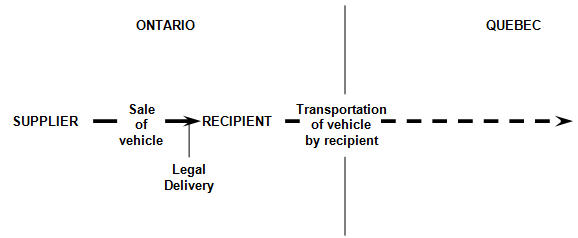
Although delivery of the vehicle to the recipient occurs in Ontario, the supply of the vehicle would be deemed under the new rule to be made in Quebec because the vehicle is registered in Quebec on behalf of the recipient within seven days after the date of delivery of the vehicle to the recipient in Ontario. The dealer would therefore collect GST at a rate of 5% in respect of the supply of the vehicle.
Example 11
An automobile dealer located in Nova Scotia sells a specified motor vehicle to a recipient who is resident in New Brunswick. Delivery of the vehicle to the recipient occurs in Nova Scotia at the location of the dealership. Before delivery of the vehicle to the recipient in Nova Scotia, the dealer registers the vehicle in New Brunswick on behalf of the recipient. The recipient subsequently drives the vehicle to New Brunswick.
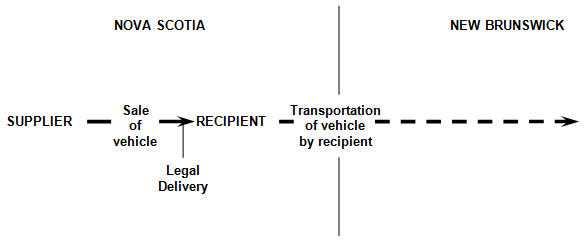
The supply of the vehicle would be deemed under the new rule to be made in New Brunswick because the vehicle is registered in New Brunswick on behalf of the recipient within seven days after the date of delivery of the vehicle to the recipient in Nova Scotia. The dealer would therefore collect HST at a rate of 13% in respect of the supply of the vehicle.
Example 12
An automobile dealer located in Ontario sells a specified motor vehicle to a recipient who is resident in Quebec. The recipient takes delivery of the vehicle in Ontario at the location of the dealership and subsequently drives it to Quebec. Ten days later, the recipient registers the vehicle in Quebec.
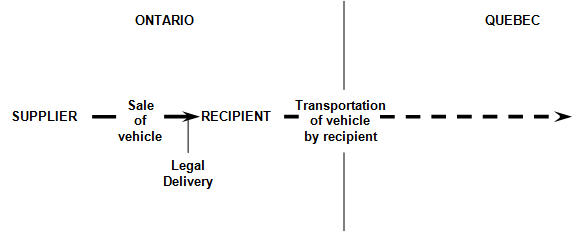
Delivery of the vehicle to the recipient occurs in Ontario. Although the vehicle is registered in Quebec by the recipient, the new rule would not apply since the vehicle was not registered within seven days after the date of delivery of the vehicle to the recipient in Ontario. The supply of the vehicle is therefore made in Ontario and the dealer is required to collect HST at 13% in respect of the supply. The recipient would be eligible for a rebate of the 8% Ontario part of the HST that the recipient paid to the dealer (for further information, see GST/HST Info Sheet G-119, Harmonized Sales Tax – New Place of Supply Rule for Sales of Specified Motor Vehicles and Form GST495, Rebate Application for Provincial Part of Harmonized Sales Tax (HST ) .
Example 13
An automobile dealer located in Alberta sells a specified motor vehicle to a recipient who is resident in British Columbia. Delivery of the vehicle to the recipient occurs in Alberta at the location of the dealership. Before delivery of the vehicle to the recipient in Alberta, the recipient registers the vehicle in British Columbia and provides the dealer with a copy of the registration. The recipient subsequently drives the vehicle to British Columbia.
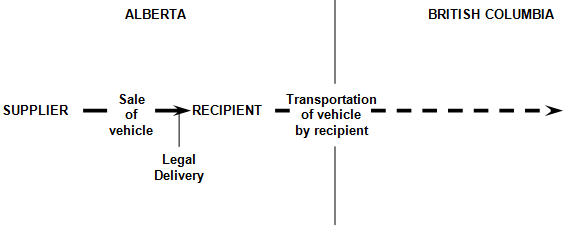
Because delivery of the vehicle to the recipient occurs in Alberta, a non-participating province, the new rule would not apply. The supply of the vehicle is deemed under the general place of supply rule to be made in Alberta. The dealer is therefore required to collect GST at a rate of 5% in respect of the supply. The recipient is required to pay the 7% British Columbia part of the HST to the provincial motor vehicle registration authority in British Columbia upon registering the vehicle in British Columbia.
Example 14
An automobile dealer located in British Columbia sells a specified motor vehicle to a recipient who is resident in British Columbia. Delivery of the vehicle to the recipient occurs in British Columbia at the location of the dealership. Before delivery of the vehicle to the recipient in British Columbia, the dealer registers the vehicle in British Columbia on behalf of the recipient.

Because delivery of the vehicle to the recipient occurs in British Columbia, the same participating province in which the vehicle is registered, the new rule would not apply. The supply of the vehicle is deemed under the general place of supply rule to be made in British Columbia. The dealer is therefore required to collect HST at a rate of 12% in respect of the supply.
Example 15
An automobile dealer located in Quebec sells a specified motor vehicle to a recipient who is resident in Ontario. The Quebec dealer agrees to ship the vehicle to the recipient in Ontario. Before delivery of the vehicle to the recipient in Ontario, the dealer registers the vehicle in Ontario on behalf of the recipient.
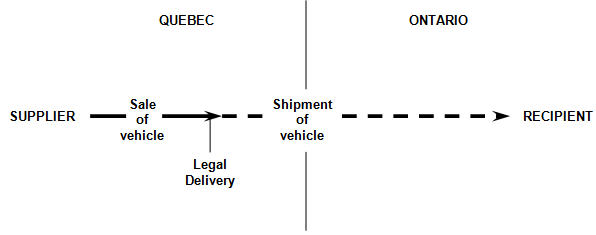
Because delivery of the vehicle to the recipient occurs in Ontario, the same participating province in which the vehicle is registered, the new rule would not apply. The supply of the vehicle is deemed under the general place of supply rule to be made in Ontario. The dealer is therefore required to collect HST at a rate of 13% in respect of the supply.
Example 16
An automobile dealer located in Ontario sells a specified motor vehicle to a recipient who is resident in Nova Scotia. The recipient takes delivery of the vehicle in Ontario at the location of the dealership. The dealer collects HST at a rate of 13% in respect of the supply of the vehicle. After taking delivery of the vehicle at the dealership, the recipient drives the vehicle to Nova Scotia the same day. The following day, the recipient registers the vehicle in Nova Scotia. The dealer does not obtain any evidence of the registration of the vehicle in Nova Scotia.
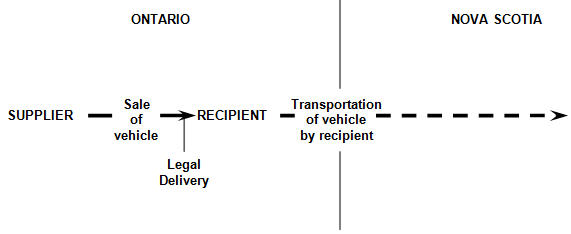
Although the vehicle is registered in Nova Scotia within seven days after the date of delivery of the vehicle to the recipient in Ontario, the new place of supply rule would not apply in this case since the dealer does not maintain any evidence of that registration. As a result, because delivery of the vehicle to the recipient occurs in Ontario, the supply is made in that province and the supplier is required to collect HST at a rate of 13% in respect of the supply. Upon registering the vehicle in Nova Scotia, the recipient will be required to pay HST to the provincial motor vehicle registration authority in Nova Scotia calculated based on a rate of 2% (10% Nova Scotia provincial rate – 8% Ontario provincial rate).
Appendix B includes a table that provides an overview of the application of the provincial part of the HST to sales of vehicles in various circumstances, including those in which the new administrative place of supply rule has been applied by the supplier. For further information, see GST/HST Info Sheet GI-119, Harmonized Sales Tax – New Place of Supply Rule for Sales of Specified Motor Vehicles.
Tangible personal property supplied otherwise than by way of sale
The place of supply rules for tangible personal property supplied otherwise than by way of sale have not changed.
Deemed supply of tangible personal property
(Subsection 136(1))
A supply, by way of lease, licence or similar arrangement, of the use or right to use tangible personal property is deemed to be a supply of tangible personal property.
Period of more than three months – Specified motor vehicle
(Subparagraph 2(b)(i) of Part II of Schedule IX)
A specified motor vehicle is defined to mean a vehicle that is, or that would be, if it were imported, classified under certain tariff items in Schedule I to the Customs Tariff. Generally, this includes almost all motor vehicles, other than racing cars classified under tariff heading number 87.03, and any prescribed motor vehicles.
A supply of a specified motor vehicle otherwise than by way of sale under an arrangement under which continuous possession or use of the vehicle is provided for more than three months is deemed to be made in a province if the vehicle is required to be registered under the laws of the province relating to the registration of motor vehicles at the time the supply is made.
Lease intervals – Deemed supplies of tangible personal property
(Subsection 136.1(1))
Where a supply of property is made by way of lease, licence or similar arrangement for consideration that is attributable to a period (referred to as a "lease interval") that is the whole or a part of the period during which possession or use of the property is provided under the arrangement, a separate supply of the property for separate consideration is deemed to be made by the supplier and received by the recipient for each lease interval. The supply for each lease interval is deemed to be made on the earliest of
- the first day of the lease interval,
- the day on which the lease payment attributable to that interval becomes due, and
- the day that payment is made.
The separate supplies of tangible personal property that are deemed to be made for each lease interval can be subject to HST at a different rate to the extent that those supplies can be deemed to be made in a different province based on the application of the place of supply rules for tangible personal property supplied otherwise than by way of sale. Therefore, the province in which a supply of a specified motor vehicle for each lease interval is made and the applicable rate of tax can vary based on the province in which the vehicle is required to be registered at a particular time.
Example 17
A car leasing company located in Ontario leases a vehicle to a person pursuant to a two-year lease requiring monthly lease payments. The lessee picks up the vehicle at the supplier's premises in Ontario and the vehicle is required to be registered in Ontario throughout the lease.

The supplies of the vehicle that relate to each of the lease payments are made in Ontario and are subject to HST at a rate of 13% because the vehicle is required to be registered in Ontario throughout the lease.
Example 18
A car leasing company located in British Columbia leases a vehicle to a person pursuant to a four-year lease requiring monthly lease payments. The lessee picks the vehicle up at the dealer's location in British Columbia and is required to register the vehicle in British Columbia at that time. At the end of the fourth month of the first year of the lease, the lessee moves to Ontario and is required to register the vehicle in Ontario.
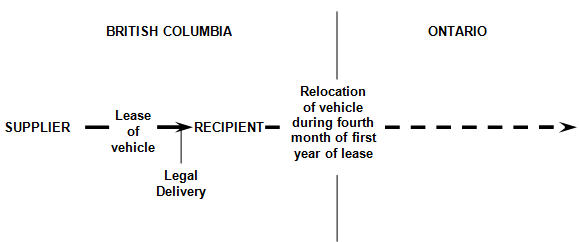
The supplies of the vehicle that relate to each of the lease payments for the first four months of the lease are made in British Columbia and are subject to HST at a rate of 12% because the vehicle is required to be registered in British Columbia at the beginning of those lease intervals. The supplies of the vehicle that relate to each of the lease payments for the remaining months of the lease are made in Ontario and are subject to HST at a rate of 13% because the vehicle is required to be registered in Ontario at the beginning of those lease intervals.
Period of more than three months – Tangible personal property (other than a specified motor vehicle)
(Subparagraph 2(b)(ii) of Part II of Schedule IX)
A supply of tangible personal property (other than a specified motor vehicle) by way of lease, licence or similar arrangement for more than three months is deemed to be made in a province if the ordinary location of the property, as determined at the time the supply is made, is in the province. Again, a separate supply of the property is deemed to be made for each lease interval on the earliest of
- the first day of the lease interval,
- the day on which the lease payment attributable to that interval becomes due, and
- the day that payment is made.
Ordinary location of property
(Section 4 of Part I of Schedule IX)
For purposes of the place of supply rules, the ordinary location of property is deemed to be the location where the supplier and the recipient mutually agree that the ordinary location of the property is to be at a particular time. In other words, the mutual agreement of the supplier and recipient is determinative even where the property is actually located at a different place at the relevant time from what had been agreed upon. The mutual agreement of the parties may change from time to time. Therefore, even if the original written agreement for a supply of property specified that the property would be located in a particular province, the parties may mutually agree subsequent to the signing of the contract that the property is to be moved at a particular time to a location in another province. In this case, the latter location would be the ordinary location of the property at that particular time.
Example 19
Pursuant to a five-year lease, a national leasing company based in Quebec leases equipment to a construction company operating in Ontario. The monthly lease payments are due and paid at the beginning of each month. The construction company takes delivery of the equipment in Ontario. The equipment is usually stored and maintained at the construction company's facilities in Ontario. However, at the end of the last month of the third year of the lease, the construction company expands its operations to Quebec and, with the agreement of the Quebec company, the equipment is relocated to the company's new facilities in Quebec.
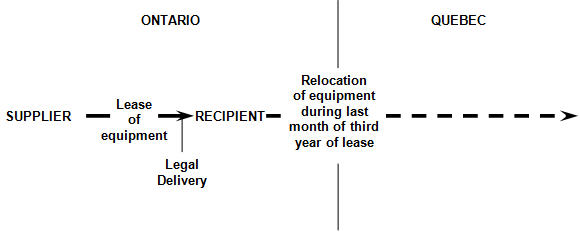
The supply of the leased equipment is made in Canada since the construction company is given possession of the equipment in Ontario. A supply of the equipment is deemed to be made for each lease interval. In this case, the supplies of the equipment to which the lease payments for the first three years relate are made in Ontario and are subject to HST at a rate of 13% since the equipment is ordinarily located in Ontario during that time. The supplies of the equipment to which the lease payments relate for the remaining two years are made in Quebec and subject to GST at a rate of 5% since the equipment is ordinarily located in Quebec during that time.
Period of three months or less
(Paragraph 2(a) of Part II of Schedule IX)
A supply of tangible personal property otherwise than by way of sale under an arrangement under which continuous possession or use of the property is provided for a period of no more than three months is deemed to be made in the province in which the supplier delivers the property or makes it available to the recipient of the supply.
Deemed delivery
(Section 3 of Part II of Schedule IX)
This place of supply rule is generally based on the province in which legal delivery of the property to the recipient occurs. However, for purposes of this rule, tangible personal property is also deemed to be delivered in a particular province, and not in any other province, if the supplier either:
- ships the property to a destination in the particular province that is specified in the contract for carriage of the property;
- transfers possession of the property to a common carrier or consignee that the supplier has retained on behalf of the recipient to ship the property to such a destination; or
- sends the property by mail or courier to an address in the particular province.
Single determination of place of supply based on initial delivery
(Section 4 of Part II of Schedule IX)
The province in which the supply of tangible personal property is made in the case of a lease, licence or similar arrangement of three months or less is determined only once based on the initial delivery of the property and does not change for subsequent lease intervals, if any, under the arrangement.
Example 20
A consumer rents and takes possession of a vehicle in British Columbia to use while travelling on a trip throughout Canada. The rental agreement is for a one-month period.

The lease of the vehicle to the consumer is made in British Columbia and is subject to HST at a rate of 12% because the consumer is leasing the vehicle for a period that does not exceed three months and takes delivery of the vehicle in British Columbia.
Railway rolling stock supplied otherwise than by way of sale
(Section 26 of Part 1 of the Regulations)
The place of supply rules for a supply of railway rolling stock otherwise than by way of sale have not changed.
Rule 1
A supply of railway rolling stock otherwise than by way of sale is made in a province if the supplier delivers the rolling stock or makes it available to the recipient of the supply in that province.
This place of supply rule is generally based on the province in which legal delivery of the rolling stock to the recipient occurs. However, for purposes of the rule, the rolling stock is also deemed to be delivered in a particular province, and not in any other province, if the supplier ships the rolling stock to a destination in the province that is specified in the contract for carriage of the rolling stock or transfers possession of the rolling stock to a common carrier or consignee that the supplier has retained on behalf of the recipient to ship the rolling stock to such a destination.
Rule 2
Despite Rule 1, the province in which the supply of the rolling stock is determined to be made for the first lease interval is the province in which all supplies of the rolling stock for subsequent lease intervals are deemed to be made.
Rule 3
Subject to Rule 4 and Rule 5, if continuous possession or use of railway rolling stock is given by a supplier to a recipient throughout a period under two or more successive leases, licenses or similar arrangements entered into between the supplier and the recipient (i.e., where the arrangement is renewed), the rolling stock is deemed to have been delivered or made available to the recipient under each of those arrangements at the location at which it is delivered or made available to the recipient under the first of those arrangements.
Rule 4
A special transitional rule applies where a supply of railway rolling stock is made under a particular lease agreement that is in effect on April 1, 1997, and under the particular agreement, the rolling stock was delivered or made available to the recipient before that day. In this case,
- the rolling stock is deemed to have been delivered or made available to the recipient under the particular agreement outside the participating provinces; and
- if the recipient retains continuous possession or use of the rolling stock under an agreement (the "renewal agreement") with the supplier that immediately succeeds the particular agreement, Rule 3 applies as if the renewal agreement were the first arrangement between the supplier and the recipient for the supply of the rolling stock.
Rule 5
A special transitional rule applies where a supply of railway rolling stock is made under a particular lease agreement that is in effect on July 1, 2010, and under the particular agreement, the rolling stock was delivered or made available to the recipient in Ontario or British Columbia before that day. In this case,
- the rolling stock is deemed to have been delivered or made available to the recipient under the particular agreement outside the participating provinces; and
- if the recipient retains continuous possession or use of the rolling stock under an agreement (the "renewal agreement") with the supplier that immediately succeeds the particular agreement, Rule 3 applies as if the renewal agreement were the first arrangement between the supplier and the recipient for the supply of the rolling stock.
Example 21
A company in Ontario enters into a lease agreement to supply a railway car to a company in Quebec. The Quebec company takes delivery of the railway car in Ontario.

The supply of the railway car throughout the period covered by the lease is made in Ontario because the railway car is delivered to the recipient in Ontario. As a result, the lease payments for the railway car are subject to HST at a rate of 13%.
Real property
(Section 1 of Part IV of Schedule IX)
The place of supply rule for supplies of real property has not changed. A supply of real property is deemed to be made in a province if the property is situated in the province.
Deemed supply of real property
(Subsection 136(1))
A supply, by way of lease, licence or similar arrangement, of the use or right to use real property is deemed to be a supply of real property.
Supply of real property partly in a province
(Section 136.2)
For purposes of determining in which participating province, if any, a taxable supply of real property is made and determining the provincial part of the HST payable, if any, in respect of the supply, a deeming rule applies where the supply of real property includes the provision of real property that is partly situated in a particular province and partly in one or more other provinces or outside Canada. In this case, the provision of the part of the real property that is situated in the particular province and the provision of the part of the real property that is situated in the other province or outside Canada are each deemed to be a separate taxable supply made for separate consideration equal to the portion of the total consideration for all the property that is reasonably attributable to each part of the real property. As a result, it is only the provision of the part of the real property that is situated in the participating provinces that is subject to HST.
A purported single supply of real property that is situated in a particular province and in one or more other provinces or outside Canada may, in fact, be separate supplies of real property—a supply of real property made in the particular province and a separate supply of real property made in each other province or outside Canada.
Example 22
A company based in Ontario sells one of its warehouses that is situated in Ontario to a company in British Columbia.
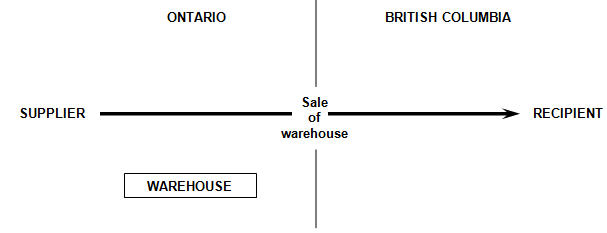
The sale of the warehouse is made in Ontario and is subject to HST at a rate of 13%.
Example 23
A company in Quebec sells taxable commercial real property to an Ontario company. The real property is situated in Ontario and Quebec.
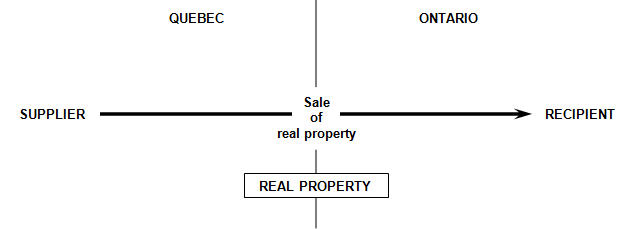
The provision of each part of the real property is deemed to be a separate supply for consideration equal to the portion of the total consideration for all the property that is reasonably attributable to the part that is situated in each province. The supply of the part of the real property that is situated in Ontario is therefore made in Ontario and is subject to HST at a rate of 13%. The supply of the part of the real property that is situated in Quebec is therefore made in Quebec and subject to GST at a rate of 5%.
Example 24
A builder in Ontario is selling a new home in Ontario for $1,000,000 to a purchaser in Manitoba. The same builder owns 20 acres of land in Manitoba worth $10,000. The builder makes a single supply of granting an option to the purchaser for $101,000 (10% of the total purchase price) to purchase both the Ontario home and the Manitoba land for $1,010,000. The purchaser may exercise the option to purchase the two properties anytime within five years of the date the option is granted.
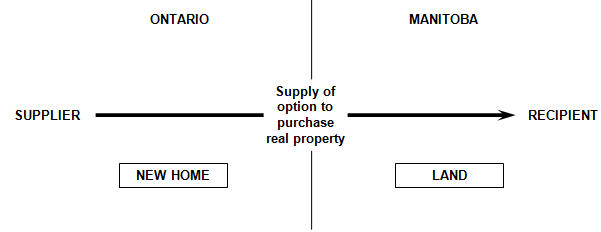
The supply of an option to purchase real property is considered to be a supply of real property for GST/HST purposes. The supply of the option to purchase the two properties is therefore a taxable supply of real property. Since the properties are situated in more than one province, the supply of the real property is deemed to be two separate supplies made for separate consideration. HST at 13% applies to $100,000 which is reasonably attributable to the deemed supply of the option to purchase the home in Ontario, and GST at 5% applies to $1,000 which is reasonably attributable to the deemed supply of the option to purchase the Manitoba land.
Lease intervals – Deemed supplies of real property
(Subsection 136.1(1))
Where a supply of property is made by way of lease, licence or similar arrangement for consideration that is attributable to a period (referred to as a "lease interval") that is the whole or a part of the period during which possession or use of the property is provided under the arrangement, a separate supply of the property for separate consideration is deemed to be made by the supplier and received by the recipient for each lease interval. The supply for each lease interval is deemed to be made on the earliest of
- the first day of the lease interval,
- the day on which the lease payment attributable to that interval becomes due, and
- the day that payment is made.
Example 25
Pursuant to a lease agreement, a company in New Brunswick leases a commercial office building situated in New Brunswick to a company in Ontario for a period of ten years.

Intangible personal property
(Division 2 of Part 1 of the Regulations)
Overview
The place of supply rules for supplies of intangible personal property have changed significantly. Although the general rules continue to be based on the location where the rights may be used, some of these rules are now also generally based on the home or business address of the recipient (or another address of the recipient) in Canada that the supplier obtains in the ordinary course of its business. However, the general rules are subject to specific place of supply rules that can apply to certain types of intangible personal property.
Where the specific place of supply rules do not determine the place of supply of a particular type of intangible personal property because the conditions for the application of those rules are not met, it is the general place of supply rules that determine the place of supply of the intangible personal property. For example, there are specific place of supply rules for supplies of intangible personal property that are, or are similar to, passenger transportation passes that entitle an individual to passenger transportation services. However, where it is not possible to determine the place of supply of the intangible personal property that is a passenger transportation pass under the specific rules for such supplies (which for example can be the case due to a lack of restrictions regarding the place where the intangible personal property may be used), the place of supply are determined under the general place of supply rules.
Note: Appendix C contains a flow chart that summarizes the place of supply rules for supplies of intangible personal property.
Exceptions
(Section 5 of Division 2 of Part 1 of the Regulations)
The place of supply rules explained in this section do not apply to supplies of intangible personal property to which the specific place of supply rules for postage (Part VII of Schedule IX) and telecommunication services (Part VIII of Schedule IX) apply.
Intangible personal property – General rules
(Sections 6, 7, 8 and 11 of Division 2 of Part 1 of the Regulations)
There are four general place of supply rules that apply to supplies of intangible personal property that can be summarized as follows:
- Supplies of intangible personal property that can be used in Canada that can only be used primarily Footnote 1 outside the participating provinces are deemed to be made in a non-participating province and subject to GST.
- Supplies of intangible personal property that can be used in Canada that can only be used primarily in the participating provinces are deemed to be made in a participating province and subject to HST.
- The place of supply for supplies of intangible personal property that can be used in Canada and can be used other than only primarily in the participating provinces and other than only primarily outside the participating provinces depends on a number of additional factors.
- Another rule applies where the above rules do not apply because two or more relevant participating provinces have the same highest rate for the provincial part of the HST (the "tax rate").
Exceptions
(Sections 9 and 10 of Division 2 and section 22 of Division 4 of Part 1 of the Regulations)
The general place of supply rules for intangible personal property do not apply to supplies of intangible personal property that relate to real property or tangible personal property. Also, they are subject to specific place of supply rules that apply to certain supplies of intangible personal property that are, or are similar to, passenger transportation passes entitling an individual to one or more passenger transportation services.
The general place of supply rules can require a determination of the extent, if any, to which the use of the Canadian rights Footnote 2 is limited to one or more provinces. The terms of the agreement for the supply governing the use of the rights generally determine the extent, if any, to which the rights can be used in one or more provinces. The use of the rights may be limited to one or more provinces by the nature of the rights being supplied without such a restriction being explicitly stated in the terms of the agreement. For instance, if as a matter of fact, the right that is supplied could only ever be used from a single location in a single province, then the use of the right would be considered to be limited to that province regardless of whether this is explicitly stated in the terms of the agreement. If there are no limitations with respect to the province in which the rights can be used and it is possible for those rights to be used in a particular province, then the rights can be, but are not limited to being, used in that particular province.
General rule 1 – Intangible personal property that can only be used primarily in non-participating provinces
(Section 7 of Division 2 of Part 1 of the Regulations)
A supply of intangible personal property in respect of which the Canadian rights can only be used primarily in non-participating provinces is made in a non-participating province.
Example 26
An individual in Alberta purchases a theatre pass that provides the right to attend seven plays in Alberta and three plays in British Columbia from a supplier in Alberta.
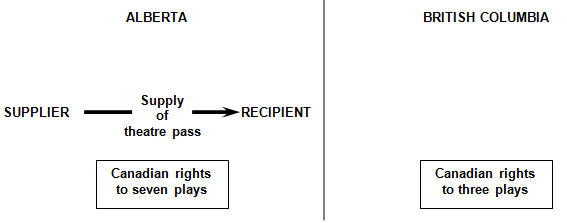
The supply is made in a non-participating province since the intangible personal property can only be used primarily in Alberta. Therefore, the supply is subject to GST at a rate of 5%.
General rule 2 – Intangible personal property that can only be used primarily in participating provinces
(Section 6 of Division 2 of Part 1 of the Regulations)
Rule 2A – Intangible personal property that can only be used primarily in participating provinces with province of primary use
(Subsection 6(1) of Division 2 of Part 1 of the Regulations)
If the Canadian rights in respect of a supply of intangible personal property can only be used primarily in the participating provinces, the supply is made in a participating province if an equal or greater proportion of the Canadian rights cannot be used in another participating province.
This rule applies where the Canadian rights can only be used primarily in the participating provinces and the province in which the greatest proportion of those rights can be used can be determined because the use of at least some of those rights is specifically limited to one or more of those provinces. This rule does not apply if the use of the rights is not specifically limited to one or more of the participating provinces, which would be the case, for example, if the rights can be used on an unlimited basis in more than one of those provinces.
Example 27
A supplier in Ontario supplies software by way of licence to a company in Ontario for use by its employees at its head office in Ontario. The software is downloaded electronically over the Internet. The licence provides that the software can only be used from the head office of the Ontario company.
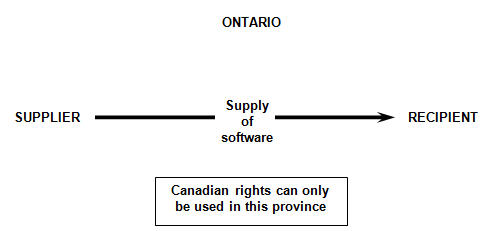
The Canadian rights in respect of the software can only be used primarily in participating provinces and an equal or greater proportion of the Canadian rights cannot be used in a participating province other than Ontario. Therefore, the supply of the intangible personal property is made in Ontario and subject to HST at a rate of 13%.
Example 28
A franchise company in British Columbia supplies a franchise to a British Columbia company that provides the right to operate a franchise retail business in Ontario.
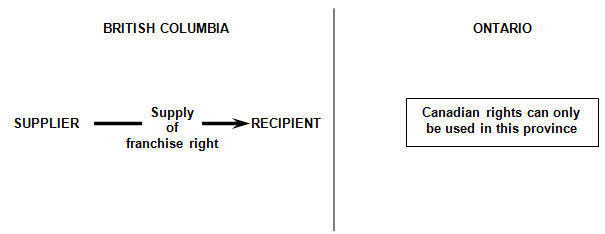
The Canadian rights in respect of the franchise can only be used primarily in participating provinces and an equal or greater proportion of the Canadian rights cannot be used in a participating province other than Ontario. Therefore, the supply of the intangible personal property is made in Ontario and subject to HST at a rate of 13%.
Example 29
An individual purchases a pass in Ontario that entitles the individual to admission to three plays at a theatre in Ontario.
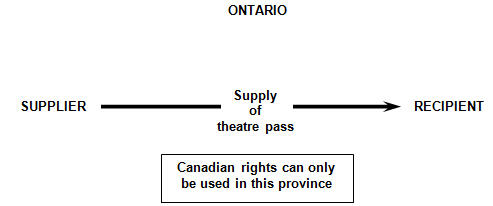
The Canadian rights in respect of the pass can only be used primarily in participating provinces and an equal or greater proportion of the Canadian rights cannot be used in a participating province other than Ontario. Therefore, the supply of the intangible personal property is made in Ontario and subject to HST at a rate of 13%.
Example 30
An individual purchases a pass in Ontario that entitles the individual to admission to two plays at two theatres in Ontario and to admission to one play at a theatre in British Columbia.

The Canadian rights in respect of the pass can only be used primarily in participating provinces and an equal or greater proportion of the Canadian rights cannot be used in a participating province other than Ontario. Therefore, the supply of the intangible personal property is made in Ontario and subject to HST at a rate of 13%.
Generally, four rules apply where the Canadian rights in respect of a supply of intangible personal property can only be used primarily in participating provinces, but Rule 2A does not apply because it is not possible to determine the participating province in which the greatest proportion of those rights can be used. This would be the case where there are no limitations with respect to the extent to which the rights can be used in any of those provinces.
Rule 2B – Intangible personal property that can only be used primarily in participating provinces with no province of primary use
(Subsection 6(2) and section 11 of Division 2 of Part 1 of the Regulations)
If the value of the consideration for the supply of the intangible personal property is $300 or less, the supply is made in a participating province if:
- the supply is made through a "specified location" of the supplier (a permanent establishment of the supplier or a vending machine) located in the province in the presence of an individual who is, or who acts on behalf of, the recipient, and
- the intangible personal property can be used in the province.
Permanent establishment
(Subsections 132.1(2) and (3))
Subsection 132.1(2) generally defines "permanent establishment" for the purposes of section 132.1 and Schedule IX. The definition relies on the meanings assigned to "permanent establishment" under certain provisions of the Income Tax Regulations. The definition also relies on the definition of "business" under subsection 248(1) of the Income Tax Act, which is defined to mean a profession, calling, trade, manufacture or any undertaking and generally an adventure or concern in the nature of trade, but does not include an office or employment.
In the case of an individual, the estate of a deceased individual or a trust that carries on a business, the meaning of "permanent establishment" is as defined for purposes of Part XXVI of the Income Tax Regulations. It therefore includes a fixed place of business of the individual including an office, a branch, a mine, an oil well, a farm, a timberland, a factory, a workshop, or a warehouse. Also, if an individual carries on business through an employee or agent, established in a particular place, who has general authority to contract for his employer or principal or who has a stock of merchandise owned by his employer or principal from which he regularly fills orders which he receives, the individual is deemed to have a permanent establishment in that place. If an individual uses substantial machinery or equipment in a particular place at any time in a taxation year, the individual is deemed to have a permanent establishment in that place. For purposes of this definition, the fact that an individual has business dealings through a commission agent, broker or other independent agent or maintains an office solely for the purchase of merchandise, does not on its own mean that the individual has a permanent establishment.
The same definition under Part XXVI of the Income Tax Regulations also applies with respect to the permanent establishment of a member of a partnership, where the member is an individual, the estate of a deceased individual or a trust, and the establishment relates to a business carried on through the partnership.
In the case of a corporation that carries on a business, the meaning of "permanent establishment" is as defined under Part IV of the Income Tax Regulations. It therefore includes a fixed place of business of the corporation, including an office, a branch, a mine, an oil well, a farm, a timberland, a factory, a workshop, or a warehouse. Also,
- where the corporation does not have any fixed place of business, it means the principal place in which the corporation's business is conducted;
- where a corporation carries on business through an employee or agent, established in a particular place, who has general authority to contract for his employer or principal or who has a stock of merchandise owned by his employer or principal from which he regularly fills orders which he receives, the corporation is deemed to have a permanent establishment in that place;
- an insurance corporation is deemed to have a permanent establishment in each province and country in which the corporation is registered or licensed to do business;
- where a corporation, otherwise having a permanent establishment in Canada, owns land in a province, such land is deemed to be a permanent establishment;
- where a corporation uses substantial machinery or equipment in a particular place at any time in a taxation year, it is deemed to have a permanent establishment in that place;
- if, but for this bullet, a corporation would not have a permanent establishment, the corporation is deemed to have a permanent establishment at the place designated in its incorporating documents or bylaws as its head office or registered office;
- the fact that a corporation has business dealings through a commission agent, broker or other independent agent or maintains an office solely for the purchase of merchandise shall not on its own mean that the corporation has a permanent establishment; and
- the fact that a corporation has a subsidiary controlled corporation in a place or a subsidiary-controlled corporation engaged in trade or business in a place does not on its own mean that the corporation is operating a permanent establishment in that place.
The same definition under Part IV of the Income Tax Regulations also applies with respect to the permanent establishment of a member of a partnership, where the member is a corporation and the establishment relates to a business carried on by the partnership.
Where a member of a particular partnership is also a partnership, the permanent establishment of the member is determined by the other rules under subsection 132.1(2), provided the establishment relates to a business carried on by the particular partnership.
Finally, under subsection 132.1(2), where a person's permanent establishment cannot be determined using the rules above, the meaning of "permanent establishment" of the person is as defined under Part IV of the Income Tax Regulations as if the person were a corporation and its activities were a business for purposes of the Income Tax Act.
Subsection 132.1(3) provides that a prescribed person, or a person of a prescribed class, is deemed, under prescribed circumstances and for prescribed purposes, to have a permanent establishment in a prescribed province. Under subsection 2(1) of the New Harmonized Value-Added Tax System Regulations No. 2, the classes of persons that are prescribed for purposes of subsection 132.1(3) are:
- charities;
- non-profit organizations; and
- selected public service bodies as defined in section 259.
"Selected public service body" is defined in section 259 to mean:
- a school authority, a university or a public college that is established and operated otherwise than for profit;
- a hospital authority;
- a municipality;
- a facility operator; or
- an external supplier.
Under subsection 2(2) of Part 1 of the New Harmonized Value-Added Tax System Regulations No. 2, such a person is deemed to have a permanent establishment in a province if a place in the province would be a permanent establishment (as defined for the purposes of Part IV of the Income Tax Regulations) of the person under the following circumstances:
- the person were a corporation; and
- the person's activities were a business for the purposes of the Income Tax Act.
Example 31
A regional fitness club with facilities situated throughout New Brunswick and Nova Scotia supplies fitness memberships to individuals for a single fee of less than $300 for a six-month membership to the club. The membership entitles members to: unlimited access to all club facilities, exercise classes, access to nutritional and fitness seminars, a towel service and a one-time fitness evaluation. A student from New Brunswick attending university in Halifax, Nova Scotia acquires a six-month membership to the fitness club at the membership desk at the club's facility that is closest to the university in Halifax. The student provides his permanent address in New Brunswick as his home address.
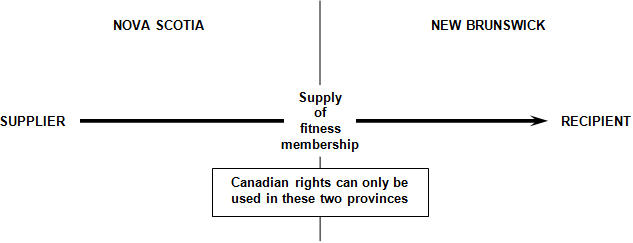
The Canadian rights in respect of the membership can only be used primarily in the participating provinces. Also, the supply is made through a permanent establishment of the supplier in Nova Scotia in the presence of the recipient and the intangible personal property can be used in Nova Scotia. Therefore, the supply of the intangible personal property is made in Nova Scotia and subject to HST at a rate of 15%.
Example 32
An individual purchases a movie pass that provides ten adult admissions to any of a movie chain's five cinemas situated in Nova Scotia and New Brunswick. The individual purchases the pass for less than $300 at one of the chain's New Brunswick locations.
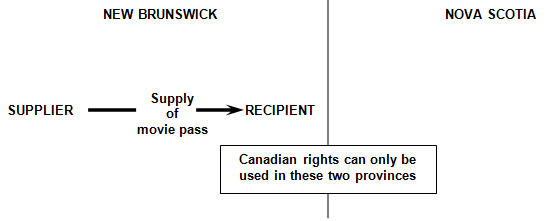
The Canadian rights in respect of the movie pass can only be used primarily in the participating provinces. Also, the supply is made through a permanent establishment of the supplier in New Brunswick in the presence of the recipient and the pass can be used in New Brunswick. Therefore, the supply of the intangible personal property is made in New Brunswick and subject to HST at a rate of 13%.
Rule 2C – Address in Canada obtained
(Paragraph 6(2)(b) of Division 2 of Part 1 of the Regulations)
If Rule 2B does not deem the supply to be made in a participating province, the supply may be deemed to be made in a participating province if the supplier obtains an address of the recipient in the province in the ordinary course of business. Specifically, the supply of the intangible personal property is made in a participating province if:
- in the ordinary course of business of the supplier, the supplier obtains an address that is
- if the supplier obtains only one address that is a home or business address in Canada of the recipient, the home or business address in Canada of the recipient obtained by the supplier,
- if the supplier obtains more than one such address, the home or business address in Canada of the recipient that is most closely connected with the supply, or
- in any other case, the address in Canada of the recipient that is most closely connected with the supply;
- the address is in the province; and
- the intangible personal property can be used in the province.
For an explanation of how to determine the relevant address of the recipient for purposes of this rule, see the explanation under General Rule 1 of the general place of supply rule for services explained below.
Example 33
A supplier in Ontario supplies software by way of licence to a company in Newfoundland and Labrador for use by its employees at its offices in Newfoundland and Labrador and New Brunswick. The software is downloaded electronically over the Internet. The licence provides that the software may only be used from the offices of the recipient in Newfoundland and Labrador and New Brunswick. In the ordinary course of its business, the supplier only obtains a business address of the recipient that is in Newfoundland and Labrador and that is also the billing address for the supply.
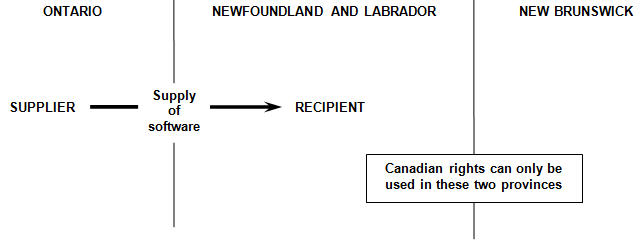
The Canadian rights in respect of the software can only be used primarily in the participating provinces. Also, in the ordinary course of its business, the supplier only obtains a business address of the recipient that is in Newfoundland and Labrador. Therefore, the supply is made in Newfoundland and Labrador and subject to HST at a rate of 13%.
Example 34
An individual in Nova Scotia purchases an air transportation pass over the Internet from a supplier in Ontario that provides him with unlimited travel between Nova Scotia and Ontario. The only address of the individual obtained by the supplier in the ordinary course of its business is the home address of the individual in Nova Scotia.
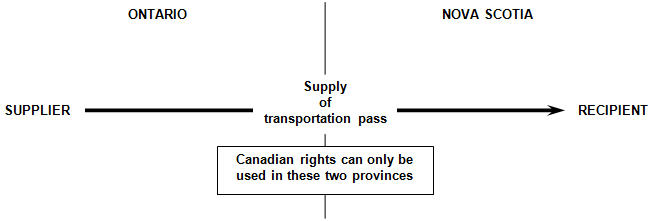
The Canadian rights in respect of the pass can only be used primarily in the participating provinces and, in the ordinary course of its business, the supplier only obtains a home address of the recipient that is in Nova Scotia. Therefore, the supply is made in Nova Scotia and subject to HST at a rate of 15%.
Example 35
Assume that the facts in this example are the same as in Example 31. The memberships to the fitness club are subject to an automatic six-month renewal upon expiration of the original membership. The renewal fee that is less than $300 is automatically billed to the student's credit card with confirmation sent by mail to the home address on file in New Brunswick.
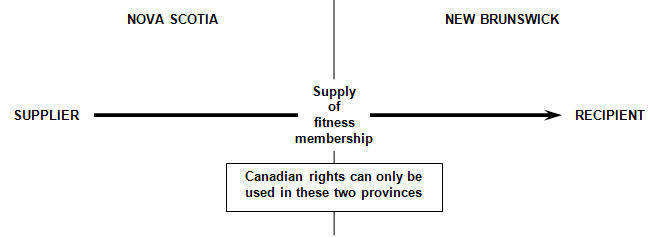
The Canadian rights in respect of the membership can only be used primarily in the participating provinces. Also, in the ordinary course of business, the supplier only obtains a home address of the recipient that is in New Brunswick. Therefore, the supply is made in New Brunswick and subject to HST at a rate of 13%.
Rule 2D – Highest tax rate
(Paragraph 6(2)(c) of Division 2 of Part 1 of the Regulations)
If the supply of intangible personal property is not deemed to be made in a participating province under Rule 2B or Rule 2C, the supply is made in the participating province for which the tax rate is the highest among the tax rates for the participating provinces in which the property can be used.
If a supply of intangible personal property cannot be determined under Rule 2D to be made in a single participating province because the highest tax rates for two or more participating provinces are the same, see General Rule 4 below.
Example 36
A company in British Columbia supplies a Quebec company with intellectual property rights that can only be used in British Columbia and Ontario. The business address of the recipient obtained by the British Columbia company in the ordinary course of business is in Quebec.
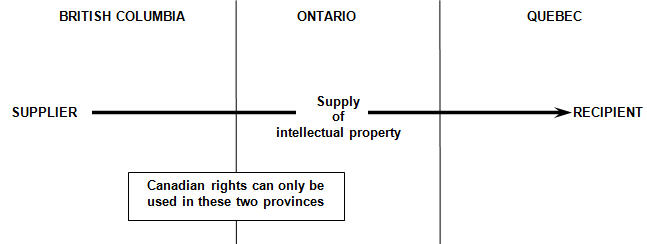
The Canadian rights in respect of the intellectual property rights can only be used primarily in participating provinces. Although the supplier obtains a business address of the recipient, that address is in Quebec, a province in which the intellectual property rights cannot be used. The supply of the intangible personal property is made in the participating province that has the highest tax rate among the participating provinces in which the intangible personal property can be used, which in this case is Ontario. Therefore, the supply is subject to HST at a rate of 13%.
Example 37
An individual in New Brunswick purchases an air transportation pass over the Internet from a supplier in Ontario that provides the individual with unlimited travel between Nova Scotia and Ontario. The individual's home address obtained by the supplier in the ordinary course of business is in New Brunswick.
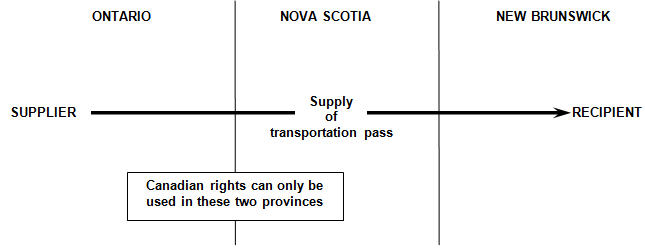
The supply is made in the participating province that has the highest tax rate among the participating provinces in which the intangible personal property can be used, which in this case is Nova Scotia. Therefore, the supply is subject to HST at a rate of 15%.
General Rule 3 – Intangible personal property that can be used otherwise than only primarily in participating provinces and otherwise than only primarily outside participating provinces
(Section 8 of Division 2 of Part 1 of the Regulations)
Generally, three rules apply where the Canadian rights in respect of a supply of intangible personal property can be used otherwise than only primarily Footnote 3 in participating provinces and otherwise than only primarily outside participating provinces. Basically, these rules can apply where the Canadian rights in respect of the property are not limited to being used only primarily in the participating provinces or to being used only primarily outside the participating provinces. Also, these rules can result in the supply of intangible personal property being deemed to be made in a province that is not a participating province.
Rule 3A – Consideration of $300 or less
(Paragraph 8(a) of Division 2 of Part 1 of the Regulations)
If the value of the consideration for the supply of the intangible personal property is $300 or less, the supply is made in a province if:
- the supply is made through a specified location of the supplier (a permanent establishment of the supplier or vending machine) located in the province in the presence of an individual who is, or who acts on behalf of, the recipient; and
- the intangible personal property can be used in the province.
Example 38
An individual purchases a movie pass that provides ten adult admissions to any of a popular movie chain's locations. The chain has at least one location in every Canadian province. The individual purchases the pass at a cost of $80 at one of the chain's Ontario locations.

The Canadian rights in respect of the movie pass can be used less than primarily in the participating provinces and less than primarily outside the participating provinces. Also, the supply of the intangible personal property is made in the presence of the recipient through a permanent establishment of the supplier that is in Ontario and the intangible personal property can be used in Ontario. Therefore, the supply of the intangible personal property is made in Ontario and subject to HST at a rate of 13%.
Example 39
An individual who lives in British Columbia is a member of a national organization. The Canadian rights in respect of the membership can be used anywhere in Canada. While on vacation, the individual renews the membership for consideration of less than $300 at a storefront location of the national organization in Ontario.
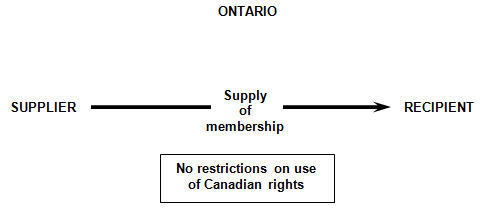
The Canadian rights in respect of the membership can be used less than primarily in the participating provinces and less than primarily outside the participating provinces. Also, the intangible personal property is supplied in the presence of the recipient through a permanent establishment of the supplier that is in Ontario and the intangible personal property can be used in Ontario. Therefore, the supply of the intangible personal property is made in Ontario and subject to HST at a rate of 13%.
Example 40
An individual purchases a rail pass at a train station in Ontario for consideration of less than $300. The pass entitles the individual to unlimited rail travel for 60 days anywhere in Ontario and Quebec.
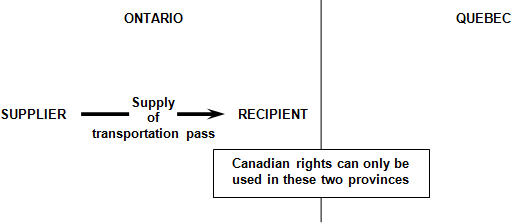
The Canadian rights in respect of the rail pass can be used less than primarily in the participating provinces and less than primarily outside the participating provinces. Also, the supply of the pass is made in the presence of the recipient through a permanent establishment of the supplier that is in Ontario and the pass can be used in Ontario. Therefore, the supply of the intangible personal property is made in Ontario and subject to HST at a rate of 13%.
Example 41
An individual purchases a rail pass at a train station in Quebec for consideration of less than $300. The pass entitles the individual to unlimited rail travel for 60 days anywhere in Ontario and Quebec.
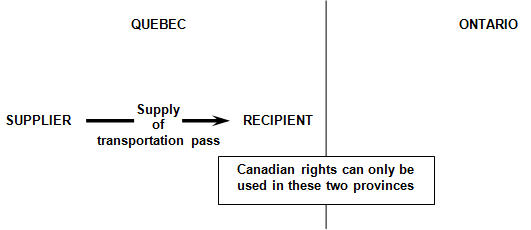
The Canadian rights in respect of the rail pass can be used less than primarily in the participating provinces and less than primarily outside the participating provinces. Also, the pass is sold in the presence of the recipient through a permanent establishment of the supplier that is in Quebec and the pass can be used in Quebec. Therefore, the supply of the intangible personal property is made in Quebec and subject to GST at a rate of 5%.
Rule 3B – Address in Canada obtained
(Paragraph 8(b) of Division 2 of Part 1 of the Regulations)
If Rule 3A does not deem the supply to be made in a province, the supply may be deemed to be made in a province if the supplier obtains an address of the recipient in the province in the ordinary course of business. Specifically, the supply of the intangible personal property is made in a province if:
- in the ordinary course of business of the supplier, the supplier obtains an address that is
- if the supplier obtains only one address that is a home or business address in Canada of the recipient, the home or business address in Canada of the recipient,
- if the supplier obtains more than one such address, the home or business address in Canada of the recipient that is most closely connected with the supply, or
- in any other case, the address in Canada of the recipient that is most closely connected with the supply;
- the address is in the province; and
- the intangible personal property can be used in the province.
For an explanation of how to determine the relevant address of the recipient for purposes of this rule, see the explanation under General Rule 1 of the general place of supply rule for services explained below.
Example 42
A supplier in British Columbia supplies software by way of licence to a company in British Columbia for use by its employees at its various offices throughout Canada. The software is downloaded electronically over the Internet. There are no restrictions with respect to where the software may be used. The only business address of the recipient obtained by the supplier in the ordinary course of its business with respect to the supply of the software is in British Columbia.
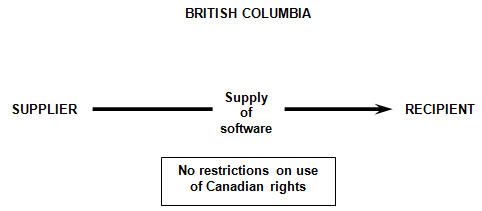
The Canadian rights in respect of the software can be used less than primarily in the participating provinces and less than primarily outside the participating provinces. Also, in the ordinary course of its business, the supplier only obtains a business address of the recipient that is in British Columbia and the intangible personal property can be used in British Columbia. Therefore, the supply of the intangible personal property is made in British Columbia and subject to HST at a rate of 12%.
Example 43
A supplier in Ontario supplies software by way of licence to a company in Quebec for use by its employees at its various offices throughout Canada. The software is downloaded electronically over the Internet. There are no restrictions with respect to where the software may be used. The only business address of the recipient obtained by the supplier in the ordinary course of its business with respect to the supply of the software is in Quebec.
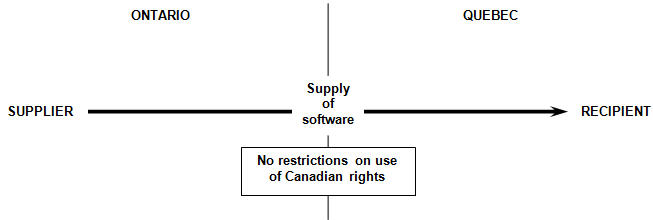
The Canadian rights in respect of the software can be used less than primarily in the participating provinces and less than primarily outside the participating provinces. Also, in the ordinary course of its business, the supplier only obtains a business address of the recipient in Canada that is in Quebec and the intangible personal property can be used in Quebec. Therefore, the supply of the intangible personal property is made in Quebec and subject to GST at a rate of 5%.
Example 44
An individual who lives in Ontario purchases a membership in a professional organization in Quebec. The membership can be used in any province. It is the ordinary business practice of the supplier to obtain a home address of the recipient to which the membership card and invoice can be sent.
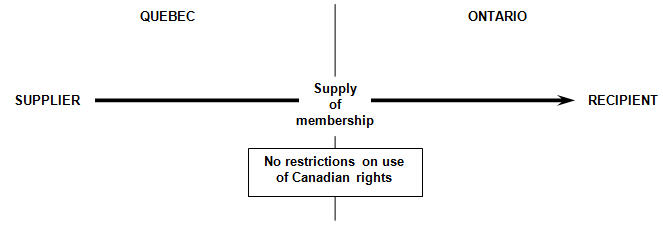
The Canadian rights in respect of the membership can be used less than primarily in the participating provinces and less than primarily outside the participating provinces. Also, in the ordinary course of its business, the supplier obtains a home address of the recipient that is in Ontario and the membership can be used in Ontario. Therefore, the supply of the intangible personal property is made in Ontario and subject to HST at a rate of 13%.
Example 45
An individual who lives in Ontario purchases a membership that can be used in any province. When supplying a membership, it is the ordinary business practice of the supplier in British Columbia to obtain the home address of the recipient verified with credit card authorization and a billing address to which the membership card and invoice can be sent. As part of this process, the supplier obtains a home address of the recipient that is in Ontario and a billing address in Quebec.
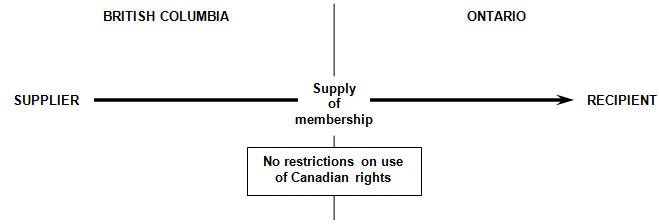
The Canadian rights in respect of the membership can be used less than primarily in the participating provinces and less than primarily outside the participating provinces. Also, in the ordinary course of its business, the supplier obtains a home address of the recipient that is in Ontario. Therefore, the supply of the intangible personal property is made in Ontario and subject to HST at a rate of 13%.
Example 46
An individual purchases a digital music album from an online vendor based in Ontario. There are no restrictions on where the intangible personal property can be used in Canada. As part of the purchase process, the supplier only obtains the individual's home address in British Columbia.
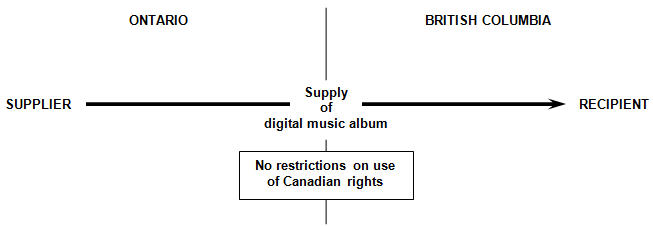
The Canadian rights in respect of the intangible personal property can be used less than primarily in the participating provinces and less than primarily outside the participating provinces. Also, in the ordinary course of its business, the supplier only obtains a home address of the recipient in Canada that is in British Columbia and the intangible personal property can be used in British Columbia. The supply of the intangible personal property is therefore made in British Columbia and subject to HST at a rate of 12%.
Example 47
A registered supplier supplies monthly subscriptions to its Web site from its business address in Ontario that provides consumers with a right to access and use digitized content on the site, including information in a database and images and the right to download a copy of the digitized content. The supplier has clients throughout the world. There are no restrictions with respect to where subscribers may use the intangible personal property. When subscribers pay for their subscription, it is the supplier's ordinary business practice to obtain a home address of the recipient.
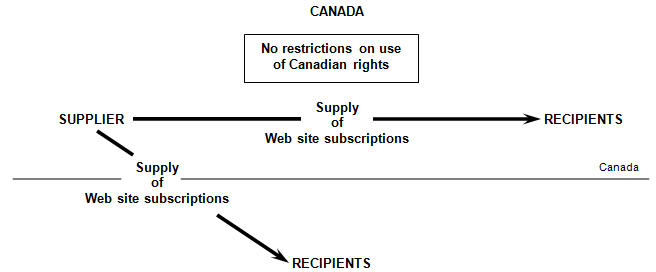
The Canadian rights in respect of the digitized content can be used less than primarily in the participating provinces and less than primarily outside the participating provinces. Also, in the ordinary course of its business, the supplier obtains a home address of the recipients. Where the recipient's home address is in a participating province, the supply of the intangible personal property is made in that province and subject to HST. Where the recipient's home address is in a non-participating province, the supply of the intangible personal property is made in that province and subject to GST at a rate of 5%. Where the recipient's home address is outside Canada, Rule 3C applies as explained in Example 59.
Example 48
A non-resident GST/HST registered supplier supplies monthly subscriptions to its Web site that provides subscribers with a right to access and use digitized content on the site that is intended for businesses. The supplier has clients who are resident in Canada and non-resident clients, some of which are registered for GST/HST purposes. There are no restrictions with respect to where subscribers may use the intangible personal property. When subscribers pay for their subscription, it is the supplier's ordinary business practice to obtain a business address of the recipient.
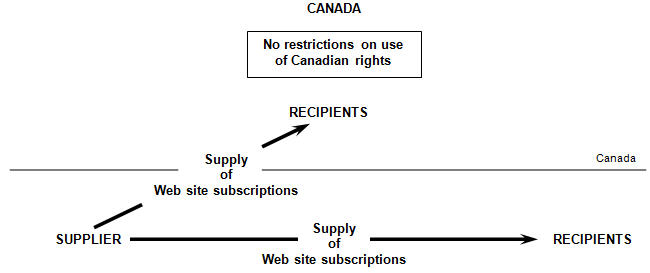
The Canadian rights in respect of the intangible personal property can be used less than primarily in the participating provinces and less than primarily outside the participating provinces. Also, in the ordinary course of its business, the supplier obtains a business address of the recipients. Where the recipient's business address is in a participating province, the supply of the intangible personal property is made in that province and subject to HST. Where the recipient's business address is in a non-participating province, the supply of the intangible personal property is made in that province and subject to GST at a rate of 5%. Where the business address of the recipient obtained by the supplier is outside Canada, Rule 3C applies as explained in Example 60.
Example 49
A lawyer who operates a law firm in Ontario and lives in Quebec purchases a subscription to an online law Web site from a content provider in Ontario. The subscription entitles her to access and use digitized content that is stored on the Web site of the content provider. There are no restrictions with respect to where subscribers may use the intangible personal property. It is the ordinary business practice of the provider to obtain a business address and a billing address of the recipient. The lawyer completes the purchase and provides the business address of the law firm in Ontario as the business address and her home address in Quebec as the billing address.
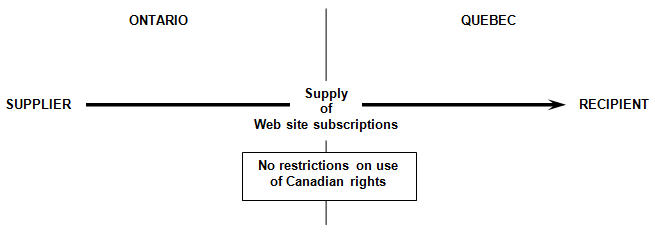
The Canadian rights in respect of the intangible personal property can be used less than primarily in the participating provinces and less than primarily outside the participating provinces. Also, in the ordinary course of its business, the supplier obtains the business address of the recipient that is in Ontario. Therefore, the supply of the intangible personal property is made in Ontario and subject to HST at a rate of 13%.
Example 50
An Ontario publishing company enters into a contract with an author in Nova Scotia to purchase the Canadian copyright to produce copies and sell the author's latest novel for more than $300. The contract states that the publishing company's address is in Ontario.
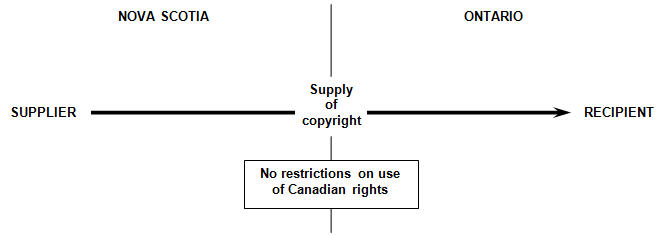
The Canadian rights in respect of the intangible personal property can be used less than primarily in the participating provinces and less than primarily outside the participating provinces. Also, in the ordinary course of its business, the supplier only obtains a business address of the recipient that is in Ontario and the intangible personal property can be used in Ontario. Therefore, the supply of the intangible personal property is made in Ontario and subject to HST at a rate of 13%.
Example 51
A franchise company in New Brunswick supplies a franchise to a New Brunswick company that provides the right to operate a franchise retail business in New Brunswick and Quebec. The business address of the recipient obtained by the supplier in the ordinary course of its business is in New Brunswick.
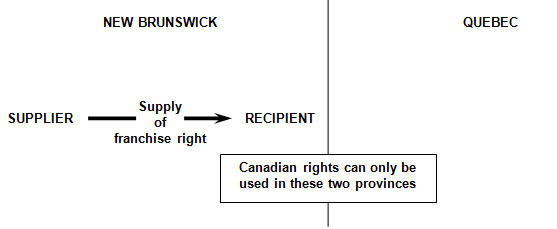
The Canadian rights in respect of the franchise can be used less than primarily in participating provinces and less than primarily outside participating provinces. Also, in the ordinary course of its business, the supplier only obtains a business address of the recipient in New Brunswick. Therefore, the supply of the intangible personal property is made in New Brunswick and subject to HST at a rate of 13%.
Example 52
An individual in Ontario purchases an air transportation pass over the Internet from a supplier in Ontario that provides the individual with unlimited travel between Ontario, Manitoba, Saskatchewan and Alberta. The individual's home address is in Ontario.

The Canadian rights in respect of the pass can be used less than primarily in the participating provinces and less than primarily outside the participating provinces. Also, in the ordinary course of its business, the supplier obtains a home address of the recipient that is in Ontario and the intangible personal property can be used in Ontario. Therefore, the supply of the intangible personal property is made in Ontario and subject to HST at a rate of 13%.
Example 53
An individual who lives in Ontario purchases a rail pass at a train station in Ontario for more than $300. The pass entitles the individual to unlimited rail travel for 90 days anywhere in Ontario and Quebec. It is the ordinary business practice of the supplier to obtain the recipient's home address when a pass is purchased.
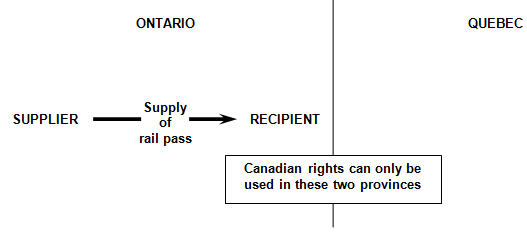
The Canadian rights in respect of the rail pass can be used less than primarily in the participating provinces and less than primarily outside the participating provinces because there are no restrictions with respect to the extent to which the Canadian rights in respect of the intangible personal property can be used in Ontario and Quebec. Also, in the ordinary course of its business, the supplier obtains a home address of the recipient that is in Ontario and the intangible personal property can be used in Ontario. Therefore, the supply of the intangible personal property is made in Ontario and subject to HST at a rate of 13%.
Example 54
An individual who lives in Quebec purchases a rail pass at a train station in Quebec for more than $300. The pass entitles the individual to unlimited rail travel for 90 days anywhere in Ontario and Quebec. It is the ordinary business practice of the supplier to obtain the recipient's home address when a pass is purchased.
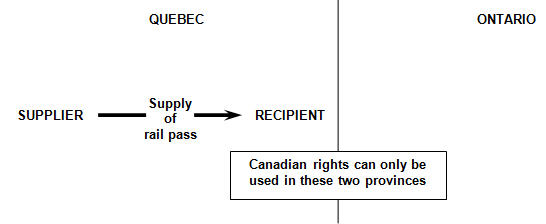
The Canadian rights in respect of the rail pass can be used less than primarily in the participating provinces and less than primarily outside the participating provinces because there are no restrictions with respect to the extent to which the Canadian rights in respect of the intangible personal property can be used in Ontario and Quebec. Also, in the ordinary course of its business, the supplier obtains a home address of the recipient that is in Quebec and the intangible personal property can be used in Quebec. Therefore, the supply of the intangible personal property is made in Quebec and subject to GST at a rate of 5%.
Example 55
An individual who lives in Ontario purchases a rail pass over the Internet from the Web site of a supplier based in Ontario for less than $300. The pass entitles the individual to unlimited rail travel for 60 days anywhere in Ontario and Quebec. It is the ordinary business practice of the supplier in Ontario to obtain the recipient's home address when a pass is purchased from its Web site. The pass is mailed to the recipient's address in Ontario.

The Canadian rights in respect of the rail pass can be used less than primarily in the participating provinces and less than primarily outside the participating provinces. Also, in the ordinary course of its business, the supplier obtains a home address of the recipient that is in Ontario and the intangible personal property can be used in Ontario. Therefore, the supply of the intangible personal property is made in Ontario and subject to HST at a rate of 13%.
Rule 3C – Highest tax rate
(Paragraph 8(c) of Division 2 of Part 1 of the Regulations)
If Rule 3A or Rule 3B does not deem the supply of the intangible personal property to be made in a province, the supply is made in the participating province for which the tax rate is the highest among the tax rates for the provinces in which the property can be used. If a supply of intangible personal property cannot be determined under Rule 3C to be made in a single participating province because the highest tax rate for two or more participating provinces are the same, see General Rule 4 below.
Example 56
An individual in Ontario purchases an air transportation pass that provides the individual with unlimited travel between Ontario, Manitoba, Saskatchewan and Alberta. The supplier in Ontario does not obtain an address of the individual.
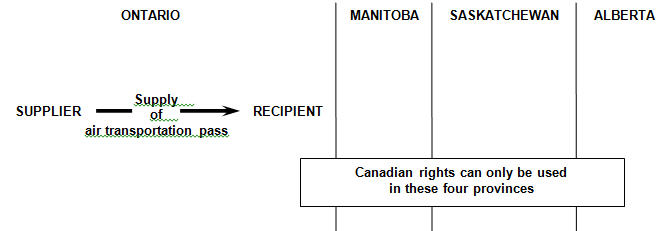
The Canadian rights in respect of the air transportation pass can be used less than primarily in the participating provinces and less than primarily outside the participating provinces. The supply of the intangible personal property is made in Ontario and subject to HST at a rate of 13% because it is the province in which the intangible personal property can be used that has the highest tax rate.
Example 57
An individual in Alberta purchases an air transportation pass that provides the individual with unlimited travel between Ontario, Alberta and British Columbia. The supplier in British Columbia does not obtain an address of the individual.
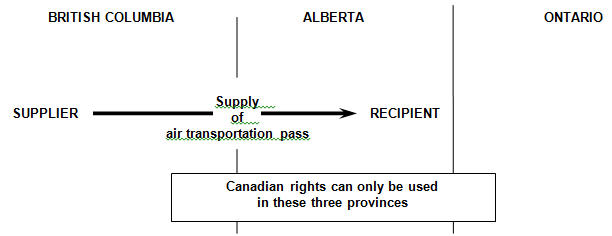
The Canadian rights in respect of the air transportation pass can be used less than primarily in the participating provinces and less than primarily outside the participating provinces. The supply of the intangible personal property is made in Ontario and subject to HST at a rate of 13% because it is the province in which the intangible personal property can be used that has the highest tax rate.
Example 58
A non-resident individual who plans on visiting Canada purchases a rail pass for more than $300. The pass entitles the individual to unlimited train travel for 90 days anywhere in Ontario and Quebec. It is the ordinary business practice of the supplier to obtain the recipient's home address when a pass is purchased.
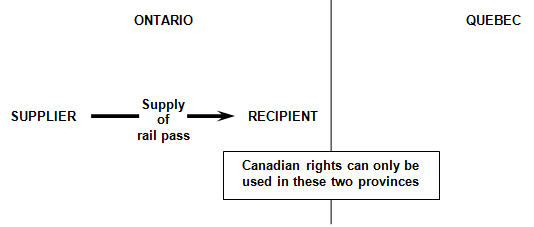
The Canadian rights in respect of the rail pass can be used less than primarily in the participating provinces and less than primarily outside the participating provinces. Although in the ordinary course of business the supplier obtains a home address of the recipient, that address is outside Canada. Therefore, the supply of the intangible personal property is made in Ontario and subject to HST at a rate of 13% because it is the province in which the intangible personal property can be used that has the highest tax rate.
Example 59
The facts of this example are the same as those in Example 47 where the registered supplier makes supplies from its business address in Ontario of monthly subscriptions to its Web site.
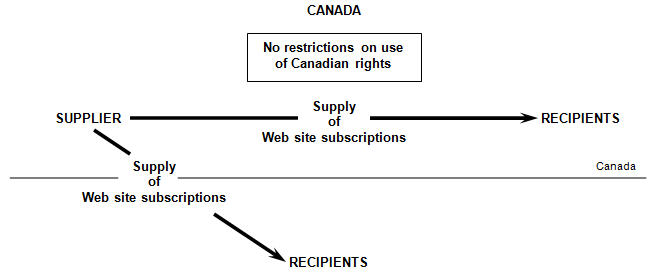
With respect to supplies made to non-resident recipients, the supplier has not obtained an address in Canada of the recipient in the ordinary course of its business because the home address of the recipient obtained by the supplier is outside Canada. The supply is therefore made in the participating province for which the tax rate is the highest among the provinces in which the property can be used, which is Nova Scotia. Therefore, the supplier charges HST at a rate of 15% in respect of the supply unless the supply is zero-rated. Under certain conditions, supplies made to unregistered non-residents may qualify for zero-rating (refer to GST/HST Info Sheet GI-034, Exports of Intangible Personal Property for more information).
Example 60
The facts of this example are the same as those in Example 48 where a non-resident GST/HST registered supplier makes supplies of monthly subscriptions to its Web site.
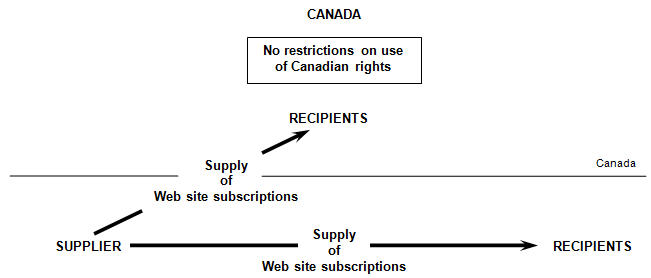
With respect to supplies made to non-resident recipients, the supplier has not obtained an address in Canada of the recipient in the ordinary course of its business because the business address of the recipient obtained by the supplier is outside Canada. Therefore, the supply is made in the participating province for which the tax rate is the highest among the provinces in which the property can be used which is Nova Scotia. Therefore, the supplier charges HST at a rate of 15% in respect of the supply unless the supply is zero-rated. Under certain conditions, supplies made to unregistered non-residents may qualify for zero-rating (refer to GST/HST Info Sheet GI-034, Exports of Intangible Personal Property for more information).
General Rule 4 – Participating provinces with the same highest tax rate
(Section 11 of Division 2 of Part 1 of the Regulations)
If a supply of intangible personal property cannot be determined under Rule 2D or Rule 3C to be made in a single participating province, because the highest tax rates for two or more of the participating provinces (each of which is referred to here as a "specified province") are the same, the supply is made in the specified province among those provinces where the business address of the supplier that is most closely connected with the supply is located or, if such an address is not located in one of the specified provinces, in the specified province that is closest in proximity, determined in any reasonable manner, to such an address.
Intangible personal property that relates to passenger transportation services
(Section 22 of Division 4 of Part 1 of the Regulations)
Special place of supply rules apply to a supply of intangible personal property that is, or is similar to, a passenger transportation pass entitling an individual to one or more passenger transportation services:
- If, at the time the supply is made, the supplier can determine that each passenger transportation service covered by the passenger transportation pass could not begin otherwise than in the same participating province and would terminate in Canada, the supply is made in that participating province.
- If, at the time the supply is made, the supplier can determine that each passenger transportation service covered by the passenger transportation pass could not begin otherwise than in a non-participating province or would terminate outside Canada, the supply is made in a non-participating province.
If these rules do not determine the place of supply of the intangible personal property (for instance, where the passenger transportation services covered by the passenger transportation pass may not always begin in the same participating province), the place of supply of the intangible personal property is determined under the general place of supply rules for intangible personal property explained in "Intangible personal property – General rules".
Example 61
A resident of Ontario purchases a rail pass at a rail station in Ontario. The pass entitles him to ten one-way trips from Ottawa to Toronto. When he wishes to travel, he uses the pass to obtain a rail ticket which specifies that the origin of the trip is Ottawa.
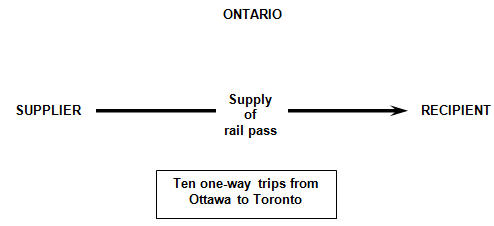
When the supply of the intangible personal property is made, the supplier can determine that each passenger transportation service covered by the passenger transportation pass would always begin in the same participating province (Ontario) and terminate in Canada. Therefore, the supply of the intangible personal property is made in Ontario and subject to HST at a rate of 13%.
Example 62
A resident of Ontario purchases a rail pass at a rail station in Ontario that entitles her to ten one-way trips from Ottawa to Montreal. When she wishes to travel, she uses the pass to obtain a rail ticket which specifies that the origin of the trip is Ottawa.
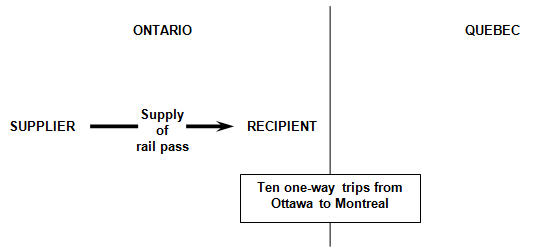
When the supply of the intangible personal property is made, the supplier can determine that each passenger transportation service covered by the passenger transportation pass would always begin in the same participating province (Ontario) and terminate in Canada. Therefore, the supply of the intangible personal property is made in Ontario and subject to HST at a rate of 13%.
Example 63
An individual purchases a commercial bus pass in Ontario. The pass entitles the individual to unlimited bus travel for one month anywhere in Newfoundland and Labrador.

When the supply of the intangible personal property is made, the supplier can determine that each passenger transportation service covered by the passenger transportation pass would always begin in the same participating province (Newfoundland and Labrador) and terminate in Canada. Therefore, the supply of the intangible personal property is made in Newfoundland and Labrador and subject to HST at a rate of 13%.
Example 64
A resident of Ontario purchases at an Ontario rail station a rail pass containing vouchers that entitles him to five one-way trips in either direction between Ottawa and Toronto. The vouchers do not specify the origin of each trip since the trips can begin in either Ottawa or Toronto. When he wishes to travel, he uses one of the vouchers.
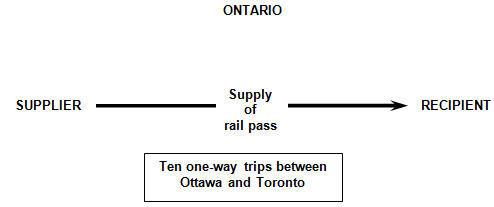
When the supply of the intangible personal property is made, the supplier can determine that each passenger transportation service covered by the passenger transportation pass would always begin in the same participating province (Ontario) and terminate in Canada. The supply of the intangible personal property is therefore made in Ontario and subject to HST at a rate of 13%.
Example 65
A resident of Quebec purchases a rail pass at a rail station in Quebec. The pass entitles her to ten one-way trips from Montreal to Ottawa. When she wishes to travel, she uses the pass to obtain a rail ticket which specifies that the origin of that trip is Montreal.
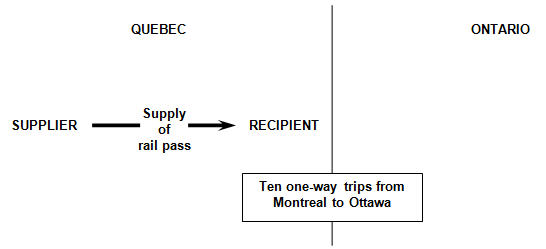
When the supply of the intangible personal property is made, the supplier can determine that each passenger transportation service covered by the passenger transportation pass would always begin in a non-participating province. The supply of the intangible personal property is therefore made in a non-participating province and subject to GST at a rate of 5%.
Example 66
A resident of Alberta purchases an air transportation pass that entitles her to five return trips from Calgary to Ottawa.
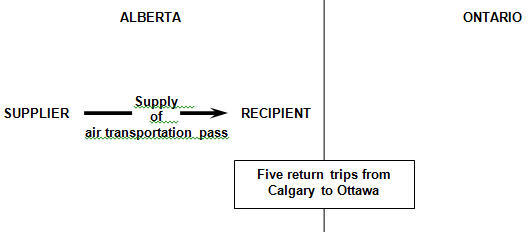
When the supply of the intangible personal property is made, the supplier can determine that each passenger transportation service covered by the passenger transportation pass would always begin in a non-participating province. Therefore, the supply of the intangible personal property is made in a non-participating province and subject to GST at a rate of 5%.
Intangible personal property that relates to tangible personal property
(Section 10 of Division 2 of Part 1 of the Regulations)
The general place of supply rules for supplies of intangible personal property do not apply to supplies of intangible personal property that relates to tangible personal property such as option to purchase tangible personal property. These types of supplies are subject to specific place of supply rules.
Generally, a supply of intangible personal property is considered to relate to tangible personal property if the intangible personal property relates to specific tangible personal property. It excludes a supply of a right to use tangible personal property by way of lease, licence or similar arrangement, since such a supply is deemed to be a supply of the tangible personal property that is subject to different place of supply rules.
Rule 1 – Intangible personal property that relates to tangible personal property that is not ordinarily located primarily in participating provinces
(Paragraph 10(b) of Division 2 of Part 1 of the Regulations)
A supply of intangible personal property that relates to tangible personal property that is ordinarily located in Canada is made in a non-participating province if the tangible personal property that is ordinarily located in Canada is not ordinarily located primarilyFootnote 4 in participating provinces.
Rule 2 – Intangible personal property that relates to tangible personal property ordinarily located primarily in participating provinces
(Paragraph 10(a) of Division 2 of Part 1 of the Regulations)
A supply of intangible personal property that relates to tangible personal property is made in a participating province if
- the tangible personal property that is ordinarily located in Canada is ordinarily located primarily Footnote 5 in participating provinces, and
- an equal or greater proportion of the tangible personal property is not ordinarily located in another participating province.
Ordinary location of property
(Section 4 of Part I of Schedule IX)
For purposes of the place of supply rules, the ordinary location of property is deemed to be the location where the supplier and the recipient mutually agree that the ordinary location of the property is to be at a particular time. In other words, the mutual agreement of the supplier and recipient is determinative even where the property is actually located at a different place at the relevant time than what had been agreed upon. The mutual agreement of the parties may change from time to time. Therefore, even if the original written agreement for a supply of property specified that the property would be located in a particular province, the parties may mutually agree subsequent to the signing of the contract that the property is to be moved at a particular time to a location in another province. In this case, the latter location would be the ordinary location of the property at that particular time.
Rule 3 – Highest tax rate
(Paragraph 10(a) of Division 2 of Part 1 of the Regulations)
If Rule 2 does not result in the supply being made in a province because the tangible personal property is ordinarily located in equal proportions in two or more participating provinces, the intangible personal property is deemed to be supplied in the participating province among those provinces for which the tax rate is the highest.
Rule 4 – Same highest tax rate
(Section 11 of Division 2 of Part 1 of the Regulations)
If a supply of intangible personal property cannot be determined under Rule 3 to be made in a single participating province, because the tax rates for two or more of the participating provinces (each of which is referred to here as a "specified province") are the same, the supply is made in the specified province among those provinces where the business address of the supplier that is most closely connected with the supply is located or, if such an address is not located in one of the specified provinces, in the specified province that is closest in proximity, determined in any reasonable manner, to such an address.
Example 67
An Ontario company supplies to a Quebec company intangible personal property that relates to tangible personal property that is ordinarily located in Nova Scotia.

The tangible personal property that is ordinarily located in Canada to which the intangible personal property relates is ordinarily located primarily in the participating provinces and the greatest proportion of the tangible personal property that is ordinarily located in the participating provinces is ordinarily located in Nova Scotia. Therefore, the supply of the intangible personal property is made in Nova Scotia and subject to HST at a rate of 15%.
Example 68
An Ontario company supplies another Ontario company with intangible personal property that relates to tangible personal property that is located in Canada and outside Canada. Of the total tangible personal property, 20% is ordinarily located in Ontario and 80% in the United States.
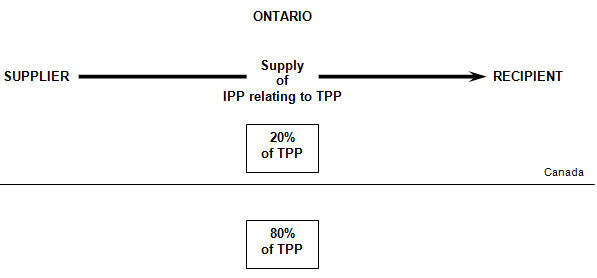
The tangible personal property that is ordinarily located in Canada to which the intangible personal property relates is ordinarily located primarily in the participating provinces and the greatest proportion of the tangible personal property that is ordinarily located in the participating provinces is ordinarily located in Ontario. Therefore, the supply of the intangible personal property is made in Ontario and subject to HST at a rate of 13%.
Example 69
A Quebec company supplies an Ontario company with intangible personal property that relates to tangible personal property. Of the total tangible personal property, 30% is ordinarily located in British Columbia, 10% in Ontario and 60% in the United States.

The tangible personal property that is ordinarily located in Canada to which the intangible personal property relates is ordinarily located primarily in the participating provinces (i.e., 100% of the tangible personal property in Canada is ordinarily located in Ontario and British Columbia), and the greatest proportion of the tangible personal property that is ordinarily located in the participating provinces is ordinarily located in British Columbia. Therefore, the supply of the intangible personal property is made in British Columbia and subject to HST at a rate of 12%.
Example 70
An Ontario company supplies another Ontario company with intangible personal property that relates to tangible personal property. Of the total tangible personal property, 40% is ordinarily located in Ontario and 60% in Quebec.
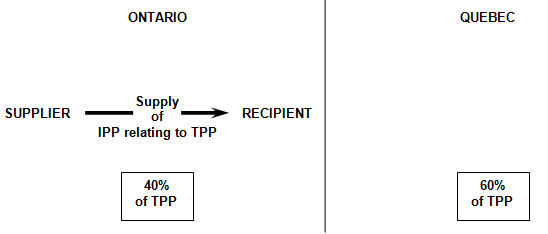
The tangible personal property that is ordinarily located in Canada to which the intangible personal property relates is not ordinarily located primarily in the participating provinces. Therefore, the supply of the intangible personal property is made in a non-participating province and is subject to GST at a rate of 5%.
Example 71
A British Columbia company supplies another British Columbia company with intangible personal property that relates to tangible personal property. Of the total tangible personal property, 5% is ordinarily located in British Columbia and 95% in the United States.
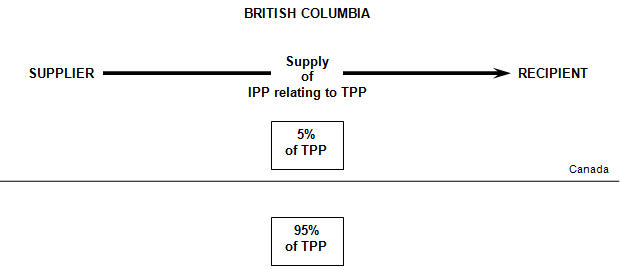
The tangible personal property that is ordinarily located in Canada to which the intangible personal property relates is ordinarily located primarily in the participating provinces and the greatest proportion of the tangible personal property that is ordinarily located in the participating provinces is ordinarily located in British Columbia. Therefore, the supply of the intangible personal property is made in British Columbia and subject to HST at a rate of 12%.
Example 72
A registered non-resident company supplies an Ontario company with intangible personal property that relates to tangible personal property. Of the total tangible personal property, 5% is ordinarily located in Ontario and 95% in the United States.
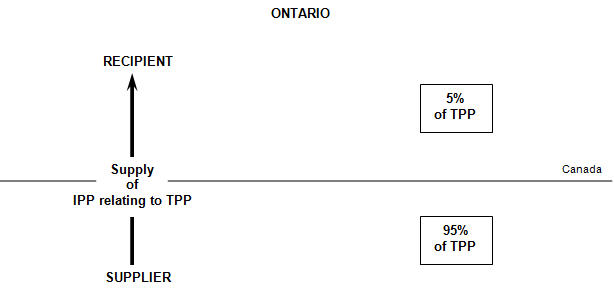
The tangible personal property that is ordinarily located in Canada to which the intangible personal property relates is ordinarily located primarily in the participating provinces and the greatest proportion of the tangible personal property that is ordinarily located in the participating provinces is ordinarily located in Ontario. Therefore, the supply of the intangible personal property is made in Ontario and subject to HST at a rate of 13%.
Example 73
An Ontario company supplies another Ontario company with intangible personal property that relates to tangible personal property. Of the total tangible personal property, 50% is ordinarily located in Ontario and 50% is ordinarily located in British Columbia.
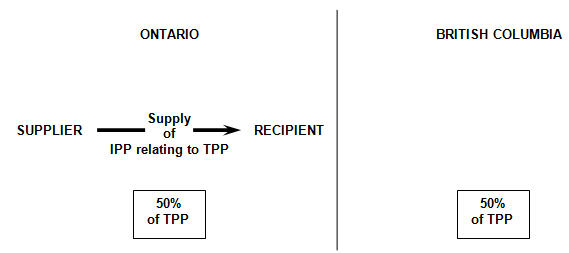
The tangible personal property that is ordinarily located in Canada to which the intangible personal property relates is ordinarily located primarily in the participating provinces and in equal proportions in the participating provinces of British Columbia and Ontario. Therefore, the supply of the intangible personal property is made in the participating province among these two participating provinces that has the highest tax rate, which in this case is in Ontario. The supply is made in Ontario and is subject to HST at a rate of 13%.
Example 74
A New Brunswick company supplies a Nova Scotia company with intangible personal property that relates to tangible personal property. Of the total tangible personal property, 50% is ordinarily located in New Brunswick and 50% in Newfoundland and Labrador.
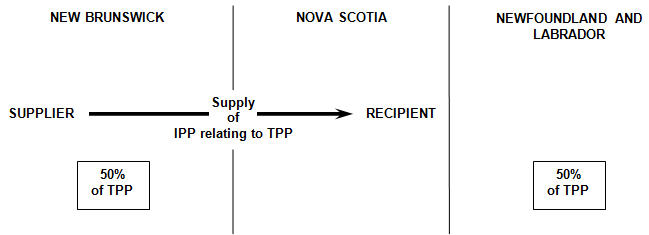
The tangible personal property that is ordinarily located in Canada to which the intangible personal property relates is ordinarily located primarily in the participating provinces and in equal proportions in the participating provinces of New Brunswick and Newfoundland and Labrador which both have the same tax rate. Therefore, the supply is made in the province among these provinces where the business address of the supplier that is most closely connected with the supply is located, which in this case is New Brunswick. Therefore, the supply is made in New Brunswick and is subject to HST at a rate of 13%.
Intangible personal property that relates to real property
(Section 9 of Division 2 of Part 1 of the Regulations)
The general place of supply rules for supplies of intangible personal property do not apply to supplies of intangible personal property that relates to real property. These types of supplies are subject to specific place of supply rules.
Real property is defined to include:
- in respect of property in the Province of Quebec, immovable property and every lease thereof,
- in respect of property in any other place in Canada, messuages, lands and tenements of every nature and description and every estate or interest in real property, whether legal or equitable, and
- a mobile home, a floating home and any leasehold or proprietary interest therein.
Based on this definition, except for property in Quebec, there are very few supplies of intangible personal property relating to real property that would not be deemed to be a supply of real property. As a result, the place of supply rules explained in this section would only apply in a few circumstances. An example of a supply of intangible personal property relating to real property to which the rules could apply would be a supply of a vacation club membership relating to vacation resorts.
Intangible personal property that relates to real property in Canada and outside Canada
(Section 142)
A supply of intangible personal property that relates to real property is deemed to be made in Canada if the real property is situated in Canada and is deemed to be made outside Canada if the real property is situated outside Canada. As a result, where the real property is both situated in Canada and outside Canada, the proportion of the supply of the intangible personal property that relates to the real property that is situated in Canada is considered to be made in Canada while the proportion of the supply of the intangible personal property that relates to the real property that is situated outside Canada is considered to be made outside Canada. As a result, it is only the proportion of the supply of the intangible personal property that relates to real property that is situated in Canada that may be deemed to be made in a participating province and subject to HST.
Rule 1 – Intangible personal property that relates to real property that is not situated primarily in participating provinces
(Paragraph 9(b) of Division 2 of Part 1 of the Regulations)
A supply of intangible personal property that relates to real property is made in a non-participating province if the real property that is situated in Canada is not situated primarily Footnote 6 in participating provinces.
Example 75
A New Brunswick company supplies intangible personal property that relates to real property to a Quebec company. Of the total real property, 40% is situated in New Brunswick and 60% is situated in Quebec.
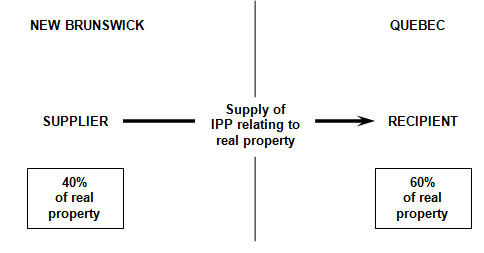
The real property that is situated in Canada to which the intangible personal property relates is not situated primarily in the participating provinces. Therefore, the supply of the intangible personal property is made in a non-participating province and is subject to GST at a rate of 5%.
Rule 2 – Intangible personal property that relates to real property situated primarily in participating provinces
(Paragraph 9(a) of Division 2 of Part 1 of the Regulations)
A supply of intangible personal property that relates to real property is made in a participating province if
- the real property that is situated in Canada is situated primarily in participating provinces, and
- an equal or greater proportion of the real property is not situated in another participating province.
Example 76
A New Brunswick company supplies a Quebec company with intangible personal property that relates to commercial real property that is situated entirely in New Brunswick.
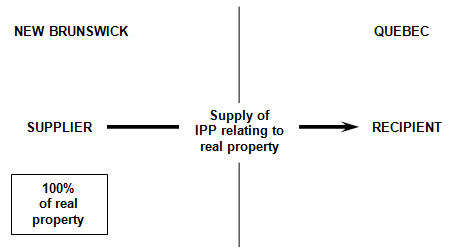
The real property that is situated in Canada to which the intangible personal property relates is situated primarily in the participating provinces and the participating province in which the greatest proportion of the real property that is situated in the participating provinces is situated is New Brunswick. Therefore, the supply of the intangible personal property is made in New Brunswick and subject to HST at a rate of 13%.
Rule 3 – Highest tax rate
If Rule 2 does not result in the supply being made in a province because the real property is ordinarily located in equal proportions in two or more participating provinces, the intangible personal property is deemed to be supplied in the participating province among those provinces for which the tax rate is the highest.
Rule 4 – Same highest tax rate
(Section 11 of Division 2 of Part 1 of the Regulations)
If a supply of intangible personal property cannot be determined under the previously explained rules to be made in a single participating province, because the highest tax rates for two or more of the participating provinces (each of which is referred to here as a "specified province") are the same, the supply is made in the specified province among those provinces where the business address of the supplier that is most closely connected with the supply is located or, if such an address is not located in one of the specified provinces, in the specified province that is closest in proximity, determined in any reasonable manner, to such an address.
Example 77
A Quebec company supplies intangible personal property that relates to real property to a company in Ontario. Of the total real property, 50% is situated in Ontario and 50% in British Columbia.
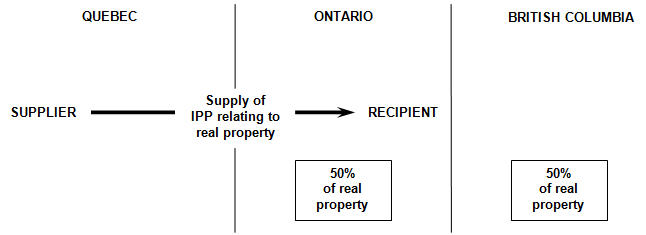
The real property that is situated in Canada to which the intangible personal property relates is situated primarily in the participating provinces and in equal proportions in the participating provinces of British Columbia and Ontario. Therefore, the supply of the intangible personal property is made in the participating province among these two provinces that has the highest tax rate, which in this case is Ontario. As a result, the supply is made in Ontario and subject to HST at a rate of 13%.
Example 78
A British Columbia company supplies intangible personal property that relates to real property to another company in British Columbia. Of the total real property, 20% is situated in British Columbia and 80% is situated in the United States.

The real property that is situated in Canada to which the intangible personal property relates is situated primarily in the participating provinces and the participating province in which the greatest proportion of the real property that is situated in the participating provinces is situated is British Columbia. Therefore, the proportion of the supply of the intangible personal property that relates to the real property that is situated in Canada is made in British Columbia and subject to HST at a rate of 12%. The proportion of the supply of the intangible personal property that relates to the real property that is situated outside Canada is deemed to be made outside Canada and is not subject to tax.
Example 79
An Ontario company supplies intangible personal property that relates to real property to a British Columbia company. Of the total real property, 30% is situated in Ontario, 10% is situated in British Columbia and 60% is situated in the United States.
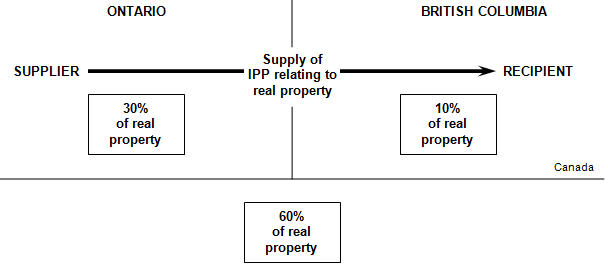
The real property that is situated in Canada to which the intangible personal property relates is situated primarily in the participating provinces (i.e., 100% of the real property that is situated in Canada is situated in Ontario and British Columbia), and the greatest proportion of the real property that is situated in Ontario and British Columbia is situated in Ontario. Therefore, the proportion of the supply of the intangible personal property that relates to the real property that is situated in Canada is made in Ontario and subject to HST at a rate of 13%. The proportion of the supply of the intangible personal property that relates to the real property that is situated outside Canada is deemed to be made outside Canada and is not subject to tax.
Example 80
A New Brunswick company supplies intangible personal property that relates to real property to another New Brunswick company. Of the total real property, 5% is situated in New Brunswick and 95% in the United States.
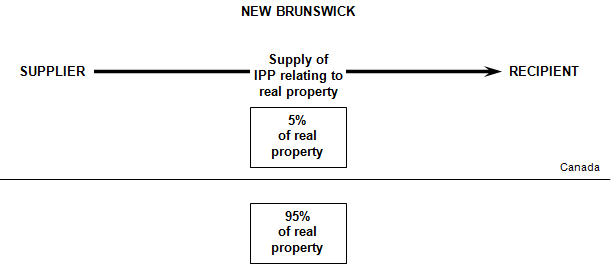
The real property that is situated in Canada to which the intangible personal property relates is situated primarily in the participating provinces and the greatest proportion of the real property that is situated in the participating provinces is situated in New Brunswick. Therefore, the proportion of the supply of the intangible personal property that relates to the real property that is situated in Canada is made in New Brunswick and subject to HST at a rate of 13%. The proportion of the supply of the intangible personal property that relates to the real property that is situated outside Canada is deemed to be made outside Canada and is not subject to tax.
Example 81
A company in Newfoundland and Labrador supplies intangible personal property that relates to real property to a New Brunswick company. Of the total real property, 50% is situated in Newfoundland and Labrador and 50% in New Brunswick.
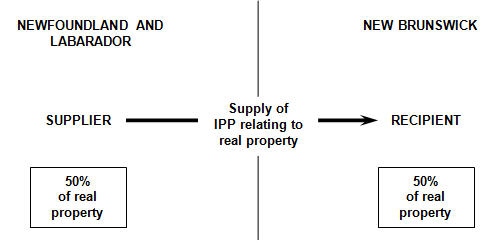
The real property that is situated in Canada to which the intangible personal property relates is situated primarily in the participating provinces and in equal proportions in the participating provinces of Newfoundland and Labrador and New Brunswick which both have the same tax rate. As a result, the supply is made in the province among these provinces where the business address of the supplier that is most closely connected with the supply is located, which in this case is Newfoundland and Labrador. Therefore, the supply is subject to HST at a rate of 13%.
Example 82
A company in Ontario supplies intangible personal property that relates to real property to a New Brunswick company. Of the total real property, one third is situated in Ontario, one third is situated in New Brunswick and one third is situated in British Columbia.
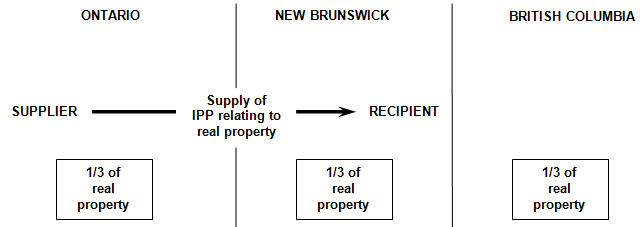
The real property that is situated in Canada to which the intangible personal property relates is situated primarily in the participating provinces and in equal proportions in the participating provinces of Ontario, New Brunswick and British Columbia. Ontario and New Brunswick have the same highest tax rate among the three participating provinces in which the real property is situated. As a result, the supply is made in the province among these two provinces where the business address of the supplier that is most closely connected with the supply is located, which in this case is Ontario. Therefore, the supply is made in Ontario and subject to HST at a rate of 13%.
Services
(Division 3 of Part 1 of the Regulations)
Overview
The place of supply rules for certain services have changed significantly. The general rules are now generally based on the home or business address of the recipient (or another address of the recipient) in Canada that the supplier obtains in the ordinary course of its business. However the general rules are subject to specific place of supply rules that can apply to certain types of services. Where the specific place of supply rules do not determine the place of supply of a particular type of service because the conditions for the application of those rules are not met, it is the general place of supply rules that determine the place of supply of the service.
Note: Appendix D contains a flow chart that summarizes the place of supply rules for supplies of services.
Exceptions
(Section 12 of Division 3 of Part 1 of the Regulations)
The place of supply rules explained in this section do not apply to passenger transportation services, freight transportation services, postage and mail delivery services and telecommunication services. The rules that apply to these types of supplies are explained later.
For purposes of the place of supply rules that apply to services, the following rules apply:
Deemed performance
(Section 3 of Part I of Schedule IX)
Where an agreement for a supply of a service is entered into but the service is never performed, the service is deemed to have been performed where the service was to be performed, as the case may be, under the terms of the agreement.
Ongoing services
(Subsection 136.1(2))
Where a supply of a service is made for consideration that includes a payment that is attributable to a period (referred to as a "billing period") that is the whole or a part of the period during which the service is or is to be rendered under the arrangement, a separate supply of the service for separate consideration is deemed to be made by the supplier and received by the recipient for each billing period. The supply for each billing period is deemed to be made on the earliest of
- the first day of the billing period,
- the day on which the payment attributable to that period becomes due, and
- the day that payment is made.
The separate supplies of the services that are deemed to be made for each billing period can be subject to HST at a different rate to the extent that they can be deemed made in a different province based on the place of supply rules for services.
Services – General rules
(Section 13 of Division 3 of Part 1 of the Regulations)
There are three general place of supply rules that apply to supplies of services. Generally, the first general rule applies where the supplier obtains an address in Canada of the recipient, while the second general rule applies where such an address is not obtained and is based on the location of the performance of the service. The third general rule applies where the second general rule does not apply because the service is performed equally in two or more participating provinces having the same highest tax rate.
Exceptions
The three general place of supply rules explained in this section are subject to specific place of supply rules that can apply to the following services:
- personal services,
- services in relation to tangible personal property,
- services in relation to real property,
- services in relation to a location-specific event,
- services rendered in connection with litigation,
- customs brokerage services,
- repairs, maintenance, cleaning, adjustments, alterations and photographic-related goods,
- services of a trustee in respect of a trust governed by an RRSP, RRIF, RESP, TFSA or RDSP,
- premium rate telephone services,
- computer-related services and Internet access,
- air navigation services.
The specific place of supply rules that can apply to these types of services are explained later under their respective headings.
The possible application of these specific rules must be considered before considering the application of the general rules. Generally, the relevancy of a specific place of supply rule is based on the type of service that is supplied. However, where the conditions for the application of a specific rule that applies to a certain type of service are not met with respect to the supply of a service, the supply will be subject to the general rules.
General Rule 1 – Address in Canada obtained
(Subsection 13(1) of Division 3 of Part 1 of the Regulations)
A supply of a service is made in a province if, in the ordinary course of business of the supplier, the supplier obtains an address in the province that is
- if the supplier obtains only one address that is a home or a business address in Canada of the recipient, the home or business address in Canada obtained by the supplier,
- if the supplier obtains more than one address described in paragraph (A), the address described in that paragraph that is most closely connected with the supply, or
- in any other case, the address in Canada of the recipient that is most closely connected with the supply.
General Rule 1 is generally based on the location of the recipient, which is generally accomplished by determining the place of supply based on an address in Canada of the recipient that the supplier obtains in the ordinary course of its business.
The rule does not require a supplier to obtain an address of the recipient that the supplier does not already obtain in the ordinary course of its business. The determination of the relevant address in respect of a supply under Rule 1 is based on the facts taking into account the ordinary business practice of each supplier with respect to each supply.
An address of the recipient obtained by a supplier is only relevant for purposes of this rule if it is obtained in the ordinary course of the supplier's business practices in connection with the supply. On the other hand, any address of the recipient obtained in the ordinary course of business of the supplier should be taken into consideration in applying the rule. The relevant address of the recipient also does not have to be an address obtained in respect of every supply made to the recipient for it to be considered a relevant address obtained in the ordinary course of business. An address of the recipient obtained by a supplier in the ordinary course of business could therefore include:
- an address of the recipient from which the supplier is hired in connection with a supply pursuant to an agreement for the supply (the "contracting address");
- an address of the recipient that the supplier deals with in connection with a supply; or
- a billing address of the recipient in connection with a supply.
The rule is straightforward, particularly where a supplier only obtains a single address of the recipient in the ordinary course of its business. However, where a supplier obtains several addresses of the recipient that are connected to the supply, a determination must be made with respect to which of these addresses is the address that is most closely connected to the supply.
Although a supply of a service may be deemed to be made in a particular province based on General Rule 1, self-assessment of the provincial part of the HST by the recipient in respect of the service may still be required in some cases where it is established that the service is acquired for consumption, use or supply in another province. General Rule 1 is not intended to replace the self-assessment provisions by requiring a supplier to determine the province in respect of which the recipient has acquired the service for consumption, use or supply, which in some cases can be in multiple provinces. The self-assessment rules complement the place of supply rules and account for different tax rates.
The type of address obtained must be an address of the recipient that represents an actual specific physical location that is situated in a province. For instance, an e-mail address or an IP address obtained by a supplier that does not represent a specific physical location address of the recipient is not relevant for purposes of General Rule 1.
The address obtained by the supplier in the ordinary course of business must be an address of the "recipient" of the supply who, under subsection 123(1), is generally the person who is liable under the agreement for the supply to pay the consideration payable for the supply.
A "recipient" of a supply of property or a service means
- where consideration for the supply is payable under an agreement for the supply, the person who is liable under the agreement to pay that consideration,
- where paragraph (a) does not apply and consideration is payable for the supply, the person who is liable to pay that consideration, and
- where no consideration is payable for the supply,
- in the case of a supply of property by way of sale, the person to whom the property is delivered or made available,
- in the case of a supply of property otherwise than by way of sale, the person to whom possession or use of the property is given or made available, and
- in the case of a supply of a service, the person to whom the service is rendered,
and any reference to a person to whom a supply is made shall be read as a reference to the recipient of the supply.
(A) Single business address or home address in Canada obtained
(Paragraph 13(1)(a) of Division 3 of Part 1 of the Regulations)
Paragraph (A) of Rule 1 provides that a supply of a service is made in a province if, in the ordinary course of business of the supplier, the supplier obtains an address in the province, that is, if the supplier obtains only one address, a home or business address in Canada of the recipient.
This part of the rule applies where the supplier obtains a single business or home address of the recipient in the ordinary course of its particular business. The business or home address of the recipient is considered to be the type of address that provides the closest approximation of the location of the recipient.
Generally, a business address is considered to be an address at which a business is located. A business address can therefore include, among other things, the address of an office, a branch, a factory or a workshop of the recipient. A PO Box, that is a locked compartment within a Post Office, is not considered to be a business address. However, a PO Box address can be considered to be another address of the recipient for purposes of the third part of the rule as explained later.
Generally, a home address means the address at which the primary residence of an individual is located.
This is straightforward to the extent that it is based on information that the supplier already obtains in the ordinary course of business. For purposes of paragraphs (A) and (B) of the rule which are based on a specific type of address, it must be reasonable for the supplier to be able to conclude that the type of address obtained is a business address of the recipient based on information that is available to the supplier. For example, if an online supplier asks its customers to provide what it identifies on its Web site as a "business address" (for example, for billing purposes) and this is the only address of the recipient that the supplier obtains in the ordinary course of business, the supplier is not required to verify whether the address provided by the recipient is actually a business address of the recipient. This part of the rule also applies if the supplier obtains a "business address" that the supplier knows is a business address based on the supplier's knowledge of the recipient (for instance, based on interactions that the supplier has with the recipient).
Example 83
An Ontario company hires a national newspaper based in Ontario for the placement of an ad in a local Ontario newspaper. The only business address of the recipient obtained by the supplier in the ordinary course of its business is in Ontario.

Since the only business address of the recipient in Canada that the supplier obtains in the ordinary course of its business is in Ontario, the supply of the service is made in Ontario and subject to HST at a rate of 13%.
Example 84
A supplier in Quebec agrees to design the Web site of a company in Ontario. The service is performed entirely in Quebec. The only business address of the recipient obtained by the supplier in the ordinary course of its business is in Ontario.
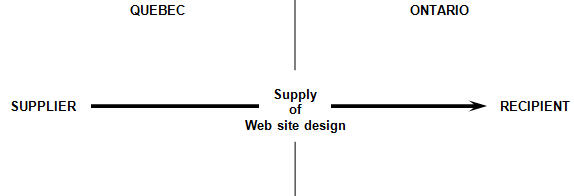
Since the only business address of the recipient in Canada that the supplier obtains in the ordinary course of its business is in Ontario, the supply of the service is made in Ontario and subject to HST at a rate of 13%.
Example 85
A wedding planning company located in Ontario supplies a service of planning a wedding to be held in Quebec. Approximately 40% of the service is to be performed in Quebec at the wedding location and 60% in Ontario. In the ordinary course of its business, the supplier only obtains a home address of the recipient that is in Ontario.

Since the only home address of the recipient in Canada that the supplier obtains in the ordinary course of its business is in Ontario, the supply of the service is made in Ontario and subject to HST at a rate of 13%.
Example 86
A wedding planning company in Ontario supplies a service of planning a wedding to be held in Quebec. Approximately 40% of the service is to be performed in Quebec at the wedding location and 60% of the service is to be performed in Ontario. The only home address of the recipient obtained by the supplier in the ordinary course of its business is in Manitoba.

Because the only home address of the recipient in Canada that the supplier obtains in the ordinary course of its business is in Manitoba, the supply of the service is made in Manitoba and is subject to GST at a rate of 5%.
Example 87
A law firm in Quebec is hired by a company in Ontario to supply it with tax advice with respect to the supply of tangible personal property that is situated in Ontario. The only business address of the recipient obtained by the supplier in the ordinary course of its business is in Ontario.
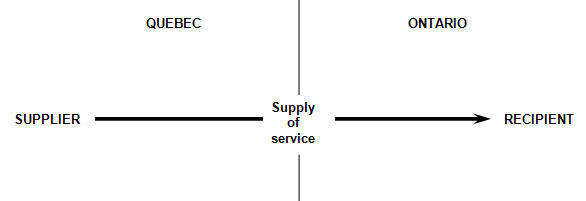
Since the only business address of the recipient in Canada that the supplier obtains in the ordinary course of its business is in Ontario, the supply of the service is made in Ontario and subject to HST at a rate of 13%.
Example 88
A consulting firm in Ontario is hired by a company in Nova Scotia to determine whether opening a retail franchise outlet in Halifax, Nova Scotia, would be a potentially viable business venture. The only address of the recipient that the consulting firm obtains in the ordinary course of its business is a business address of the recipient in Nova Scotia.
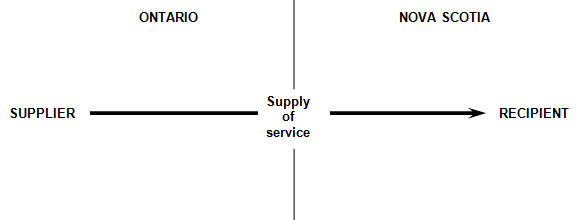
Since the only business address of the recipient in Canada that the supplier obtains in the ordinary course of its business is in Nova Scotia, the supply of the service is made in Nova Scotia and subject to HST at a rate of 15%.
Example 89
A sales agent in Nova Scotia is hired by a national company with its head office in Ontario to sell its generic goods in Nova Scotia. The agent's service does not relate to a particular good that is known by the agent to be situated at a particular location, but rather consists of the selling of a particular type of generic good that is to be supplied by the national company to the customers in Nova Scotia. The sales agent accepts orders for goods from customers in Nova Scotia and forwards them to the national company in Ontario for fulfillment. The only business address of the national company obtained by the sales agent in the ordinary course of its business is in Ontario.
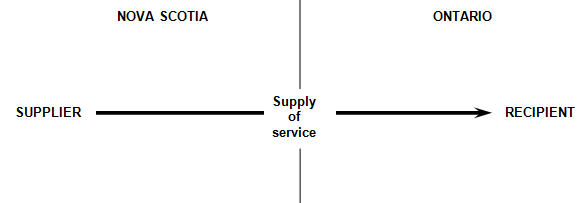
Since the only business address of the recipient in Canada that the supplier obtains in the ordinary course of its business is in Ontario, the supply of the service is made in Ontario and subject to HST at a rate of 13%.
Example 90
An individual who is resident in Quebec hires an architect in Ontario to design a plan for a home that the individual intends to eventually build somewhere in Canada. The only address of the individual that the architect obtains in the ordinary course of its business is the individual's home address in Quebec.
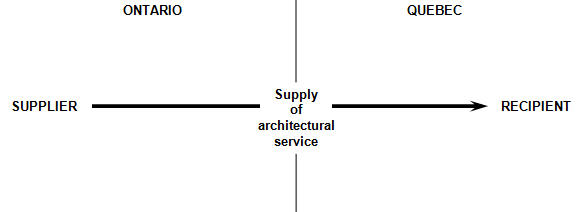
Because the only home address of the recipient in Canada that the supplier obtains in the ordinary course of its business is in Quebec, the supply of the service is made in Quebec and is subject to GST at a rate of 5%.
(B) Multiple business or home addresses in Canada obtained
(Paragraph 13(1)(b) of Division 3 of Part 1 of the Regulations)
Paragraph (B) of Rule 1 provides that if the supplier obtains more than one business or home address in Canada of the recipient described in paragraph (A), the supply of the service is made in the province in which the business or home address that is most closely connected with the supply is located.
A supplier can obtain multiple business addresses of the recipient in the ordinary course of its business. To the extent that the obtained addresses of the recipient do not vary (as is typically the case for online suppliers), the relevant address of the recipient for purposes of the place of supply rule should also not vary. However, if the addresses of the recipient vary from supply to supply, the relevant address may also vary for purposes of the place of supply rule. Since the business or home addresses obtained by each supplier can vary, the address that is most closely connected with the supply is not necessarily the same for all suppliers, or the same for all suppliers in a given industry, or even the same with respect to all supplies made by the same supplier. The determination of the relevant address in respect of a supply under this place of supply rule is made according to the ordinary business practice of each supplier with respect to each supply.
The rule does not provide the option of selecting a particular address of the recipient among several addresses obtained in the ordinary course of business of the supplier. Rather, the rule requires a determination of the address of the recipient that is most closely connected with the supply where multiple addresses are obtained.
The business address of the recipient from which the supplier is hired pursuant to the agreement for the supply (the "contracting address") is generally the address that is most closely connected with the supply. This address will therefore determine the province in which the supply of the service is made where it is in Canada and is obtained by the supplier in the ordinary course of its business. The determination of the place of supply can therefore be made with certainty at the time the supply is first made where the contracting address is identified in the agreement for the supply or, if it is not identified in the agreement, has otherwise been obtained by the supplier in the ordinary course of its business. Where the recipient is a corporation, the contracting address could be the corporation's head office.
If the contracting address of the recipient is not obtained, the address most closely connected with the supply would be the business address of the recipient that the supplier has the most contact with and that the supplier mostly uses in connection with the supply.
Example 91
A corporation has its head office in Ontario and offices across Canada. The head office contracts with a supplier based in Ontario to provide the corporation with written advice in the form of a written legal opinion. In performing the service, the supplier who has contact only with employees from the head office sends the written advice to the head office. In keeping with its ordinary business practice, the corporation requests that the invoice for the service be sent to a business address of the corporation in Alberta where its accounts payable department is located.
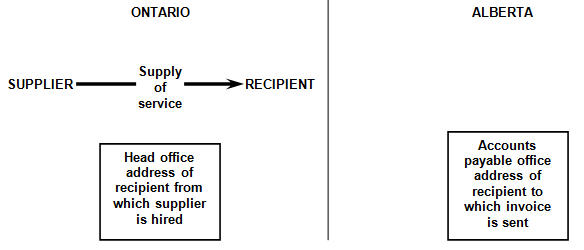
The supplier has obtained two business addresses of the recipient in Canada in the ordinary course of its business: one in Ontario and one in Alberta. The business address of the recipient that is most closely connected with the supply is the business address of the head office in Ontario. The supply of the service is therefore made in Ontario and subject to HST at a rate of 13%.
Example 92
The facts in this example are the same as in Example 91 except that the supplier is instructed by the head office to work with the British Columbia office of the corporation and to provide that office with the advice. As a result, the supplier then only deals with the British Columbia office with respect to the supply, including attending several meetings at the British Columbia office.
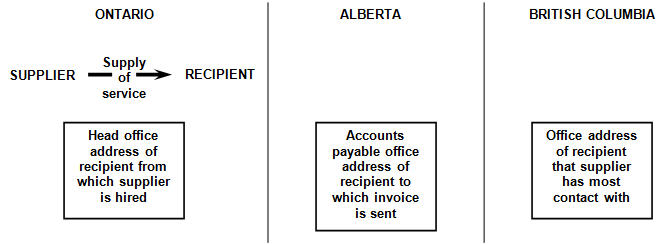
The supplier has obtained three business addresses of the recipient in Canada in the ordinary course of its business: a business address in Ontario, one in Alberta and one in British Columbia. The business address of the recipient that is most closely connected with the supply is the business address of the head office in Ontario from which the supplier is hired. The supply of the service is therefore made in Ontario and subject to HST at a rate of 13%.
Example 93
The facts in this example are the same as in Example 91 except that the supplier, who ordinarily deals with the head office of the corporation in Ontario, is instead contracted by a Quebec office of the corporation that decides to hire the supplier to provide it with legal advice. The Quebec office negotiates and establishes the terms of the agreement with the supplier. The supplier then only deals with the Quebec office in connection with the supply.
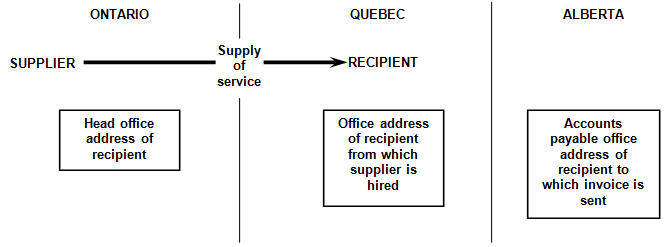
The supplier has obtained three business addresses of the recipient in Canada in the ordinary course of its business: a business address of the head office in Ontario, one in Alberta and one in Quebec. The business address of the recipient that is most closely connected with the supply is the business address of the Quebec office. The supply of the service is therefore made in Quebec and subject to GST at a rate of 5%.
Example 94
A corporation has its head office in Ontario and offices across Canada. The head office decides to hire an accounting firm to supply the corporation with accounting services. The head office negotiates and establishes all of the terms of the agreement for the supply with the supplier. The head office directs the Alberta office of the corporation to which the invoice is sent to also sign the agreement with the supplier in Alberta. The address of the head office in Ontario and the office in Alberta are the only two business addresses of the corporation that the supplier obtains in the ordinary course of its business.
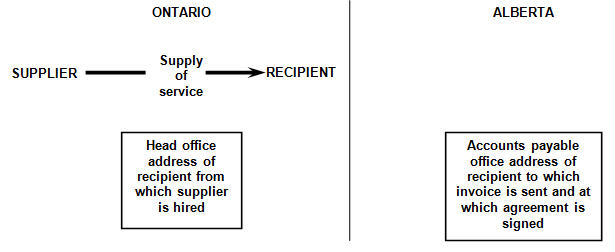
The supplier has obtained two business addresses of the recipient in Canada in the ordinary course of its business: one in Ontario and one in Alberta. The business address of the recipient that is most closely connected with the supply is the business address in Ontario from which the supplier is hired. The supply of the service is therefore made in Ontario and subject to HST at a rate of 13%.
Example 95
A corporation has its head office in Ontario and regional offices across Canada. The head office enters into a global framework agreement with a consulting firm in Alberta with respect to the supply of various consulting services. The framework agreement sets out definitions, the extent of liabilities of the parties, confidentiality obligations, performance standards, dispute resolution, and general payment terms. The business address of the head office is included in the framework agreement. The framework agreement does not constitute an agreement for the supply of any specific services and does not impose any obligation on either party to acquire or supply any services in the future. Instead, each regional office determines the specific services that it requires from the consulting firm and issues a purchase order to the supplier to obtain those services. Each purchase order adopts the terms contained in the framework agreement and constitutes the agreement for the supply of the services for which it is issued. The purchase orders include the business address of the regional office from which they are issued. The New Brunswick regional office of the corporation issues a purchase order to the consulting firm in Alberta for the supply of consulting services that it requires.
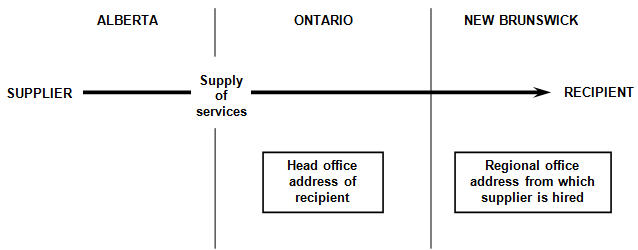
With respect to the supply of the services made to the corporation, the supplier has obtained more than one business address of the recipient in Canada in the ordinary course of its business. This includes the address of the head office in Ontario and the address of the New Brunswick regional office from which the purchase order is issued. The business address of the recipient that is most closely connected with the supply is the business address in New Brunswick from which the supplier is hired. The supply of the services is therefore made in New Brunswick and subject to HST at a rate of 13%.
Example 96
An accounting firm in Ontario is hired by a mutual fund trust in Ontario to provide accounting services. In the ordinary course of its business, the accounting firm has obtained various addresses in connection with the supply including the business address of the trust in Ontario, an address in Nova Scotia of the sponsor of the trust and an address in Quebec of the trustee of the trust to which invoices for the services are sent.
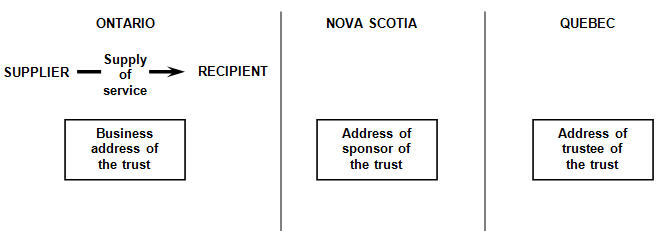
The business address of the recipient in Canada obtained by the supplier in the ordinary course of its business that is most closely connected with the supply is the business address of the trust in Ontario from which the supplier is hired. The supply of the service is therefore made in Ontario and subject to HST at a rate of 13%.
(C) Address in Canada other than a business or home address obtained
(Paragraph 13(1)(c) of Division 3 of Part 1 of the Regulations)
Paragraph (C) of Rule 1 further provides that if the supplier does not obtain a home or business address in Canada of the recipient in the ordinary course of its business, but in the ordinary course of business of the supplier, the supplier obtains another address in Canada of the recipient, the supply is made in the province in which the address that is most closely connected with the supply is located.
For purposes of this part of the rule, there is no requirement for the address of the recipient to be an address at which the recipient is located.
The types of addresses that could fall under this part of the rule could include an address of the recipient such as a billing address. The address must be obtained by the supplier for a legitimate underlying business reason. This address may correspond to an address that is in fact a business address or home address of the recipient but that the supplier does not know is a business or home address because it is not the supplier's ordinary business practice to obtain this type of address. For instance, this could be the case where the supplier does not require recipients to identify the address as being a business or a home address.
General Rule 2 – No address in Canada obtained
(Subsection 13(2) of Division 3 of Part 1 of the Regulations)
Rule 2A – Canadian element not performed primarily in participating provinces
(Paragraph 13(2)(b) of Division 3 of Part 1 of the Regulations)
If Rule 1 does not deem the supply of the service to be made in a province and the Canadian element of the service is not performed primarily in participating provinces, the supply is made in a non-participating province.
Rule 2B – Participating province of greatest proportion of performance
(Subparagraph 13(2)(a)(i) of Division 3 of Part 1 of the Regulations)
Unlike Rule 1 which is generally based on the location of an address in Canada of the recipient, Rule 2 is generally based on where the service is performed. If Rule 1 does not deem the supply of the service to be made in a province and the Canadian element Footnote 7 of the service is performed primarily Footnote 8 in participating provinces, the supply is made in a participating province if an equal or greater proportion of the Canadian element of the service is not performed in another participating province.
Although the word "performed" is not defined in the Act, the place where a service is performed is traditionally the place where the person physically doing the work is situated at the time the work is being conducted. For example, if a supplier in a non-participating province sends a technician to a participating province to provide programming services, the service is considered to be performed in the participating province since the service is physically performed in that province.
Where all of the activities carried out by the supplier in performing a service are clearly undertaken in a province (i.e., the employees performing the service are in the province, or the supplier's equipment used to provide the service is located in the province), the place of performance of the service is in the province.
Where part of the activities carried out by the supplier in performing a service are carried out in a province, the place of supply of the service can be considered to be in the province. For example, a supplier may prepare a report in a province in respect of programming services carried on outside the province. As the report is a component of the services supplied, the place where the report is prepared must be considered when determining the place of supply.
Electronic commerce allows services to be provided remotely. A supplier can provide a service to a customer in another province without physically being in that other province. For example, a supplier can have a technician perform work from a province by electronically accessing a customer's computer located in another province, rather than sending the technician to the other province. Work is being performed both at the location of the service provider, as well as the location of the customer's property that is the object of the service. It is therefore necessary to take into account the location of the customer's property when determining the place of performance.
Whether a service is performed in whole or in part in a province is a question of fact. Each supply of a service must be examined on a case-by-case basis to determine whether that service is performed in whole or in part in a province. However, a supply of a service is performed at least in part in a province if:
- the service requires a person to perform a task (i.e., the supplier acts through one or more of its employees), and the person performing or physically carrying out the task is situated in the province at the time the activity is done;
- the service includes operations performed by a supplier's equipment (e.g., computer equipment), and the equipment is located in the province;
- the supply involves doing something to or with a recipient's equipment by accessing it from a remote location, and the recipient's equipment is located in the province (however, this does not apply to a service wholly performed outside the province, where the results are subsequently delivered electronically to a recipient's computers in another province, e.g., a programming service carried out at the supplier's location in a province and e-mailed to a recipient in another province); or
- any activity related to the performance of the service is undertaken in the province.
Example 97
An online service provider located in Ontario that specializes in the provision of document editing and translation services, provides these services to clients electronically over the Internet. A client in Saskatchewan sends its original documents by e-mail to the e-mail address of the service provider who returns the resulting edited or translated documents to the client's e-mail address. The services are performed by employees of the service provider from its business address in Ontario. The service provider does not obtain an address of its clients.
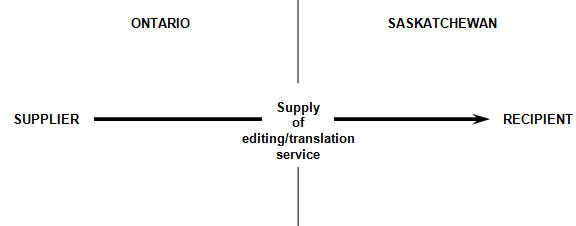
The Canadian element of the service is performed primarily in the participating provinces and the participating province in which the greatest proportion of the Canadian element of the service is performed is Ontario. Therefore, the supply is made in Ontario and subject to HST at a rate of 13%.
Rule 2C – Highest tax rate
(Subparagraph 13(2)(a)(ii) of Division 3 of Part 1 of the Regulations)
If Rule 2B does not deem the supply of a service to be made in a participating province because the service is performed equally in two or more participating provinces, the service is supplied in the participating province that has the highest tax rate among the participating provinces for which no greater proportion of the service is performed in another participating province.
General Rule 3 – Same highest tax rate
(Section 18 of Division 3 of Part 1 of the Regulations)
If a supply of a service cannot be determined under Rule 2C to be made in a single participating province because the highest tax rates for two or more participating provinces are the same, the supply is made in the specified province among those provinces where the business address of the supplier that is most closely connected with the supply is located or, if such an address is not located in one of the specified provinces, in the specified province that is closest in proximity, determined in any reasonable manner, to the business address of the supplier that is most closely connected with the supply.
Personal services
(Sections 17 and 18 of Division 3 of Part 1 of the Regulations)
In certain circumstances, there are specific place of supply rules that can apply to the supply of a personal service, which is generally a service that is all or substantially all Footnote 9 performed in the presence of the individual to whom it is rendered. A personal service can include a service that is all or substantially all performed in the presence of a group of individuals to whom the service is rendered.
The specific place of supply rule for personal services does not apply to the supply of an advisory, consulting or professional service. These services are generally subject to the general place of supply rules for services, unless another specific rule applies to them.
An advisory service means a service of giving an opinion, or counsel, or of recommending a plan or course of action.
A consulting service means a service of providing information, instruction or expert advice. A consultant generally provides services relating to a field of specialized knowledge or training.
An advisory or consulting service may address business, management, marketing, data processing, public relations or other issues or problems faced by the client. An advisory or consulting service is not considered to include any work that might be undertaken or performed as a result of the plans or recommendations accepted by the client or the advice provided to the client.
A professional service is generally defined in terms of the individual providing the service. If the person making the supply of the service is other than an individual, for example, a partnership or company, the status of the individual professional or professionals assigned to provide the service will be considered in determining whether the service is a professional service.
A professional service refers to a service provided by an individual whose vocation or occupation requires special, usually advanced, education and skills. The individual providing the service may be a member of a professional association, a professional corporation or a similar body, which is recognized by a statute in at least one province or territory or by one federal body, and which enforces standards of professional practice as well as a code of ethics. However, a professional service will be considered to include the services provided by articling or other students and support staff, to the extent that their services are intended to assist the professional in the provision of the professional's service and are undertaken under the supervision of the professional.
Finally, the duties and labour performed in the provision of the professional service must be related to the vocation or occupation of the individual.
Rule 1
If all or substantially all of a service is performed in the presence of the individual to whom it is rendered and the Canadian element of the service is not performed primarily Footnote 10 in participating provinces, the supply is made in a non-participating province.
Rule 2
A supply of a service that is all or substantially all Footnote 11 performed in the presence of the individual to whom it is rendered is made in a participating province if the Canadian element of the service is performed primarily in participating provinces and an equal or greater proportion of the service is not performed in another participating province.
Generally, a supply of a service that is performed in the presence of the individual to whom it is rendered but that is not performed all or substantially all in the presence of the individual is subject to the general place of supply rules for services unless another specific rule applies.
Rule 3
If the above rule does not result in the supply of the service being made in a participating province because the service is equally performed in two or more participating provinces, the supply is made in the participating province among those provinces that has the highest tax rate for which no greater proportion of the service is performed in another participating province.
Rule 4
If a supply of a service cannot be determined under the above rule to be made in a single participating province because the highest tax rates for two or more of the participating provinces (each of which is referred to here as a "specified province") are the same, the supply is made in the specified province among those provinces where the business address of the supplier that is most closely connected with the supply is located or, if such an address is not located in one of the specified provinces, in the specified province that is closest in proximity, determined in any reasonable manner, to the business address of the supplier that is most closely connected with the supply.
Example 98
An individual in Newfoundland and Labrador receives a hairdressing service at a hair salon in Newfoundland and Labrador.

The service is performed entirely in Newfoundland and Labrador in the presence of the individual to whom the service is rendered. Therefore, the supply of the service is made in Newfoundland and Labrador and subject to HST at a rate of 13%.
Example 99
An individual provides the service of private dance instruction to individuals in her home in Saskatchewan.

The services are performed entirely in Saskatchewan in the presence of the individuals to whom they are rendered. Therefore, the supply of the service is made in a non-participating province and subject to GST at a rate of 5%.
Example 100
A resident of Ontario gets a massage in Quebec. In the ordinary course of business, the supplier obtains the home address of its clients.
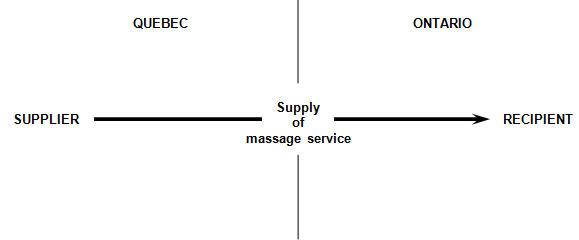
The service that is performed entirely in the presence of the individual in Quebec is performed otherwise than primarily in the participating provinces. Therefore, the supply is made in a non-participating province and subject to GST at a rate of 5%.
Example 101
An individual in New Brunswick hires a personal fitness trainer in Quebec to provide her with overall fitness training in New Brunswick. Approximately 95% of the service requires the trainer to be in her presence while she is performing physical exercises. The other 5% of the service which is not performed in her presence requires the trainer to prepare and provide her a summary sheet of her weekly progress.
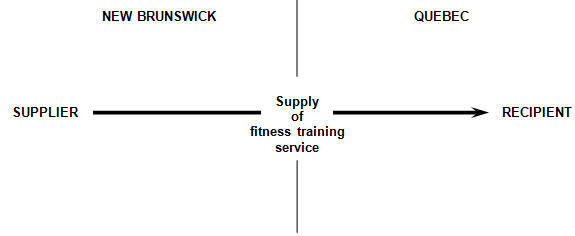
The service that is performed all or substantially all in the presence of the individual is performed primarily in participating provinces and the greatest proportion of the service performed in participating provinces is performed in New Brunswick. Therefore, the supply is made in New Brunswick and subject to HST at a rate of 13%.
Example 102
An Ontario company provides a guided tour of the National Capital Region to a group of residents from Quebec, 80% of which is performed in Ontario and 20% in Quebec. The supplier accompanies the visitors throughout the tour.
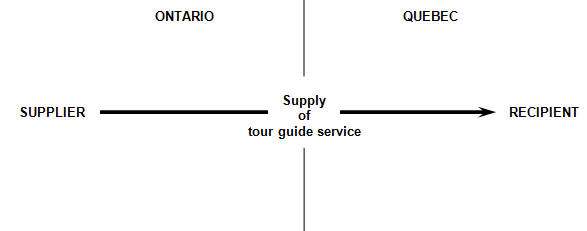
The service that is performed all or substantially all in the presence of the visitor is performed primarily in participating provinces and the greatest proportion of the service performed in participating provinces is performed in Ontario. Therefore, the supply is made in Ontario and subject to HST at a rate of 13%.
Services in relation to tangible personal property and real property
There are specific place of supply rules that apply to services in relation to tangible personal property and services in relation to real property. The rules therefore require a determination of whether a supply of a service is in relation to tangible personal property or in relation to real property.
Whether a service is considered to be in relation to tangible personal property or real property depends on whether there is a direct connection between the service and the property taking into account the objective of the service and the particular circumstances of each case. There are several guidelines that are used to determine whether there is a direct connection between a service and tangible personal property or real property.
It must first be determined whether the service is designed, developed or undertaken to fulfill or serve a particular need or requirement arising from or relating to the property. This guideline involves determining the purpose or objective of the service. The purpose or objective of the service may often be determined by examining a written contractual agreement for the supply between the supplier and the recipient of the service. If there is no formal written agreement, other documentation, such as purchase orders, correspondence between the parties or invoices or receipts may be useful in establishing the purpose or objective of the service.
It must then be determined whether the relationship between the purpose or objective of the service and the property is direct rather than merely indirect. If something else comes between the service and the property, the connection will not be considered to be direct.
A service and property would generally be regarded as being in relation to each other pursuant to the above guidelines if the purpose of a service is to:
- physically count the property,
- appraise or value the property,
- physically protect or secure the property, or
- enhance the value of the property.
Similarly, if the service is aimed at effecting or dealing with the transfer of ownership of, claims on or rights to the property, or determining title to the property, the service will generally be regarded as being in relation to the property.
Finally, in order for a service to be considered a service in relation to particular tangible personal property or real property that is situated at a particular location, and in order to apply the place of supply rules for these types of services, the service must relate to specific property that can be determined to be situated at a particular location at a particular time. If the service does not relate to specific property, the service will generally be considered to be a service that is subject to the general place of supply rules for services.
Services in relation to tangible personal property
(Sections 15, 16 and 18 of Division 3 of Part 1 of the Regulations)
The application of the specific rules that apply to supplies of services in relation to tangible personal property is generally based on whether the property remains in the same province while the service is performed.
Generally, in order to apply these place of supply rules, it is necessary to determine where the tangible personal property is situated when the service begins to be performed and while the service is performed. In cases where it is not possible for a supplier to make such a determination, the supply of the service is generally subject to the general place of supply rules for services.
The place of supply rules for services in relation to tangible personal property are subject to the specific place of supply rules explained below that apply in certain circumstances with respect to specific types of services including repair, maintenance and cleaning services.
Tangible personal property remains in the same province while the service is performed
(Section 15 of Division 3 of Part 1 of the Regulations)
Rule 1
A supply of a service in relation to tangible personal property that is situated in one or more provinces at the particular time when the Canadian element of the service begins to be performed and that at all times when the Canadian element of the service is performed, remains in the province in which it was situated at the particular time, is made in a non-participating province if at the particular time the tangible personal property is not situated primarily in participating provinces.
Example 103
A company in Alberta hires an Ontario company to count its inventory that is entirely situated in Alberta when the inventory count service begins to be performed.
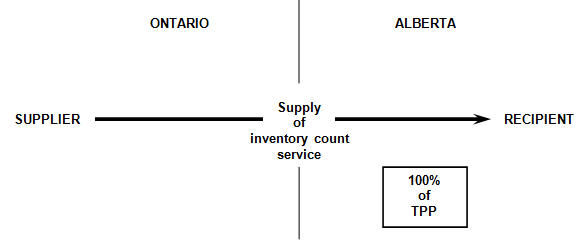
The inventory is not situated primarily in participating provinces when the service begins to be performed. Therefore, the supply of the service is made in a non-participating province and is subject to GST at a rate of 5%.
Rule 2
A supply of a service in relation to tangible personal property that is situated in one or more provinces at the particular time when the Canadian element of the service begins to be performed and that at all times when the Canadian element of the service is performed, remains in the province in which it was situated at the particular time, is made in a participating province if at the particular time:
- the property is situated primarily in participating provinces, and
- an equal or greater proportion of the property is not situated in another participating province.
Example 104
A veterinary hospital in Ontario conducts a regular examination of a household pet at the hospital.

The pet is in Ontario when the veterinarian service begins to be performed and remains in Ontario while the service is performed. Therefore, the supply of the service is made in Ontario and subject to HST at a rate of 13%.
Example 105
A consumer in Ontario hires a supplier of furniture repair services in Ontario to repair a piece of antique furniture at the consumer's home in Ontario. The furniture remains at the consumer's home while the repair service is performed.

The furniture is situated in Ontario when the service begins to be performed and remains in Ontario while the service is performed. Therefore, the supply of the service is made in Ontario and subject to HST at a rate of 13%.
Example 106
A manufacturer in Alberta sends parts to a company in Ontario to anodize the parts. The manufacturer ships the parts to the company in Ontario. The company in Ontario later ships the anodized parts back to the manufacturer in Alberta.

The parts are situated in Ontario when the service begins to be performed and remain in Ontario while the anodizing service is performed. Therefore, the supply of the anodizing service is made in Ontario and subject to HST at a rate of 13%.
Example 107
For a single storage fee, a national company headquartered in Ontario is hired by a Quebec company to store its art collection in a specialized manner for a year. Of the total collection, 40% is situated in Quebec when the service begins to be performed and remains stored in Quebec throughout the year and the remaining 60% is situated in Ontario when the service begins to be performed and remains stored in Ontario throughout the year.
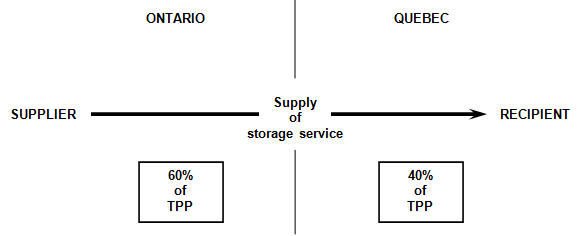
The tangible personal property is situated in Quebec and Ontario when the service begins to be performed and remains situated in those provinces while the service is performed. Furthermore, the tangible personal property is situated primarily in the participating provinces when the storage service begins to be performed and the participating province in which the greatest proportion of the property is situated at that time is Ontario. Therefore, the supply of the service is made in Ontario and subject to HST at a rate of 13%.
Example 108
A law firm in Quebec is hired by a company in Nova Scotia to supply a legal service that consists of drafting an agreement for the sale of industrial equipment that is owned by the Nova Scotia company. The equipment is situated in Nova Scotia while the service is performed.
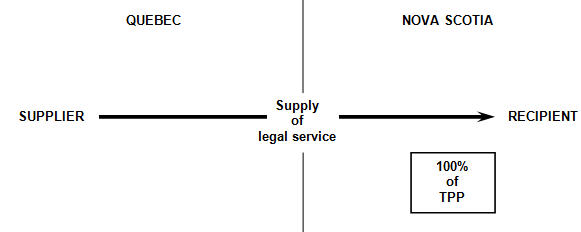
The equipment is situated in Nova Scotia when the service begins to be performed and remains situated in that province while the service is performed. Therefore, the supply of the service is made in Nova Scotia and subject to HST at a rate of 15%.
Example 109
A sales representative in Ontario is hired by a manufacturer in New Brunswick to sell specific excavation equipment that is owned by the manufacturer that is situated at its plant in New Brunswick. The equipment remains situated in New Brunswick while the service is performed.
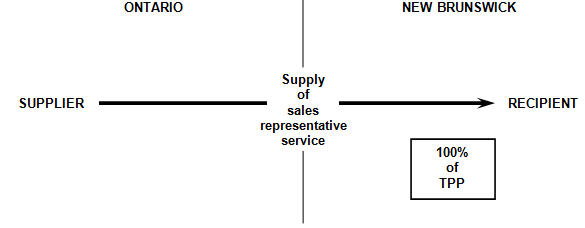
The equipment is situated in New Brunswick when the service begins to be performed and remains situated in that province while the service is performed. Therefore, the supply of the service is made in New Brunswick and subject to HST at a rate of 13%.
Example 110
A law firm in Alberta is hired by a company in Ontario to supply a legal service that consists of drafting a single agreement for the sale of some tangible personal property and real property that is to be sold by the Ontario company to a Quebec company. The tangible personal property is situated primarily in Alberta and the real property is situated primarily in Ontario while the service is performed. The only business address of the Ontario company that is obtained by the law firm in the ordinary course of its business is in Ontario.
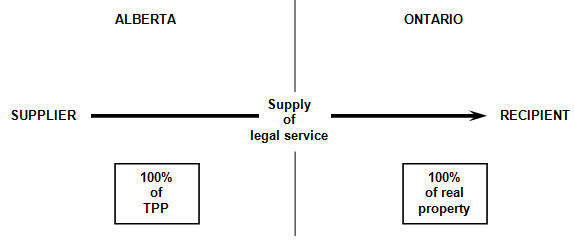
The law firm is making a supply of a general service, integral elements of which are services relating to tangible personal property and to real property. Therefore, the place of supply of the service is not determined by the place of supply rules for services in relation to tangible personal property or for services in relation to real property. Since the only business address of the recipient in Canada that the supplier obtains in the ordinary course of its business is in Ontario, the supply of the service is made in Ontario and subject to HST at a rate of 13%.
Rule 3
If Rule 2 does not result in the supply of the service being made in a participating province because the greatest proportions of the tangible personal property are equally situated in two or more participating provinces, the service is supplied in the participating province among those provinces that has the highest tax rate.
Example 111
A national appliance repair company based in Ontario is hired by a British Columbia company to provide appliance repair services for a flat fee in respect of tangible personal property that is situated in three provinces when the service begins to be performed and remains situated in those provinces when the service is performed. 40% of the tangible personal property is situated in Ontario, 40% in British Columbia and 20% in Alberta. The repairs are undertaken at the locations where the tangible personal property is situated.
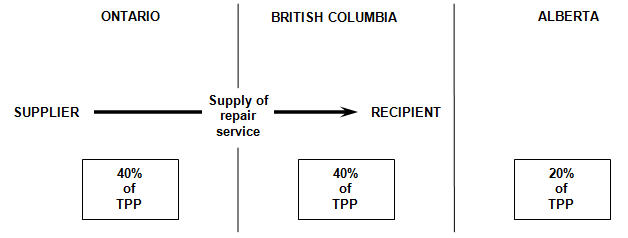
The tangible personal property is situated in Ontario, British Columbia and Alberta when the service begins to be performed and remains situated in those provinces while the service is performed. Furthermore, the tangible personal property in Canada is situated primarily in participating provinces and the greatest proportions of that tangible personal property are situated in Ontario and British Columbia. The tax rate for Ontario is higher than the tax rate for British Columbia. As a result, the place of supply of the service is made in Ontario and subject to HST at a rate of 13%.
Rule 4
If a supply of a service cannot be determined under Rule 3 to be made in a participating province because the highest tax rates for two or more of the participating provinces (each of which is referred to here as a "specified province") are the same, the supply is made in the specified province among those provinces where the business address of the supplier that is most closely connected with the supply is located or, if such an address is not located in one of the specified provinces, in the specified province that is closest in proximity, determined in any reasonable manner, to the business address of the supplier that is most closely connected with the supply.
Tangible personal property does not remain in same province while the service is performed
((Section 16 of Division 3 of Part 1 of the Regulations)
Rule 1
A supply of a service in relation to tangible personal property that is situated in one or more provinces at the particular time when the Canadian element of the service begins to be performed and that at any time during the period when the Canadian element of the service is performed does not remain in the province in which it was situated at the particular time, is made in a non-participating province if:
- the tangible personal property is not situated primarily in participating provinces at all times when the service is performed, or
- the Canadian element of the service is not performed primarily in participating provinces.
Example 112
An Ontario company is hired by a Quebec company to conduct tests on a vehicle. 60% of the service is performed in Quebec and 40% is performed in Ontario. The vehicle is situated in Quebec when the Quebec proportion of the service is performed and is situated in Ontario when the Ontario proportion of the service is performed. The vehicle is moved from Quebec to Ontario after the Quebec proportion of the service is performed.

The tangible personal property does not remain in the same province while the Canadian element of the service is performed. Furthermore, although the tangible personal property is situated primarily in the participating provinces when the Ontario proportion of the service is performed, the Canadian element of the service is not performed primarily in the participating provinces. As a result, the supply of the service is made in a non-participating province and is subject to GST at a rate of 5%.
Rule 2
A supply of a service in relation to tangible personal property that is situated in one or more provinces at the particular time when the Canadian element of the service begins to be performed and that at any time during the period when the Canadian element of the service is performed does not remain in the province in which it was situated at the particular time, is made in a participating province if:
- the property is situated primarily in participating provinces at any time when the service is performed,
- the Canadian element of the service is performed primarily in participating provinces, and
- an equal or greater proportion of the service is not performed in another participating province.
Example 113
An Ontario company is hired by a Quebec company to conduct tests on a vehicle. 60% of the service is performed in Ontario and 40% in Quebec. The vehicle is situated in Ontario when the Ontario proportion of the service is performed and is situated in Quebec when the Quebec proportion of the service is performed. The vehicle is moved from Ontario to Quebec after the Ontario proportion of the service is performed.
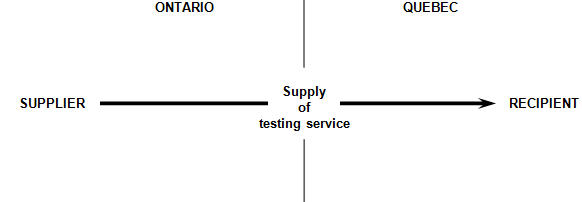
The tangible personal property does not remain in the same province while the service is performed. Furthermore, the tangible personal property is situated primarily in the participating provinces when the Ontario proportion of the service is performed, the Canadian element of the service is performed primarily in participating provinces, and the greatest proportion of the service that is performed in the participating provinces is performed in Ontario. As a result, the supply of the service is made in Ontario and subject to HST at a rate of 13%.
Rule 3
If Rule 2 does not result in the supply of the service being made in a participating province because the greatest proportions of the service are equally performed in two or more participating provinces, the supply is made in the participating province among those provinces that has the highest tax rate.
Rule 4
If a supply of a service cannot be determined under Rule 3 to be made in a participating province because the highest tax rates for two or more of the participating provinces (each of which is referred to here as a "specified province") are the same, the supply is made in the specified province among those provinces where the business address of the supplier that is most closely connected with the supply is located or, if such an address is not located in one of the specified provinces, in the specified province that is closest in proximity, determined in any reasonable manner, to the business address of the supplier that is most closely connected with the supply.
Services in relation to real property
(Sections 14 and 18 of Division 3 of Part 1 of the Regulations)
There are specific place of supply rules that apply to supplies of services in relation to real property.
These place of supply rules require a determination of the proportion of real property that is situated in a province. The determination of the relevant proportion of the real property that is situated in a province is based on the physical size of the entire real property (for example, based on square footage, square yards or acres) pursuant to its legal description. The value of the real property or the number of properties (unless they are of equal size) is not relevant to this determination.
Services in relation to real property situated in Canada and outside Canada
(Section 142)
A supply of a service that relates to real property is deemed to be made in Canada if the real property is situated in Canada and is deemed to be made outside Canada if the real property is situated outside Canada. As a result, where the real property is both situated in Canada and outside Canada, the proportion of the service that relates to the real property that is situated in Canada is considered to be made in Canada and the proportion of the service that relates to the real property that is situated outside Canada is considered to be made outside Canada. As a result, it is only the provision of the proportion of the service that relates to real property that is situated in Canada that may be deemed to be made in a participating province and subject to HST.
Rule 1
A supply of a service in relation to real property that is situated in Canada and that is not situated primarily Footnote 12 in participating provinces is made in a non-participating province.
Example 114
An individual who lives in a mobile home that is situated in Alberta hires a painting company from Alberta to paint the exterior of the mobile home.
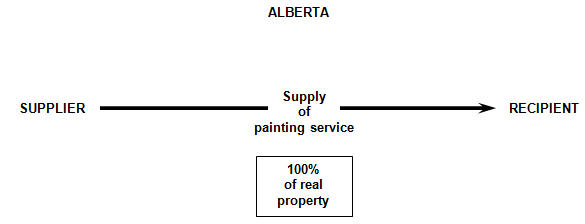
The real property to which the service relates is not situated primarily in participating provinces. Therefore, the supply of the service is made in a non-participating province and subject to GST at a rate of 5%.
Example 115
A company in Quebec hires an architect in Ontario to design an office building to be constructed at a location in Quebec.
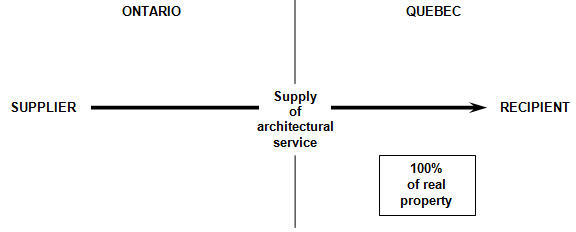
The real property to which the service relates is not situated primarily in participating provinces. Therefore, the supply of the service is made in a non-participating province and subject to GST at a rate of 5%.
Example 116
A Nova Scotia company operates two retail stores, one that is situated in Nova Scotia and one that is situated in Quebec. The company hires a painting company in Nova Scotia to paint the interior of both stores. The properties are of equal size.
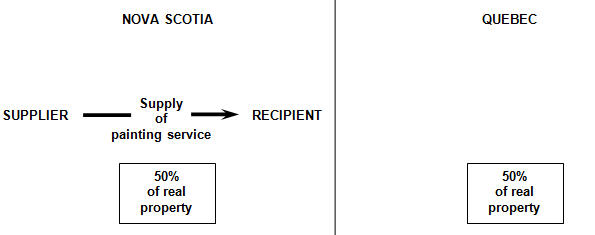
Rule 2
A supply of a service in relation to real property is made in a participating province if the real property that is situated in Canada is situated primarily in participating provinces and an equal or greater proportion of the real property is not situated in another participating province.
Example 117
An Ontario company hires a Quebec company to paint its warehouse that is situated in Ontario.
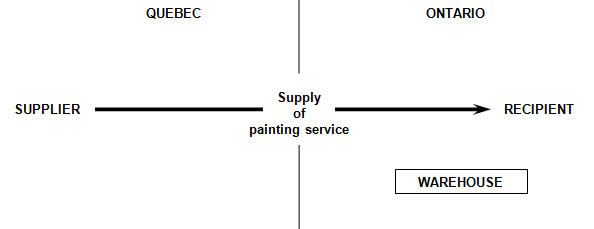
The real property that is situated in Canada to which the service relates is situated primarily in participating provinces and the participating province in which the greatest proportion of the real property that is situated in the participating provinces is situated is Ontario. Therefore, the supply of the service is made in Ontario and subject to HST at a rate of 13%.
Example 118
A company in Ontario hires a company in Saskatchewan to conduct a seismic survey of an area of land that is entirely situated in Saskatchewan.
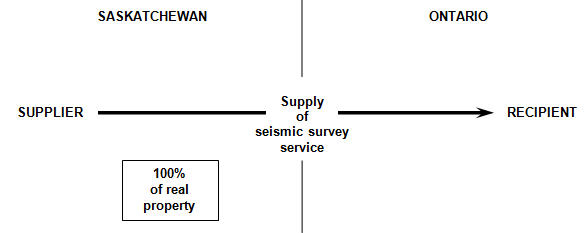
The real property to which the service relates is not situated primarily in participating provinces. Therefore, the supply of the service is made in a non-participating province and subject to GST at a rate of 5%.
Example 119
An individual who lives in Nova Scotia hires a real estate broker in Nova Scotia to sell the individual's home that is situated in Nova Scotia.
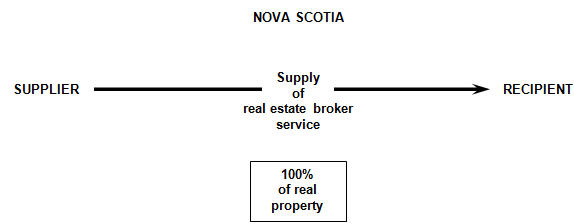
The real property that is situated in Canada to which the service relates is situated primarily in the participating provinces and the participating province in which the greatest proportion of the real property that is situated in the participating provinces is situated is Nova Scotia. Therefore, the supply of the service made by the real estate broker of selling the home is made in Nova Scotia and subject to HST at a rate of 15%.
Example 120
A New Brunswick company hires another New Brunswick company to provide maintenance services with respect to two of its buildings that are situated in New Brunswick and one that is situated in Quebec. The three properties are of equal size.
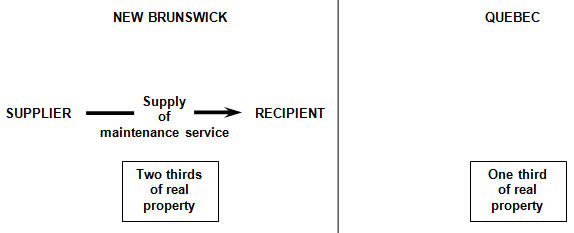
The real property that is situated in Canada to which the service relates is situated primarily in the participating provinces and the participating province in which the greatest proportion of the real property that is situated in the participating provinces is situated is New Brunswick. Therefore, the supply of the service is made in New Brunswick and subject to HST at a rate of 13%.
Example 121
A farmer in Ontario owns land that borders Ontario and the United States. Of the total land, 5% is situated in Ontario and 95% is situated in the United States. The Ontario farmer hires an Ontario company to install an irrigation system in the land to distribute water to areas that include land situated in the United States.
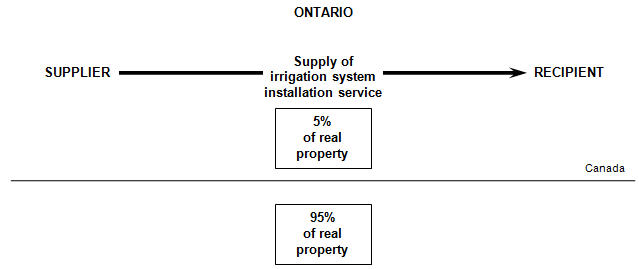
The real property that is situated in Canada to which the service relates (i.e., 5%) is situated primarily in the participating provinces and the participating province in which the greatest proportion of the real property that is situated in the participating provinces is situated is Ontario. Therefore, the proportion of the supply of the service that relates to the real property that is situated in Canada is made in Ontario and subject to HST at a rate of 13%. The proportion of the supply of the service that relates to real property situated outside Canada is deemed to be made outside Canada and is not subject to tax.
Example 122
A company in the United States hires a Quebec company to provide landscaping services in respect of real property, 90% of which is situated in the United States and 10% of which is situated in Ontario.
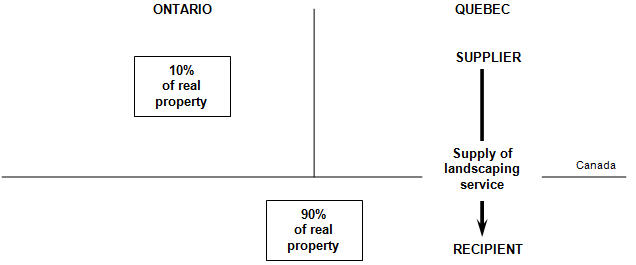
The real property that is situated in Canada to which the service relates (i.e., 10%) is situated primarily in the participating provinces and the participating province in which the greatest proportion of the real property that is situated in the participating provinces is situated in is Ontario. Therefore, the proportion of the supply of the service that relates to the real property that is situated in Canada is made in Ontario and subject to HST at a rate of 13%. The proportion of the supply of the service that relates to real property situated outside Canada is deemed to be made outside Canada and not subject to tax.
Example 123
A company in British Columbia is hired by another British Columbia company to conduct a geological survey of an area of land that borders British Columbia and the United States. Of the total land, 20% is situated in British Columbia and 80% is situated in the United States.

The real property that is situated in Canada to which the service relates (i.e., 20%) is situated primarily in the participating provinces and the participating province in which the greatest proportion of the real property that is situated in the participating provinces is situated in is British Columbia. Therefore, the proportion of the supply of the service that relates to the real property that is situated in Canada is made in British Columbia and subject to HST at a rate of 12%. The proportion of the supply of the service that relates to the real property situated outside Canada is deemed to be made outside Canada and not subject to tax.
Rule 3
If Rule 2 does not result in the supply of the service being made in a participating province because the greatest proportions of the real property are equally situated in two or more participating provinces, the supply of the service is made in the participating province among those provinces that has the highest tax rate.
Example 124
A British Columbia company operates two shopping centres, one that is situated in Ontario and one that is situated in British Columbia. The company hires an engineering firm in British Columbia to evaluate the structural integrity of the concrete in the underground parking garages of the shopping centres. The properties are of equal size.
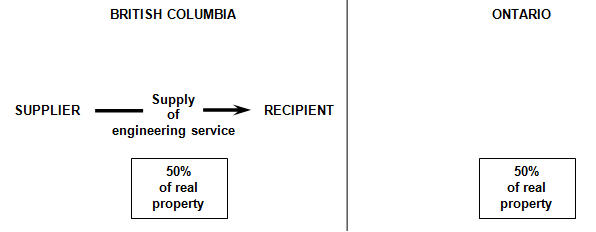
The real property that is situated in Canada to which the service relates is situated primarily in the participating provinces and in equal proportions in the participating provinces of Ontario and British Columbia. Therefore, the supply of the service is made in the participating province among these two provinces that has the highest tax rate, which in this case is Ontario. The supply of the service is made in Ontario and subject to HST at a rate of 13%.
Rule 4
If a supply of a service cannot be determined under Rule 3 to be made in a participating province because the highest tax rates for two or more of the participating provinces (each of which is referred to here as a "specified province") are the same, the supply is made in the specified province among those provinces where the business address of the supplier that is most closely connected with the supply is located or, if such an address is not located in one of the specified provinces, in the specified province that is closest in proximity, determined in any reasonable manner, to the business address of the supplier that is most closely connected with the supply.
Example 125
A company in Newfoundland and Labrador hires an Ontario company to conduct an inspection of real property. Of the total real property, one third is situated in Ontario, one third is situated in Newfoundland and Labrador and one third is situated in British Columbia.
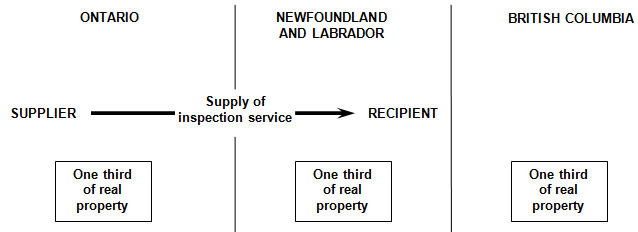
The real property that is situated in Canada to which the service relates is situated primarily in the participating provinces and in equal proportions in the participating provinces of Ontario, Newfoundland and Labrador and British Columbia. Ontario and Newfoundland and Labrador have the same highest tax rate among the three participating provinces in which the real property is situated. As a result, the supply is made in the province among these two provinces where the business address of the supplier that is most closely connected with the supply is located, which in this case is Ontario. The supply is therefore subject to HST at a rate of 13%.
Services in relation to a location-specific event
(Section 28 of Division 5 of the Regulations)
There is a specific place of supply rule that applies to supplies of services that relate to a location-specific event. A supply of a service in relation to a performance, athletic or competitive event, festival, ceremony, conference, or similar event is made in a province if the service is to be performed primarily at a location of the event in the province. Generally, if the conditions for the application of this place of supply rule are not met, the supply of the service is subject to the general place of supply rules for services.
The fact that a service is performed at the location of an event does not mean that it relates to the event. To be considered to be a service in relation to a location-specific event, there must be a direct connection between the service and the event. Specifically, the object of the service must be the event itself and not something else. Generally, this would include services supplied to an organizer of an event, such as event planning and the performance of the event.
The list of events in the Regulations is not exhaustive. However, the event must be one that is similar in nature to the events that are listed in the rule.
Example 126
A Quebec music group agrees to play music at a concert at an outdoor venue in Ontario.
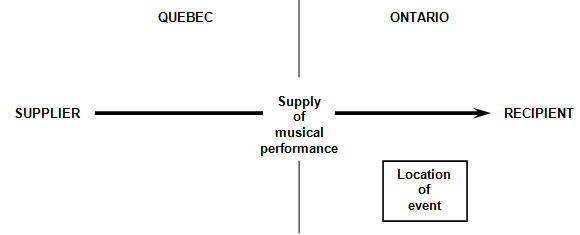
The service relates to a performance and is to be performed entirely at the location of the event in Ontario. Therefore, the supply of the service is made in Ontario and subject to HST at a rate of 13%.
Example 127
An audio-visual company in Ontario is hired by a Quebec company to provide lighting and other special effects at a gala event in Quebec. The services will be performed at the convention centre in Quebec where the gala will take place.
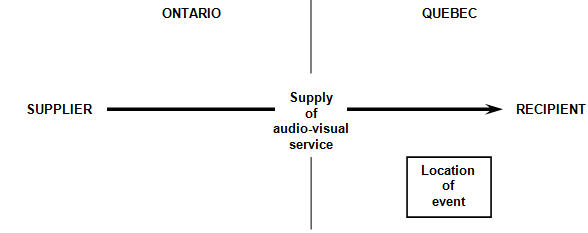
The service relates to a performance and is to be performed entirely at the location of the event in Quebec. Therefore, the supply of the service is made in Quebec and subject to GST at a rate of 5%.
Example 128
A wedding planning company located in Alberta supplies a service of planning a wedding to be held in British Columbia to a recipient in Alberta. Approximately 60% of the service is to be performed in British Columbia at the wedding location and 40% in Alberta.

The service relates to a ceremony and is to be performed primarily at the location of the ceremony in British Columbia. Therefore, the supply of the service is made in British Columbia and is subject to HST at a rate of 12%.
Example 129
An Ontario musician is hired by an individual in Manitoba to perform at a funeral in Manitoba.
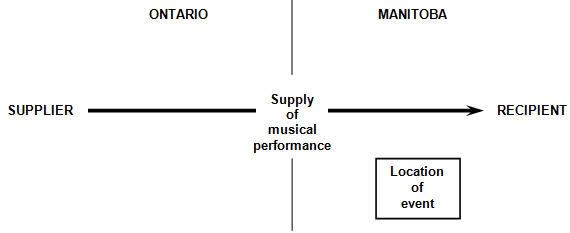
The service relates to a performance and is to be performed entirely at the location of the event in Manitoba. Therefore, the supply of the service is made in Manitoba and subject to GST at a rate of 5%.
Services rendered in connection with litigation
(Section 27 of Division 5 of Part 1 of the Regulations)
A supply of a service that is rendered in connection with criminal, civil or administrative litigation in a province (other than a service rendered before the commencement of such litigation) that is under the jurisdiction of a court or other tribunal established under the laws of a province, or in the nature of an appeal from a decision of a court or other tribunal established under the laws of a province, is made in that province. A supply of such a service rendered before the commencement of such litigation is subject the general place of supply rules for services.
Commencement of Criminal, Civil or Administrative litigation
Criminal litigation
Criminal litigation generally commences on the day an "information", for Summary Conviction Proceedings, or an "indictment", for Indictable Offences, is filed or sworn with the court. The resulting laying of the complaint, charge or accusation has the effect of crystallizing the commencement of criminal litigation.
Civil litigation
Civil litigation generally commences on the day that the originating process (i.e., Statement of Claim, Writ of Summons in the province of Quebec, Notice of Application, Petition, etc.) is filed with the court in accordance with the rules of civil procedure in a particular provincial or territorial jurisdiction.
Administrative litigation
The time when the administrative litigation commences will normally be based on the procedural requirements imposed by the relevant legislation, or the "rules" of natural justice if no legislation exists, under which the administrative litigation will be brought.
The following are events that are considered to constitute the commencement of administrative litigation:
- Section 10 of the Competition Act states that the Commissioner of Competition shall conduct an inquiry into allegations brought forth by a complainant. The day the Commissioner receives the complaint will be the day on which administrative litigation commences.
- The date on which a notice, appeal, application, request, etc. is received by the administrative body. For example, where a neighbourhood association disputes a new municipal by-law that will allow for the development of a parking lot on land reserved for recreational activities, the litigation will have commenced on the day the association files its brief with the provincial Municipal Board.
- The date on which the Board or Tribunal's clerk or registrar receives a copy of the application or complaint. For example, where a taxpayer initiates an appeal to an assessment with the Tax Court of Canada, litigation will have commenced on the day the registrar of the Tax Court accepts receipt of the appeal, etc.
- The date on which the aggrieved party files a complaint with a Board. For example, where a tenant wishes to object to a landlord's rent increase before a Rent Control Hearings Board, litigation will have commenced on the day the tenant lodges his objection or complaint with the Board.
- Where no specific statutory procedure dictates the date on which litigation commences, under these circumstances, litigation will be considered to have commenced on the day a board, body or agency which is empowered or authorized to act is made aware of a complainant's intentions.
Meaning of the expression "in connection with" criminal, civil or administrative litigation
The expression "in connection with" generally means that there is a relation between things, one of which is bound up with, involved in another, or again having to do with. The words include matters occurring prior to as well as subsequent to or consequent upon, as long as they are related to the principal thing. However, before a service can be considered to be "in connection with" litigation, there should be evidence to the effect that from a particular point in time the object of the supplier's services directly relates to the intended or contemplated legal or administrative proceedings for litigation purposes.
For greater certainty, the following guidelines are considered to determine whether the services rendered are in connection with criminal, civil or administrative litigation:
- Was the service designed, developed or undertaken to meet the need or requirement arising from criminal, civil or administrative litigation? In other words, were the services rendered in order to comply with the rules of criminal, civil or administrative procedure?
- Is the relationship between the purpose or object of the service and litigation sufficiently close? For example, in preparation for the trial, a lawyer consults with a specialist on maritime law to confirm whether he can act as an expert witness on the client's behalf. Since the purpose of the consultation is to enable the lawyer to obtain a witness necessary to advance his client's case, a reasonable functional relationship exists between the legal service and litigation.
- In criminal matters, the supply of most if not all of the legal services made by a defence lawyer in a specific case would usually be in connection with criminal litigation; the object and purpose of the services directly relate to criminal matters.
- Documentation such as copies of agreements, requests for advisory, professional or consulting services, the supplier's accounting records, demand letters, copies of objections or appeals, etc., would usually indicate the purpose or objective of the service rendered in relation to civil or administrative proceedings.
Example 130
An Ontario company hires a law firm headquartered in British Columbia to defend the company in connection with civil litigation in Ontario that is under the jurisdiction of a court established under the laws of Ontario. The service will be performed primarily in Ontario.

The service is rendered in connection with civil litigation in Ontario that is under the jurisdiction of a court established under the laws of Ontario. Therefore, the supply of the service is made in Ontario and subject to HST at a rate of 13%.
Example 131
An individual from Manitoba receives a speeding ticket in Ontario. She hires a lawyer from Ontario to represent her in connection with the litigation of the case in Ontario that is under the jurisdiction of a court established under the laws of Ontario.
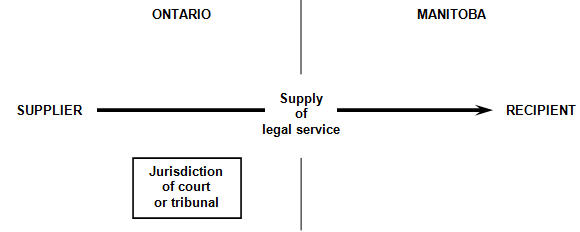
The service is rendered in connection with litigation in Ontario that is under the jurisdiction of a court established under the laws of Ontario. Therefore, the supply of the service is made in Ontario and subject to HST at a rate of 13%.
Example 132
A business located in British Columbia retains the services of a law firm in Ontario for guidance regarding a potential civil action against a customer that is situated in Ontario. It is the ordinary course of business of the law firm to obtain a business address of its clients. In this case, the customer's business address is in British Columbia. After having received guidance from the law firm, the business decides to proceed with the action and commences civil litigation by filing a statement of claim in the province of Ontario. The litigation is under the jurisdiction of a court established under the laws of Ontario. The business retains the same law firm to provide its services in connection with the litigation.
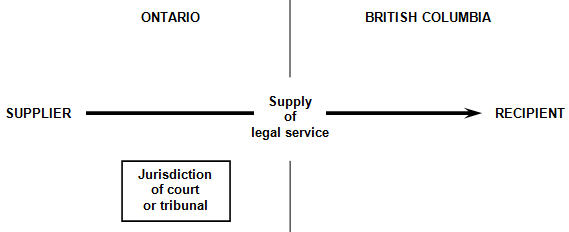
Customs brokerage services
(Section 25 of Division 5 of Part 1 of the Regulations)
A customs brokerage service means a service in respect of the importation of goods that consists of arranging for the release of imported goods (as defined under subsection 2(1) of the Customs Act) or of fulfilling, in respect of the importation, any requirement under the Customs Act or the Customs Tariff to account for the goods, to report, to provide information or to remit any amount.
Rule 1
The supply of a customs brokerage service in respect of imported goods accounted for as commercial goods (as defined under subsection 212.1(1)) under section 32 of the Customs Act is made in the province in which the goods are situated at the time of their release. "Commercial goods" means goods that are imported for sale or for any commercial, industrial, occupational, institutional or other like use.
Rule 2
The supply of a customs brokerage service in respect of imported goods that are not accounted for as commercial goods is made in a participating province if tax, calculated at the tax rate for the participating province, is imposed under subsection 212.1(2), or would be so imposed if various provisions did not apply in respect of the importation, such as:
- subsection 212.1(3) which applies to imported goods accounted for as commercial goods, imported specified motor vehicles, or imported mobile homes or floating homes that have been used or occupied in Canada by any individual;
- subsection 212.1(4) which applies to certain goods imported by or on behalf of persons who are resident in the Nova Scotia offshore area or the Newfoundland offshore area; and
- section 213 which relieves imported goods that qualify as non-taxable importations from the imposition of the GST or federal part of the HST.
Rule 3
In any other case, the supply of the customs brokerage service is made in a non-participating province.
These rules do not apply to the supply of any service provided in relation to an objection, appeal, re-determination, re-appraisal, review, refund, abatement, remission or drawback, or in relation to a request for any of the foregoing. These types of services are subject to the place of supply rules for services described in other parts of this section.
Other services supplied by customs brokers would generally be subject to the general place of supply rules for services.
Example 133
A customs broker in Quebec arranges for the release in Ontario of imported non-commercial taxable goods for a client who is a consumer residing in Ontario. The goods are shipped to the home address of the consumer in Ontario.
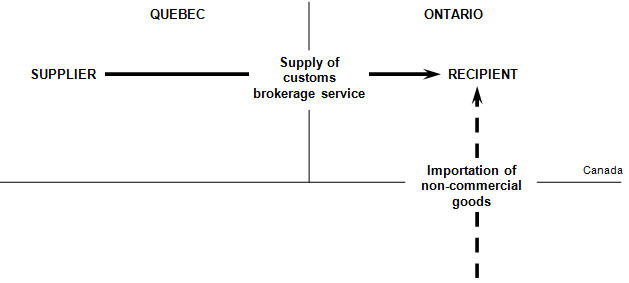
The supply of the customs brokerage service is made in Ontario because the Ontario provincial part of the HST is imposed in respect of the importation of the goods. As a result, the supply is subject to HST at a rate of 13%.
Example 134
A customs broker in Quebec arranges for the release in Ontario of imported commercial goods for a business that is located in Ontario. The goods are shipped to the business address of the business in Ontario.
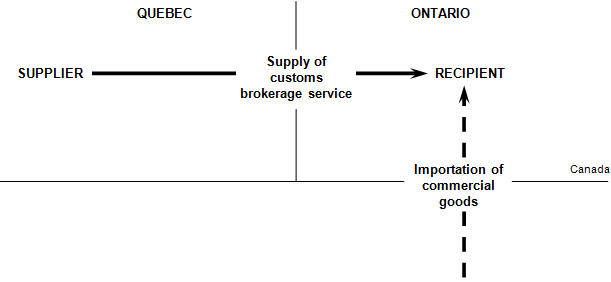
The supply of the customs brokerage service is made in Ontario because the goods are released in Ontario. As a result, the supply of the service is subject to HST at a rate of 13%.
Repairs, maintenance, cleaning, adjustments, alterations and photographic-related goods
(Section 29 of Division 5 of Part 1 of the Regulations)
No changes have been made to the place of supply rule that applies where a supplier receives tangible personal property of another person for the purpose of either
- supplying a service of repairing, maintaining, cleaning, adjusting or altering the property, or
- producing a negative, transparency, photographic print or other photographic-related good.
The supply of the service (and of any property supplied in connection with it) or of the photographic-related good is made in a province if the supplier delivers the property or the photographic-related good in that province to the recipient of the supply after the service or production of the photographic-related good is completed. Where the relevant conditions have been met, this place of supply rule overrides the place of supply rule for supplies of services in relation to tangible personal property and the general place of supply rules for supplies of tangible personal property.
A service of repairing a good generally means a service of restoring a good to its original operating condition after damage or wear including the fixing or replacement of parts of the good.
A service of maintaining a good generally means a service that preserves or provides for the preservation of the good in good condition.
A service of cleaning a good generally means a service of making a good free of dirt, marks, stains or unwanted matter including by washing, brushing or wiping the good.
A service of adjusting a good generally means a corrective action to bring a good into a proper state or condition to conform to a standard.
A service of altering a good generally means a service that changes a good without changing its essential character. It excludes a service that destroys the essential character of a good or results in the creation of a new or commercially different good with different essential characteristics. It excludes a service of manufacturing or producing a good.
Generally, tangible personal property is considered to be delivered where its possession is transferred. However, for purposes of this rule, tangible personal property is also deemed to be delivered in a particular province, and not in any other province, if the supplier either
- ships the property to a destination in the province that is specified in the contract for carriage of the property or transfers possession of the property to a common carrier or consignee that the supplier has retained on behalf of the recipient to ship the property to such a destination; or
- sends the property by mail or courier to an address in the particular province.
Example 135
A consumer in Ontario hires an auto repair shop in Ontario to repair his vehicle at the repair shop. The vehicle is delivered to the auto repair shop by the consumer who picks it up after the repair service is completed.

The repaired vehicle is delivered to the consumer in Ontario. Therefore, the supply of the service is made in Ontario and subject to HST at a rate of 13%.
Example 136
A consumer drops off some clothing at a dry cleaner in Newfoundland and Labrador and picks up the dry-cleaned clothing at the dry cleaner the next day.

The dry cleaned clothing is delivered to the consumer in Newfoundland and Labrador. Therefore, the supply of the service is made in Newfoundland and Labrador and subject to HST at a rate of 13%.
Example 137
A consumer drops off a pair of pants at a tailor in Manitoba for alterations and picks up the altered pants at the tailor's location the next day.

The altered pants are delivered to the consumer in Manitoba. Therefore, the supply of the service is made in Manitoba and subject to GST at a rate of 5%.
Example 138
A consumer in Ontario sends a computer needing repair to a computer repair depot in Quebec. The computer repair depot repairs the computer in Quebec and then ships it to the consumer in Ontario.
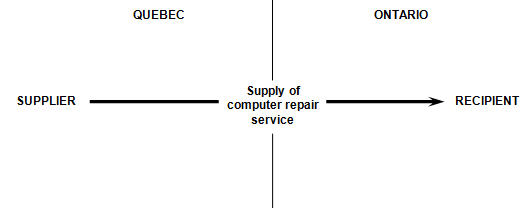
The supply of the repair service is made in Ontario because the repaired computer is shipped to the consumer at an address in Ontario. As a result, the supply of the repair service is subject to HST at a rate of 13%.
Example 139
A consumer in Quebec sends a musical instrument needing repair to a repair store in Ontario. The repair store repairs the instrument in Ontario and then ships it to the consumer in Quebec.
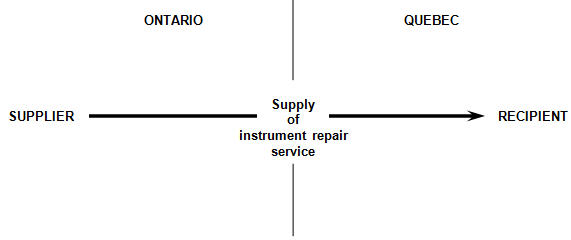
The supply of the repair service is made in Quebec because the repaired instrument is shipped to the consumer at an address in Quebec. As a result, the supply of the repair service is subject to GST at a rate of 5%.
Example 140
A manufacturer in Alberta sends parts to a company in Ontario to paint the parts a certain colour. The manufacturer ships the parts to the company in Ontario. The company in Ontario then ships the painted parts back to the manufacturer in Alberta.
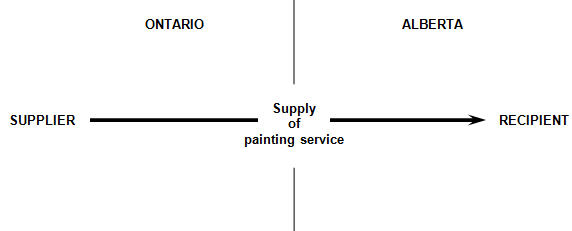
The supply of the painting service is made in Alberta because the painted parts are shipped to the recipient at an address in Alberta. As a result, the supply of the painting service is subject to GST at a rate of 5%.
Services of a trustee in respect of a trust governed by an RRSP, RRIF, RESP, TFSA or RDSP
(Section 30 of Division 5 of Part 1 of the Regulations)
For purposes of this place of supply rule, the following terms have the meaning assigned by subsection 248(1) of the Income Tax Act:
- RRSP means a registered retirement savings plan,
- RRIF means a registered retirement income fund,
- RESP means a registered education savings plan,
- TFSA means a tax free savings account,
- RDSP means a registered disability savings plan.
A supply of a service in respect of a trust governed by an RRSP, an RRIF an RESP, an RDSP or a TFSA provided by a trustee of the trust is made in a province if the mailing address of the annuitant of the RRSP or RRIF or of the subscriber of the RESP or of the holder of the RDSP or TFSA is in that province.
Generally, where the service in respect of the trust is provided by a person other than the trustee of the trust, the place of supply of the service is determined by the general place of supply rules for services.
Example 141
A trustee in Quebec supplies a service in respect of a trust governed by an RRSP to an annuitant of the RRSP who has a mailing address in Ontario.
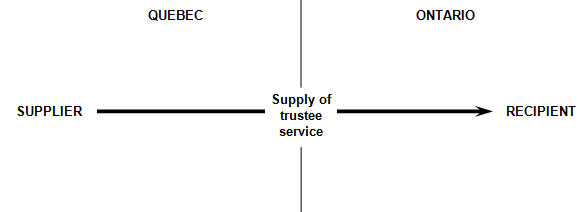
The supply of the service is made in Ontario because the mailing address of the annuitant is in Ontario. As a result, the supply of the service is subject to HST at a rate of 13%.
1-900 or 976 service
(Section 31 of Division 5 of Part 1 of the Regulations)
A supply of a service provided by telephone and accessed by calling a number beginning with the digits 1-900 or containing the local telephone prefix 976 is made in the province in which the telephone call originates.
Example 142
An individual makes a 1-900 telephone call from Ontario. The service is supplied by a company in Ontario.

The supply of the service is made in Ontario because the call originates in Ontario. As a result, the supply of the service is subject to HST at a rate of 13%.
Computer-related services and Internet access
(Section 32 of Division 5 of Part 1 of the Regulations)
Defined terms
Canadian rights in respect of intangible personal property, means that part of the property that can be used in Canada.
A computer-related service means:
- a technical support service that is provided by means of telecommunications and relates to the operation or use of computer hardware or software; or
- a service involving the electronic storage of information and computer-to-computer transfer of information.
A final recipient in respect of a computer-related service or access to the Internet, means a person that is the recipient of a supply of the service or access and that acquires it otherwise than for the purpose of supplying it to another person.
Computer-related services and Internet access
The place of supply rules for supplies of computer-related services and Internet access have not changed. Generally, the rules depend on whether the supply is made to a single final recipient or to multiple final recipients.
These rules override other place of supply rules that could otherwise apply to the supplies of computer-related services and Internet access. For instance, a supply of Internet access is a supply of a telecommunication service consisting of the making available of telecommunications facilities. However, the place of supply rule explained in this section overrides the application of the place of supply rules for telecommunication services with respect to the supply of Internet access.
Single final recipient
If there is to be a single final recipient of a supply of a computer-related service or Internet access made by a particular supplier, and the recipient acquires the supply under an agreement with either the particular supplier or another supplier, the supply is made in a province if the final recipient avails itself of the service or access at a single ordinary location in that province, and
- the particular supplier maintains information sufficient to determine that location; or
- it is the normal business practice of the particular supplier to obtain information sufficient to determine that location.
In any other case where there is to be a single final recipient of the supply, the supply is made in a province if the mailing address of the recipient of the supply is in that province.
Example 143
A Quebec company provides computer and software technical support services by telephone and e-mail to an Ontario company. The technical support services are only available to employees of the Ontario company who work at the company's business location in Ontario and call from that location.
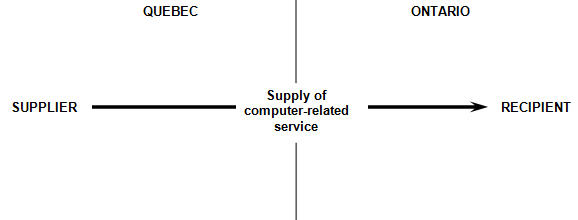
The supply of the computer-related service is made in Ontario because the final recipient, the Ontario company, avails itself of the service from a single ordinary location that is in Ontario and the supplier maintains sufficient information to determine that location. As a result, the supply of the computer-related service is subject to HST at a rate of 13%.
Example 144
An Internet service provider (ISP) based in Nova Scotia supplies Internet access to clients situated in Nova Scotia and New Brunswick. The ISP supplies Internet access to a business client that is situated in Nova Scotia. Under the agreement for the supply, it is established that the client will access the Internet from its single operation in Nova Scotia. The client is acquiring the Internet access to be used in the course of its manufacturing business.

The supply is made in Nova Scotia because the recipient avails itself of the Internet access at a single ordinary location in Nova Scotia and the supplier maintains information sufficient to determine that location. The supply of the Internet access is therefore subject to HST at a rate of 15%.
Multiple final recipients
A different place of supply rule applies if there are to be multiple final recipients of a supply of a computer-related service or Internet access made by a particular supplier and each final recipient acquires the supply under an agreement with either the particular supplier or another supplier and, in the case of each final recipient, there is a single location at which the final recipient avails itself of the service or access, and
- either the particular supplier maintains information sufficient to determine that location; or
- it is the normal business practice of the particular supplier to obtain information sufficient to determine that location.
In this case, the supply of the computer-related service is made in the province, if any, that would be determined, under the general place of supply rules for services if the service were performed in each province in which, and to the same extent to which, the final recipients avail themselves of the service. The supply of Internet access is made in the province that would be determined under the place of supply rules for intangible personal property if the Internet access were attainable in each province in which, and to the same extent to which, the final recipients avail themselves of the Internet access. In other words,
- the general place of supply rules for services apply to the supply of a computer-related service, and
- the general place of supply rules for intangible personal property apply to the supply of Internet access.
In any other case, where there are to be multiple final recipients of the supply, the supply of the computer-related service or Internet access are made in a province if the mailing address of the recipient is in that province.
Example 145
An Internet service provider (ISP) based in Nova Scotia supplies Internet access to clients situated in Nova Scotia and New Brunswick. The ISP supplies Internet access to a business client in New Brunswick that is engaged in the business of providing on-line services. The Internet access will be used by the client's employees who work from their homes in various provinces in Canada. The agreement for the supply of the Internet access is entered into between the ISP and the client with the final copy of the agreement mailed to the client at the client's business address in New Brunswick.

Because there is no single ordinary location at which the final recipient avails itself of the Internet access, the supply is made in New Brunswick, the province of the mailing address of the recipient.
Air navigation services
(Section 33 of Division 5 of Part 1 of the Regulations)
The place of supply rules for supplies of air navigation services have not changed.
A supply of an air navigation service (as defined in subsection 2(1) of the Civil Air Navigation Services Commercialization Act) is made in a province if the leg of the flight in respect of which the services are performed originates in that province.
For purposes of this place of supply rule, a leg of a flight of an aircraft means a part of the flight that begins
- where passengers embark or disembark the aircraft,
- where freight is loaded on the aircraft or unloaded from it, or
- where the aircraft is stopped to allow for its servicing or refuelling,
and that ends where it is next stopped for any of those purposes.
Example 146
Air navigation services are provided from an Ontario location to an air carrier from Ontario in respect of a Toronto-Montreal flight.
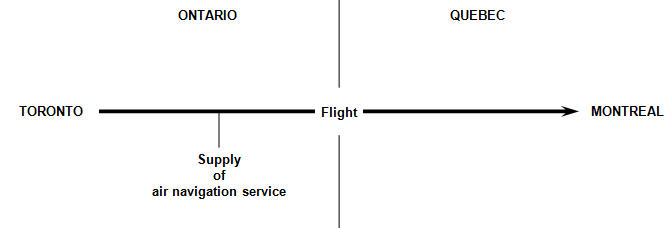
Passenger transportation
(Division 4 of Part 1 of the Regulations)
There are place of supply rules for passenger transportation that override the previously explained place of supply rules.
Defined terms
(Section 1 of Part VI of Schedule IX and section 20 of Division 4 of Part 1 of the Regulations)
A continuous journey of an individual or a group of individuals means the set of all passenger transportation services provided to the individual or group for which a single ticket or voucher in respect of all the services is issued. A continuous journey also exists where two or more tickets or vouchers are issued in respect of two or more legs of a single journey of the individual or group on which there is no stopover between any of the legs of the journey for which separate tickets or vouchers are issued, and all the tickets or vouchers are issued by the same supplier or by two or more suppliers through one agent acting on behalf of all the suppliers. This is provided that either:
- all such tickets are supplied at the same time and evidence satisfactory to the Minister is maintained by the supplier or agent that there is no stopover between any of the legs of the journey for which separate tickets or vouchers are issued, or
- the tickets or vouchers are issued at different times and evidence satisfactory to the Minister is submitted by the supplier or agent that there is no stopover between any of the legs of the journey for which separate tickets or vouchers are issued.
The origin of a continuous journey means the place where the passenger transportation service that is included in the continuous journey and that is first provided begins.
The leg of a journey on a conveyance means a part of the journey that:
- begins where passengers embark or disembark the conveyance or where it is stopped to allow for its servicing or refuelling, and
- ends where it is next stopped for any of those purposes.
A stopover, in respect of a continuous journey of an individual or a group of individuals, means any place at which the individual or group embarks or disembarks a conveyance used in the provision of a passenger transportation service included in the continuous journey, for any reason other than transferring to another conveyance or to allow for servicing or refuelling of the conveyance. However, in the case of a continuous journey of an individual or group of individuals that does not include transportation by air and the origin and termination of which are in Canada, a stopover does not include any place outside Canada where, at the time the journey begins, the individual or group is not scheduled to be outside Canada for an uninterrupted period of at least 24 hours during the course of the journey.
The termination of a continuous journey means the place where the passenger transportation service that is included in the continuous journey and that is last provided ends.
Passenger transportation services
(Section 21 of Division 4 of Part 1 of the Regulations)
The supply of a passenger transportation service is made in a participating province if:
- the passenger transportation service is part of a continuous journey in respect of which there is a ticket or voucher, issued in respect of the particular passenger transportation service included in the continuous journey that is provided first, specifying the origin of the continuous journey and the origin is a place in the participating province, and the termination and all stopovers in respect of the continuous journey are in Canada;
- the passenger transportation service is part of a continuous journey in respect of which there is no ticket or voucher, issued in respect of the particular passenger transportation service included in the continuous journey that is provided first, specifying the origin of the continuous journey and the passenger transportation service included in the continuous journey that is provided first cannot begin otherwise than in the participating province, and the termination and all stopovers in respect of the continuous journey are in Canada; or
- the passenger transportation service is not part of a continuous journey and the passenger transportation service begins in the participating province and ends in Canada.
The supply of a passenger transportation service is made in a non-participating province if:
- the passenger transportation service is part of a continuous journey in respect of which there is a ticket or voucher, issued in respect of the particular passenger transportation service included in the continuous journey that is provided first, specifying the origin of the continuous journey and the origin is a place outside the participating provinces, or the termination or a stopover in respect of the continuous journey is outside Canada;
- the passenger transportation service is part of a continuous journey in respect of which there is no ticket or voucher, issued in respect of the particular passenger transportation service included in the continuous journey that is provided first, specifying the origin of the continuous journey and the passenger transportation service included in the continuous journey that is provided first cannot begin in a participating province, or the termination or a stopover in respect of the continuous journey is outside Canada; or
- the passenger transportation service is not part of a continuous journey and the passenger transportation service begins outside the participating provinces or ends outside Canada.
The place of supply of a supply of intangible personal property that is, or is similar to, a passenger transportation pass entitling an individual to one or more passenger transportation services is determined either by the specific place of supply rules explained in the section entitled "Intangible personal property that relates to passenger transportation services", or the general place of supply rules for supplies of intangible personal property.
Example 147
An individual purchases round-trip air passenger transportation from Ottawa, Ontario to Montreal, Quebec. The ticket issued for the passenger transportation specifies Ottawa as the origin of the continuous journey.
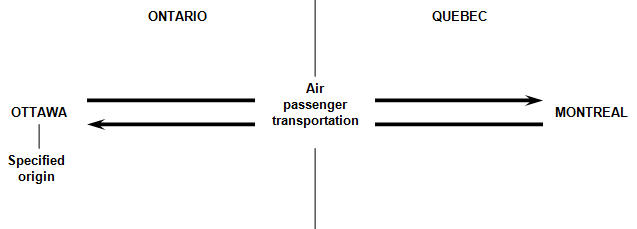
The supply of the passenger transportation service is made in Ontario because the ticket issued in respect of the passenger transportation service that is provided first and included in the continuous journey specifies the origin of the continuous journey as being in Ontario and there is no termination or stopover outside Canada. Therefore, the supply of the passenger transportation service is subject to HST at a rate of 13%.
Example 148
An individual purchases round-trip air passenger transportation from Ottawa to Boston. Ottawa is specified as the origin of the continuous journey on the ticket.
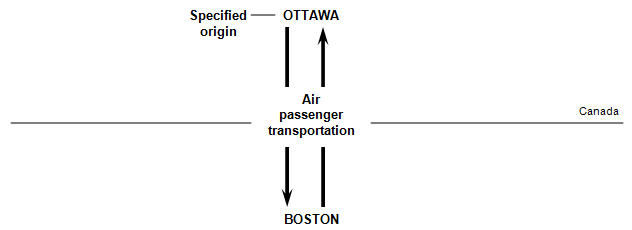
The supply of the passenger transportation service is made in a non-participating province. Although the ticket issued in respect of the passenger transportation service that is provided first and included in the continuous journey specifies that the origin of the continuous journey is in Ontario, there is a stopover outside Canada. The supply of the passenger transportation service is therefore subject to GST at a rate of 5%.
Example 149
An individual purchases a ticket for a flight from Toronto, Ontario to London, England. The ticket issued for the flight specifies Toronto as the origin of the continuous journey.
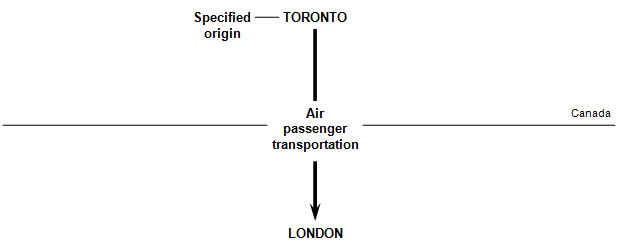
The supply of the passenger transportation service is made in a non-participating province. Although the ticket issued in respect of the passenger transportation service that is provided first and included in the continuous journey specifies that the origin of the continuous journey is in Ontario, the termination of the continuous journey is outside Canada. The supply is zero-rated as an export under section 3 of Part VII of Schedule VI because the termination of the continuous journey is outside the taxation area.
Example 150
A resident of Ontario purchases a booklet of ten tickets for round-trip rail passenger transportation from Toronto to Montreal. The tickets specify Toronto as the origin of each trip.
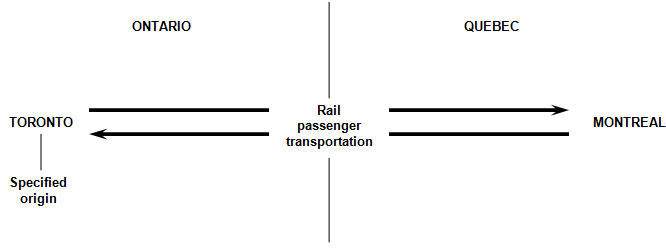
The supplies of the passenger transportation services are made in Ontario because the tickets issued in respect of the first provided passenger transportation service included in the continuous journey specifies that the origin of the continuous journey is in Ontario. Therefore, the supplies of the passenger transportation services are subject to HST at a rate of 13%.
Tangible personal property and services supplied during passenger transportation services
Supplies made during international flight or international voyage
(Section 180.1)
A supply of tangible personal property or a service (other than a passenger transportation service) is deemed to be made outside Canada and is therefore not subject to tax if
- it is made to an individual on board an aircraft on an international flight or a vessel on an international voyage, and
- physical possession of the property is transferred to the individual, or the service is wholly performed, on board the aircraft or vessel.
An international flight means any flight (other than a flight originating and terminating in Canada) of an aircraft that is operated by a person in the course of a business of supplying passenger transportation services.
An international voyage means any voyage (other than a voyage originating and terminating in Canada) of a vessel that is operated by a person in the course of a business of supplying passenger transportation services.
Example 151
An individual purchases round-trip air passenger transportation from Ottawa to Boston. The individual purchases a sandwich during the flight from Ottawa to Boston and another one during the return flight from Boston to Ottawa.
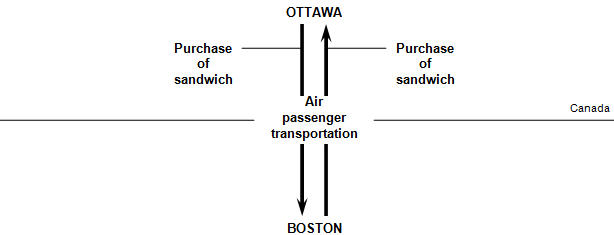
The supply of the sandwich on each flight is deemed to be made outside Canada because each supply is made during an international flight. As a result, the supplies are not subject to tax.
Tangible personal property and services supplied during passenger transportation services
(Section 23 of Division 4 of Part 1 of the Regulations)
The place of supply rule for tangible personal property and services supplied during passenger transportation services have changed. If a supply of tangible personal property or a service (other than a passenger transportation service) is made to an individual on board a conveyance in the course of a business of supplying passenger transportation services and the property or service is delivered, performed or made available on board the conveyance during any leg of the journey that begins in any province and ends in any province, the supply of the property or service is made in the province in which that leg of the journey begins.
Example 152
On a flight from Ottawa to Vancouver, a passenger purchases a beverage during the Ottawa-Calgary leg of the journey and another one during the Calgary-Vancouver leg of the journey.
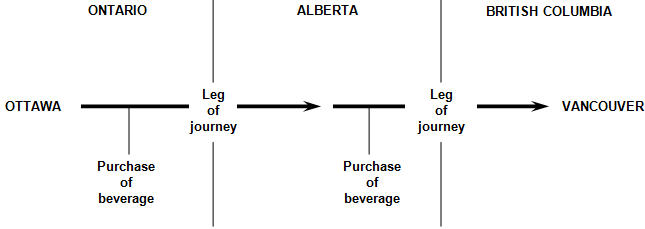
The supply of the first beverage is made during the Ottawa-Calgary leg of the journey that begins in Ontario. Therefore, the supply is made in Ontario and subject to HST at a rate of 13%. The supply of the second beverage is made during the Calgary-Vancouver leg of the journey that begins in Alberta. Therefore, the supply is made in Alberta and subject to GST at a rate of 5%.
Services related to the supply of passenger transportation services
(Sections 4 and 4.1 of Part VI of Schedule IX)
Baggage charges
(Section 4 of Part VI of Schedule IX)
The place of supply rule for a supply made by the supplier of a passenger transportation service of a service of transporting an individual's baggage in connection with the passenger transportation service has not changed. The supply is made in the same province in which the supply of the passenger transportation service is made.
Example 153
An airline supplies in British Columbia a domestic air passenger transportation service from Vancouver to Toronto. In connection with that supply, the airline charges an additional excess baggage fee to an individual who has exceeded the checked baggage allowance for the flight.
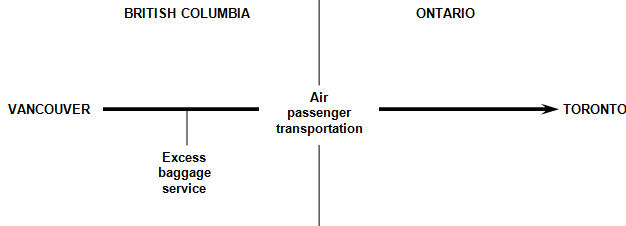
The supply of the service of transporting the excess baggage is made in British Columbia because it is the province in which the passenger transportation service is made. Therefore, the supply of the service is subject to HST at a rate of 12%.
Child Supervision
(Section 4 of Part VI of Schedule IX)
The place of supply rule for a supply made by the supplier of a passenger transportation service of a service of supervising an unaccompanied child in connection with the passenger transportation service has not changed. The supply is made in the same province in which the supply of the passenger transportation service is made.
Example 154
In connection with supplying a domestic passenger transportation service from Ottawa to Montreal that is supplied in Ontario for an unaccompanied child, an airline supplies the service of supervising the unaccompanied child.

The supply of the service of supervising the unaccompanied child is made in Ontario because it is the province in which the passenger transportation service is made. Therefore, the supply of the service is subject to HST at a rate of 13%.
Services related to a ticket, voucher or reservation
(Section 4.1 of Part VI of Schedule IX)
The place of supply rule for a supply made by a supplier of a passenger transportation service of a service of issuing, delivering, amending, replacing or cancelling a ticket, voucher or reservation for the passenger transportation service has not changed. The supply is made in the same province in which the supply of the passenger transportation service would be made, if it were completed in accordance with the agreement for that supply.
Example 155
An individual cancels a ticket for round-trip air passenger transportation from Ottawa to Toronto that specifies Ottawa as the origin of the continuous journey.

The supply of the service of cancelling the ticket is made in Ontario because the supply of the passenger transportation service for which the ticket would have applied is made in Ontario. As a result, the supply of the service of cancelling the ticket is subject to HST at a rate of 13%.
Freight transportation services
(Sections 1 and 5 of Part VI of Schedule IX)
Defined terms
(Section 1 of Part VI of Schedule IX)
A freight transportation service means a service of transporting tangible personal property and, for greater certainty, includes a service of delivering mail. A freight transportation service also includes any other property or service supplied to the recipient of the freight transportation service by the supplier of the freight transportation service if the other property or service is part of or incidental to the freight transportation service, whether there is a separate charge for the other property or service. However, a freight transportation service does not include a service provided by the supplier of a passenger transportation service of transporting an individual's baggage in connection with the passenger transportation service (refer to "Tangible personal property and services supplied during passenger transportation services").
The destination of a freight transportation service means the place specified by the shipper of the property (usually on the bill of lading or other shipping documents) where possession of the property is transferred to the person to whom the property is consigned or addressed by the shipper.
Freight transportation service
(Section 5 of Part VI of Schedule IX)
The place of supply rule for supplies of freight transportation services has not changed. A supply of a freight transportation service is made in a province if the destination of the service is in the province.
Special rules apply to most supplies of mail services supplied by the Canada Post Corporation. These rules are explained under "Postage and mail delivery services".
Example 156
A Quebec manufacturer hires a carrier to transport products from its plant in Montreal to a wholesaler in Toronto.
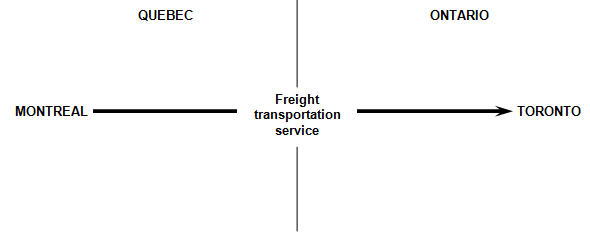
The supply of the freight transportation service is made in Ontario and is subject to HST at a rate of 13% because the destination of the freight transportation service is in Ontario.
Example 157
An individual hires a moving company to pick up his personal effects at his residence in Whitehorse, Yukon and to deliver them to a residence in Vancouver, British Columbia.
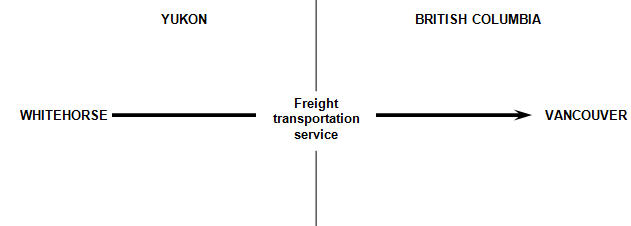
The supply of the freight transportation service is made in British Columbia and is subject to HST at a rate of 12% because the destination of the freight transportation service is in British Columbia.
Example 158
A manufacturer in British Columbia hires a carrier to transport products from the United States to a wholesaler in Ontario.

The supply of the freight transportation service is made in Ontario because the destination of the freight transportation service is in Ontario. However, the supply of the freight transportation service is zero-rated as an export under section 8 of Part VII of Schedule VI because it originates outside Canada.
Example 159
A manufacturer hires a carrier to transport products from its plant in Ottawa, Ontario to a wholesaler in Quebec, Quebec.
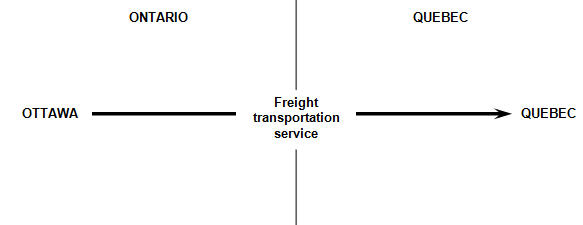
The supply of the freight transportation service is made in Quebec and is subject to GST at a rate of 5% because the destination of the service is in Quebec.
Freight transportation service with a destination in more than one province
(Section 136.3)
Where a supply of a freight transportation service has destinations in more than one province, the provision of the service of transporting the goods destined for each province is deemed to be a separate supply made for separate consideration equal to the portion of the total consideration for the supply that is reasonably attributable to the transportation of the goods to that province. As a result, if a deemed separate supply of a freight transportation service has a destination in a participating province, that supply is deemed to be made in that province for consideration equal to the portion of the total consideration that is reasonably attributable to that service and subject to HST. If a deemed separate supply of a freight transportation service has a destination in a non-participating province, that supply is deemed to be made in that province for consideration equal to the portion of the total consideration that is reasonably attributable to that service and subject to GST.
Example 160
A computer manufacturer in Toronto, Ontario hires a carrier to transport computers to two different destinations. The manufacturer sold half of the load of computers to a company located in Ottawa, Ontario, and the other half to a company in Montreal, Quebec. There is a single supply of a freight transportation service and a single charge for the service. Of the total, 40% is reasonably attributable to the transportation of the computers to Ottawa and 60% to Montreal.

The provision of the service of transporting the computers to the Ontario destination and the provision of the service of transporting the computers to the Quebec destination are each deemed to be separate supplies made for separate consideration. The provision of the service of transporting the computers to the destination in Ontario is made in Ontario. The deemed consideration for this service is equal to 40% of the total charge and is subject to HST at a rate of 13%. The provision of the service of transporting the computers to the destination in Quebec is made in Quebec. The deemed consideration for this service is equal to 60% of the total charge and is subject to GST at a rate of 5%.
Postage and mail delivery services
(Part VII of Schedule IX)
Defined terms
(Section 1 of Part VII of Schedule IX)
A postage stamp means a stamp authorized by the Canada Post Corporation for use as evidence of the payment of postage, but does not include a postage meter impression, a permit imprint or any "business reply" indicia or item bearing that indicia.
A permit imprint means an indicia the use of which as evidence of the payment of postage exclusively by a person is authorized under an agreement between the Canada Post Corporation and the person, but does not include a postage meter impression or any "business reply" indicia or item bearing that indicia.
Postage stamp and mail delivery service
(Section 2 of Part VII of Schedule IX)
The place of supply rules that apply to postage and mail delivery services have not changed.
A supply of a right to a mail delivery service as evidenced by a postage stamp or a postage-paid card, package or similar item (other than an item bearing a "business reply" indicia) that is authorized by the Canada Post Corporation is made in the province in which the supplier delivers the stamp or item to the recipient.
Generally, tangible personal property is considered to be delivered where its possession is transferred. However, for purposes of this rule, tangible personal property is also deemed to be delivered in a particular province, and not in any other province, if the supplier either
- ships the property to a destination in the province that is specified in the contract for carriage of the property or transfers possession of the property to a common carrier or consignee that the supplier has retained on behalf of the recipient to ship the property to such a destination; or
- sends the property by mail or courier to an address in the particular province.
Example 161
An individual purchases several postage stamps at a retail postal outlet in Ontario to eventually use them to mail letters.

The supply of the stamps is made in Ontario because the individual takes delivery of the stamps in Ontario. As a result, the supply of the postage stamps is subject to HST at a rate of 13%.
The supply of a mail delivery service for which the postage stamp or similar item is used as evidence of the payment of postage for the mail delivery service is made in the province in which the stamp or item is delivered.
However, this rule does not apply in circumstances where:
- the supply of the service is made pursuant to a bill of lading; or
- the consideration for the supply of the service is $5 or more and the address to which the mail is sent is not in a participating province.
In both cases, the place of supply rules explained in the section "Freight transportation service" apply to determine the place of supply of the mail delivery service which is based on the destination of the mail delivery service.
A separate place of supply rule applies to the tangible personal property that is delivered and to which the mail delivery service relates. Refer to "Tangible personal property" for more information.
Example 162
An individual in Windsor, Ontario orders by mail-order a booklet of postage stamps. The supplier delivers the booklet by mail from Halifax, Nova Scotia to the individual's address in Windsor, Ontario.

The supply of the booklet of postage stamps is made in Ontario because the supplier delivered the stamps to the individual at an address in Ontario. As a result, the supply of the booklet of postage stamps is subject to HST at a rate of 13%.
Postage meter
(Section 3 of Part VII of Schedule IX)
If the payment of postage for a mail delivery service supplied by the Canada Post Corporation otherwise than pursuant to a bill of lading is evidenced by a postage meter impression printed by a meter, the supply of the service is made in a province if the ordinary location of the meter is in the province when the recipient of the supply pays an amount to the Corporation for the purpose of paying that postage. The ordinary location of the meter at a particular time is deemed to be the location that the supplier and the recipient mutually agree is the ordinary location of the meter at that time and this location may change from time to time.
Where the exclusion applies because the supply is made pursuant to a bill of lading, the supply is subject to the general place of supply rule for freight transportation services which is based on the destination of the service.
Permit imprint
(Section 4 of Part VII of Schedule IX)
If the payment of postage for a mail delivery service supplied by the Canada Post Corporation otherwise than pursuant to a bill of lading is evidenced by a permit imprint, the supply of the service is made in the province in which the recipient of the supply deposits the mail with the Corporation in accordance with the agreement between the recipient and the Corporation authorizing the use of the permit imprint.
Where the supply is made pursuant to a bill of lading, the general place of supply rule for freight transportation services applies which is based on the destination of the service.
Business indicia
(Section 5 of Part VI of Schedule IX)
When an item bearing a "business reply" indicia is used, the place of supply rule for freight transportation services applies to determine the place of supply of the mail delivery service which is based on the destination of the mail delivery service.
Telecommunication services
(Part VIII of Schedule IX)
The place of supply rules that apply to supplies of telecommunication services have not changed.
Defined terms
(Subsection 123(1))
A telecommunication service means:
- the service of emitting, transmitting or receiving signs, signals, writing, images or sounds or intelligence of any nature by wire, cable, radio, optical or other electromagnetic system, or by any similar technical system, or
- making available for such emission, transmission or reception telecommunications facilities of a person who carries on the business of supplying services referred to above.
For GST/HST purposes, including the place of supply rules, it is important to distinguish between a supply that is a supply of a telecommunication service, and the use of telecommunications as a means by which other property and services are supplied.
A supply is generally considered to be a supply of a telecommunication service where its predominant purpose is to:
- provide for the emission, transmission or reception of signs, signals, etc. (e.g., voice or data) through a telecommunications network or similar technical system;
- make available a telecommunications facility for the emission, transmission or reception of signs, signals, etc. through a telecommunications network or similar technical system; or
- provide a means through which other services or intangible personal property (e.g., content in a digitized format) are delivered, rather than to provide the services or intangible personal property.
A supply is not generally a supply of a telecommunication service where:
- a telecommunication service is used or consumed by the supplier in making a supply of a service or property (other than a telecommunication service);
- it includes the provision of a telecommunication service, but only as a means of delivering another service or property; or
- it is incidental to the supply of another service or property.
The fact that a supply may be characterized as a telecommunication service based on the above definition and characterization indicators does not mean that the supply is subject to the place of supply rules for telecommunication services. For example, a supply of Internet access the predominant purpose of which is to provide a connection allowing for the transmission and reception of data over the Internet is a supply of a telecommunication service consisting of making available telecommunications facilities. However, the supply would be subject to the more specific place of supply rule that applies to supplies of Internet access. A supply of a service that merely uses telecommunication facilities as an input such as a supply of a Web site hosting service would not be considered to be a supply of a telecommunication service based on the above definition and characterization indicators.
A telecommunications facility means any facility, apparatus or other thing (including any wire, cable, radio, optical or other electromagnetic system, or any similar technical system, or any part thereof) that is used or is capable of being used for telecommunications.
A telecommunications channel means a telecommunications circuit, line, frequency, channel, partial channel or other means of sending or receiving a telecommunication but does not include a satellite channel.
Billing location
(Section 1 of Part VIII of Schedule IX)
For purposes of the place of supply rules that determine the province in which the supply of a telecommunication service is made, the billing location for a telecommunication service is in a province if the fee for the service is charged or applied to an account that the recipient has with the supplier of the service and the account relates to telecommunications facilities that are used or are available for use by the recipient to obtain telecommunication services and all of those facilities are ordinarily located in the province. The ordinary location of the telecommunications facilities at a particular time is deemed to be the location that the supplier and the recipient mutually agree is the ordinary location of the telecommunications facilities at that time and this location may change from time to time.
If the fee for the service is not charged or applied to an account that the recipient has with the supplier of the telecommunication service, the billing location is considered to be in a province if the telecommunications facility used to initiate the service is located in that province.
Telecommunication service
(Section 2 of Part VIII of Schedule IX)
A supply of a telecommunication service of making telecommunications facilities available (other than a service of granting sole access to a telecommunications channel) is made in a province if:
- all of the facilities are ordinarily located in that province; or
- where not all of the facilities are ordinarily located in the province, the invoice for the supply is sent to an address in that province.
For other types of supplies of telecommunication services (other than a service of granting sole access to a telecommunications channel), the supply is made in a province if the telecommunication:
- is both emitted and received in that province;
- is either emitted or received in that province and the billing location for the service is located in that province; or
- is emitted in the province and received outside the province and the billing location for the service is not in a province where the telecommunication is emitted or received.
Example 163
An individual makes a long-distance telephone call from Toronto to Ottawa using a cellular phone with a billing location in Quebec.
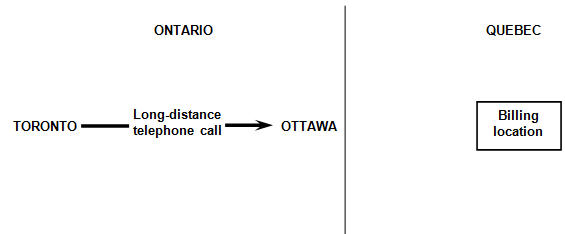
The supply of the telecommunication service is made in Ontario because the telecommunication is emitted and received in Ontario. Therefore, the supply is subject to HST at a rate of 13%.
Example 164
An individual makes a long-distance telephone call from Toronto to Montreal. The billing location for the service is in Ontario.
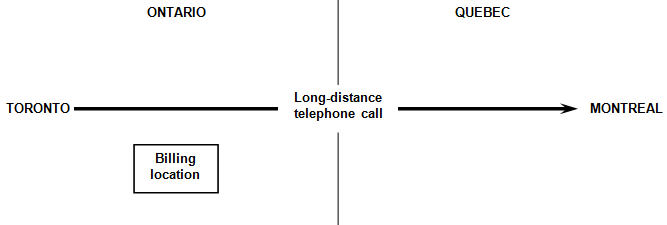
The supply of the telecommunication service is made in Ontario because the telecommunication is emitted in Ontario and the billing location for the service is in Ontario. Therefore, the supply is subject to HST at a rate of 13%.
Example 165
An individual makes a long-distance telephone call from Toronto to Vancouver. The billing location for the service is in Quebec.

Dedicated telecommunications channel
(Section 3 of Part VIII of Schedule IX)
A supply of a telecommunication service of granting sole access to a telecommunications channel is made in a province if it is deemed to be made in the province based on the application of a specific place of supply rule that deems there to be separate supplies of the service. Specifically, a supply of a service of granting sole access to a telecommunications channel for transmitting telecommunications between two provinces is deemed to be a separate supply of the service made in each of those provinces as well as a separate supply in any province between them. The consideration for the deemed supply in each province is calculated based on the part of the overall distance over which the telecommunication would be transmitted that would occur in the particular province if the telecommunication were transmitted solely by means of cable and related facilities located in Canada that connected, in a direct line, the transmitters for emitting and receiving the telecommunications.
Example 166
A Canadian telecommunication carrier leases the sole use of a telecommunications line between a place in Ontario and a place in Quebec to a corporation based in Ontario. The corporation uses the telecommunications line to transfer secure data between its offices in Toronto, Ontario and Montreal, Quebec. Of the total direct line distance in kilometres of the line between the transmitters in Ontario and Quebec 80% is located in Ontario and 20% in Quebec.

The supply of the telecommunication service of granting sole access to the telecommunications channel between Ontario and Quebec is deemed to be a separate supply of a telecommunication service made in each of those two provinces. The deemed supply of the telecommunication service made in Ontario is subject to HST at a rate of 13%. The consideration for this supply is equal to 80% of the total consideration for the sole access to the telecommunications channel.
The deemed supply of the telecommunication service made in Quebec is subject to GST at a rate of 5%. The consideration for this supply is equal to 20% of the total consideration for the sole access to the telecommunications channel.
Deemed supplies
Part IX of Schedule IX sets out a number of rules that override the place of supply rules in Schedule IX explained in previous sections of this publication in circumstances where supplies are deemed to be made pursuant to various provisions of the Act.
Deemed supplies of property
Notwithstanding the place of supply rules explained in previous sections of this publication, a supply of property that is deemed under sections 129, 129.1, 171, 171.1 and 172, subsections 183(1) and (4) and 184(1) and (3) and sections 196.1 and 268 to have been made or received at any time is made where the property is situated at that time.
Supplies deemed to be made in a province
Notwithstanding the place of supply rules in Schedule IX that are explained in previous sections of this publication, a supply of property or a service is made in a province if the supply is deemed to be made in the province under Part IX of the Act or regulations made under that Part. In addition to the drop-shipment provisions, other examples could be:
- subsection 163(2.1) that deems the provincially taxable portion of a tour package in respect of a participating province to be a supply made in that province; and
- subsection 178.8(4) that applies where a specified supply of imported goods is made outside Canada where the goods are deemed to be supplied in Canada and more specifically, in the province in which the goods are released, where the supplier and recipient of the goods enter into an agreement to have the supplier, rather than the recipient, be the person entitled to an input tax credit for the tax on the importation of the goods (for more information, refer to GST/HST Policy Statement P-125, Input Tax Credit Entitlement For Tax On Imported Goods).
Example 167
An unregistered non-resident agrees to sell goods to a registered customer in Ontario for their fair market value of $100,000. The customer will resell the goods in the course of its business. Pursuant to the agreement, delivery of the goods to the customer is to occur at the customer's premises in Ontario. The registered manufacturer of the goods who is located in Ontario agrees to sell the goods to the non-resident for $90,000 and to deliver them to the customer's premises in Ontario.
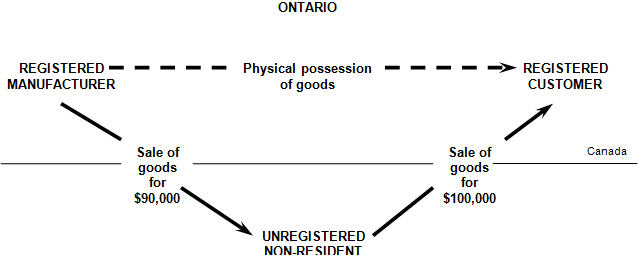
The manufacturer has made a taxable supply of the goods to the non-resident and caused physical possession of the goods to be transferred to the non-resident's customer in Ontario. Based on the application of the drop-shipment rules, the Ontario manufacturer is therefore deemed to have made a taxable supply of the goods in Ontario to the non-resident for consideration equal to their fair market value of $100,000. Therefore, the Ontario manufacturer is required to collect HST at a rate of 13% from the non-resident in respect of the supply of the goods that is equal to $13,000 (HST at a rate of 13% × the fair market value of the goods of $100,000). For more information on the drop-shipment rules, refer to GST/HST Memorandum 3.3.1, Drop-Shipments.
Enquiries by telephone
Technical enquiries on the GST/HST: 1-800-959-8287
General enquiries on the GST/HST: 1-800-959-5525 (Business Enquiries)
If you are located in Quebec: 1-800-567-4692 (Revenu Québec)
All technical publications related to the GST/HST are available on the CRA Web site at www.cra.gc.ca/gsthsttech.
Appendix A – List of examples
| Example | Description of supply | Excise Tax Act |
|---|---|---|
| 1 | Sale of tangible personal property | Section 1 of Part II of Schedule IX |
| 2 | Sale of tangible personal property | Section 3 of Part II of Schedule IX |
| 3 | Sale of tangible personal property | Section 1 of Part II of Schedule IX |
| 4 | Sale of tangible personal property | Section 1 of Part II of Schedule IX |
| 5 | Sale of tangible personal property | Section 1 of Part II of Schedule IX |
| 6 | Sale of tangible personal property | Section 3 of Part II of Schedule IX |
| 7 | Sale of tangible personal property | Section 1 of Part II of Schedule IX |
| 8 | Sale of tangible personal property | Section 3 of Part II of Schedule IX |
| 9 | Sale of tangible personal property | Section 1 of Part II of Schedule IX |
| 10 | Sale of specified motor vehicle | New place of supply rule |
| 11 | Sale of specified motor vehicle | New place of supply rule |
| 12 | Sale of specified motor vehicle | Section 1 of Part II of Schedule IX |
| 13 | Sale of specified motor vehicle | Section 1 of Part II of Schedule IX |
| 14 | Sale of specified motor vehicle | Section 1 of Part II of Schedule IX |
| 15 | Sale of specified motor vehicle | Section 1 of Part II of Schedule IX |
| 16 | Sale of specified motor vehicle | Section 1 of Part II of Schedule IX |
| 17 | Lease of tangible personal property | Subpar. 2(b)(i) of Part II of Schedule IX |
| 18 | Lease of tangible personal property | Subpar. 2(b)(i) of Part II of Schedule IX |
| 19 | Lease of tangible personal property | Subpar. 2(b)(ii) of Part II of Schedule IX |
| 20 | Lease of tangible personal property | Paragraph 2(a) of Part II of Schedule IX |
| 21 | Lease of railway rolling stock | Section 26 of Part 1 of Regulations |
| Example | Description of supply | Excise Tax Act |
|---|---|---|
| 22 | Sale of real property | Section 1 of Part IV of Schedule IX |
| 23 | Sale of real property | Section 1 of Part IV of Schedule IX |
| 24 | Sale of real property | Section 1 of Part IV of Schedule IX |
| 25 | Lease of real property | Section 1 of Part IV of Schedule IX |
| Example | Description of supply | Excise Tax Act |
|---|---|---|
| 26 | Theatre pass | Section 7 of Part 1 of the Regulations |
| 27 | Software | Ss. 6(1) of Part 1 of the Regulations |
| 28 | Franchise right | Ss. 6(1) of Part 1 of the Regulations |
| 29 | Theatre pass | Ss. 6(1) of Part 1 of the Regulations |
| 30 | Theatre pass | Ss. 6(1) of Part 1 of the Regulations |
| 31 | Fitness membership | Para. 6(2)(a) of Part 1 of the Regulations |
| 32 | Movie pass | Para. 6(2)(a) of Part 1 of the Regulations |
| 33 | Software | Para. 6(2)(b) of Part 1 of the Regulations |
| 34 | Air transportation pass | Para. 6(2)(b) of Part 1 of the Regulations |
| 35 | Fitness membership | Para. 6(2)(b) of Part 1 of the Regulations |
| 36 | Intellectual property rights | Para. 6(2)(c) of Part 1 of the Regulations |
| 37 | Transportation pass | Para. 6(2)(c) of Part 1 of the Regulations |
| 38 | Movie pass | Para. 8(a) of Part 1 of the Regulations |
| 39 | Membership | Para. 8(a) of Part 1 of the Regulations |
| 40 | Transportation pass | Para. 8(a) of Part 1 of the Regulations |
| 41 | Transportation pass | Para. 8(a) of Part 1 of the Regulations |
| 42 | Software | Para. 8(b) of Part 1 of the Regulations |
| 43 | Software | Para. 8(b) of Part 1 of the Regulations |
| 44 | Membership | Para. 8(b) of Part 1 of the Regulations |
| 45 | Membership | Para. 8(b) of Part 1 of the Regulations |
| 46 | Digital music album | Para. 8(b) of Part 1 of the Regulations |
| 47 | Web site subscription | Para. 8(b) of Part 1 of the Regulations |
| 48 | Web site subscription | Para. 8(b) of Part 1 of the Regulations |
| 49 | Web site subscription | Para. 8(b) of Part 1 of the Regulations |
| 50 | Copyright | Para. 8(b) of Part 1 of the Regulations |
| 51 | Franchise right | Para. 8(b) of Part 1 of the Regulations |
| 52 | Transportation pass | Para. 8(b) of Part 1 of the Regulations |
| 53 | Rail pass | Para. 8(b) of Part 1 of the Regulations |
| 54 | Rail pass | Para. 8(b) of Part 1 of the Regulations |
| 55 | Rail pass | Para. 8(b) of Part 1 of the Regulations |
| 56 | Air pass | Para. 8(c) of Part 1 of the Regulations |
| 57 | Air pass | Para. 8(c) of Part 1 of the Regulations |
| 58 | Rail pass | Para. 8(c) of Part 1 of the Regulations |
| 59 | Web site subscriptions | Para. 8(c) of Part 1 of the Regulations |
| 60 | Web site subscriptions | Para. 8(c) of Part 1 of the Regulations |
| 61 | Rail pass | Section 22 of Part 1 of the Regulations |
| 62 | Rail pass | Section 22 of Part 1 of the Regulations |
| 63 | Commercial bus pass | Section 22 of Part 1 of the Regulations |
| 64 | Rail pass | Section 22 of Part 1 of the Regulations |
| 65 | Rail pass | Section 22 of Part 1 of the Regulations |
| 66 | Air pass | Section 22 of Part 1 of the Regulations |
| 67 | Intangible personal property that relates to tangible personal property | Section 10 of Part 1 of the Regulations |
| 68 | Intangible personal property that relates to tangible personal property | Section 10 of Part 1 of the Regulations |
| 69 | Intangible personal property that relates to tangible personal property | Section 10 of Part 1 of the Regulations |
| 70 | Intangible personal property that relates to tangible personal property | Section 10 of Part 1 of the Regulations |
| 71 | Intangible personal property that relates to tangible personal property | Section 10 of Part 1 of the Regulations |
| 72 | Intangible personal property that relates to tangible personal property | Section 10 of Part 1 of the Regulations |
| 73 | Intangible personal property that relates to tangible personal property | Section 10 of Part 1 of the Regulations |
| 74 | Intangible personal property that relates to tangible personal property | Section 10 of Part 1 of the Regulations |
| 75 | Intangible personal property that relates to real property | Section 9 of Part 1 of the Regulations |
| 76 | Intangible personal property that relates to real property | Section 9 of Part 1 of the Regulations |
| 77 | Intangible personal property that relates to real property | Section 9 of Part 1 of the Regulations |
| 78 | Intangible personal property that relates to real property | Section 9 of Part 1 of the Regulations |
| 79 | Intangible personal property that relates to real property | Section 9 of Part 1 of the Regulations |
| 80 | Intangible personal property that relates to real property | Section 9 of Part 1 of the Regulations |
| 81 | Intangible personal property that relates to real property | Section 9 of Part 1 of the Regulations |
| 82 | Intangible personal property that relates to real property | Section 9 of Part 1 of the Regulations |
| Example | Description of supply | Excise Tax Act |
|---|---|---|
| 83 | Advertising | Para.13(1)(a) of Part 1 of Regulations |
| 84 | Web site design | Para.13(1)(a) of Part 1 of Regulations |
| 85 | Wedding planning service | Para.13(1)(a) of Part 1 of Regulations |
| 86 | Wedding planning service | Para.13(1)(a) of Part 1 of Regulations |
| 87 | Tax advice | Para.13(1)(a) of Part 1 of Regulations |
| 88 | Consulting service | Para.13(1)(a) of Part 1 of Regulations |
| 89 | Sales service | Para.13(1)(a) of Part 1 of Regulations |
| 90 | Architectural service | Para.13(1)(a) of Part 1 of Regulations |
| 91 | Legal service | Para.13(1)(b) of Part 1 of Regulations |
| 92 | Legal service | Para.13(1)(b) of Part 1 of Regulations |
| 93 | Legal service | Para.13(1)(b) of Part 1 of Regulations |
| 94 | Accounting service | Para.13(1)(b) of Part 1 of Regulations |
| 95 | Consulting service | Para.13(1)(b) of Part 1 of Regulations |
| 96 | Accounting service | Para.13(1)(b) of Part 1 of Regulations |
| 97 | Editing/translation service | Para.13(2)(a) of Part 1 of Regulations |
| 98 | Hairdressing service | Section 17 of Part 1 of Regulations |
| 99 | Dance instruction | Section 17 of Part 1 of Regulations |
| 100 | Massage service | Section 17 of Part 1 of Regulations |
| 101 | Fitness training service | Section 17 of Part 1 of Regulations |
| 102 | Tour guide service | Section 17 of Part 1 of Regulations |
| 103 | Inventory counting service | Section 15 of Part 1 of Regulations |
| 104 | Veterinary service | Section 15 of Part 1 of Regulations |
| 105 | Furniture repair service | Section 15 of Part 1 of Regulations |
| 106 | Anodizing service | Section 15 of Part 1 of Regulations |
| 107 | Storage service | Section 15 of Part 1 of Regulations |
| 108 | Legal service | Section 15 of Part 1 of Regulations |
| 109 | Sales representative service | Section 15 of Part 1 of Regulations |
| 110 | Legal service | Section 15 of Part 1 of Regulations |
| 111 | Repair service | Section 15 of Part 1 of Regulations |
| 112 | Testing service | Section 16 of Part 1 of Regulations |
| 113 | Testing service | Section 16 of Part 1 of Regulations |
| 114 | Painting service | Section 14 of Part 1 of Regulations |
| 115 | Architectural service | Section 14 of Part 1 of Regulations |
| 116 | Painting service | Section 14 of Part 1 of Regulations |
| 117 | Painting service | Section 14 of Part 1 of Regulations |
| 118 | Seismic survey service | Section 14 of Part 1 of Regulations |
| 119 | Real estate broker service | Section 14 of Part 1 of Regulations |
| 120 | Maintenance service | Section 14 of Part 1 of Regulations |
| 121 | Irrigation system installation service | Section 14 of Part 1 of Regulations |
| 122 | Landscaping service | Section 14 of Part 1 of Regulations |
| 123 | Geological survey service | Section 14 of Part 1 of Regulations |
| 124 | Engineering service | Section 14 of Part 1 of Regulations |
| 125 | Inspection service | Section 14 of Part 1 of Regulations |
| 126 | Musical performance | Section 28 of Part 1 of Regulations |
| 127 | Audio-visual service | Section 28 of Part 1 of Regulations |
| 128 | Wedding planning service | Section 28 of Part 1 of Regulations |
| 129 | Musical performance | Section 28 of Part 1 of Regulations |
| 130 | Legal service | Section 27 of Part 1 of Regulations |
| 131 | Legal service | Section 27 of Part 1 of Regulations |
| 132 | Legal service | Section 27 of Part 1 of Regulations |
| 133 | Custom brokerage service | Section 25 of Part 1 of Regulations |
| 134 | Custom brokerage service | Section 25 of Part 1 of Regulations |
| 135 | Auto repair service | Section 29 of Part 1 of Regulations |
| 136 | Dry cleaning service | Section 29 of Part 1 of Regulations |
| 137 | Alteration service | Section 29 of Part 1 of Regulations |
| 138 | Computer repair service | Section 29 of Part 1 of Regulations |
| 139 | Instrument repair service | Section 29 of Part 1 of Regulations |
| 140 | Painting service | Section 29 of Part 1 of Regulations |
| 141 | Trustee service | Section 30 of Part 1 of Regulations |
| 142 | 1-900 service | Section 31 of Part 1 of Regulations |
| 143 | Computer-related service | Section 32 of Part 1 of Regulations |
| 144 | Internet access | Section 32 of Part 1 of Regulations |
| 145 | Internet access | Section 32 of Part 1 of Regulations |
| 146 | Air navigation service | Section 33 of Part 1 of Regulations |
| 147 | Air passenger transportation service | Section 21 of Part 1 of Regulations |
| 148 | Air passenger transportation service | Section 21 of Part 1 of Regulations |
| 149 | Air passenger transportation service | Section 21 of Part 1 of Regulations |
| 150 | Rail passenger transportation service | Section 21 of Part 1 of Regulations |
| 151 | Supply of good during air passenger transportation service | Section 180.1 |
| 152 | Supply of good during air passenger transportation service | Section 23 of Part 1 of Regulations |
| 153 | Excess baggage service | Section 4 of Part VI of Schedule IX |
| 154 | Child supervision service | Section 4 of Part VI of Schedule IX |
| 155 | Ticket cancellation service | Section 4.1 of Part VI of Schedule IX |
| 156 | Freight transportation service | Section 5 of Part VI of Schedule IX |
| 157 | Freight transportation service | Section 5 of Part VI of Schedule IX |
| 158 | Freight transportation service | Section 5 of Part VI of Schedule IX |
| 159 | Freight transportation service | Section 5 of Part VI of Schedule IX |
| 160 | Freight transportation service | Section 5 of Part VI of Schedule IX |
| 161 | Postage stamps | Section 2 of Part VII of Schedule IX |
| 162 | Postage stamps | Section 2 of Part VII of Schedule IX |
| 163 | Telecommunication service | Section 2 of Part VIII of Schedule IX |
| 164 | Telecommunication service | Section 2 of Part VIII of Schedule IX |
| 165 | Telecommunication service | Section 2 of Part VIII of Schedule IX |
| 166 | Dedicated telecommunications channel | Section 3 of Part VIII of Schedule IX |
| 167 | Drop-shipment of goods | Section 179 |
Appendix B – Sales of specified motor vehicles
| Province of vehicle delivery | Province of vehicle registration |
Date of vehicle registration |
Place of supply |
Provincial part of HST collectible by supplier 2 | Provincial part of HST payable at registration | Eligibility for rebate of HST |
|---|---|---|---|---|---|---|
| ON, NS, NB, BC, NL 1 | Non-participating province | Within 7 days after delivery date | Non-participating province | None | None | None |
| ON, NS, NB, BC, NL | ON, NB, NL | Within 7 days after delivery date | ON, NB, NL 3 | 8% | None | None |
| ON, NS, NB, BC, NL | NS | Within 7 days after delivery date | NS 3 | 10% | None | None |
| ON, NS, NB, BC, NL | BC | Within 7 days after delivery date | BC 3 | 7% | None | None |
| ON, NB, NL | Non-participating province | More than 7 days after delivery date | ON, NB, NL | 8% | None | 8% |
| NS | Non-participating province | More than 7 days after delivery date | NS | 10% | None | 10% |
| BC | Non-participating province | More than 7 days after delivery date | BC | 7% | None | 7% |
| ON, NB, NL | BC | More than 7 days after delivery date | ON, NB, NL | 8% | None | 1% |
| NS | ON, NB, NL | More than 7 days after delivery date | NS | 10% | None | 2% |
| NS | BC | More than 7 days after delivery date | NS | 10% | None | 3% |
| ON, NB, NL | NS | More than 7 days after delivery date | ON, NB, NL | 8% | 2% | None |
| BC | ON, NB, NL | More than 7 days after delivery date | BC | 7% | 1% | None |
| BC | NS | More than 7 days after delivery date | BC | 7% | 3% | None |
| Non-participating province | Non-participating province | Any date | Non-participating province | None | None | None |
| Non-participating province | ON, NB, NL | Any date | Non-participating province | None | 8% | None |
| Non-participating province | NS | Any date | Non-participating province | None | 10% | None |
| Non-participating province | BC | Any date | Non-participating province | None | 7% | None |
1. ON=Ontario, NS = Nova Scotia, NB = New Brunswick, BC = British Columbia, NL = Newfoundland and Labrador
2. In addition to the 5% federal part of the HST (i.e. the GST) and where the new administrative place of supply rule has been applied by the supplier.
3. The new rule would not apply where vehicle delivery and vehicle registration occur in the same province. In this case, the place of supply will be the province of vehicle delivery based on the general rule
Appendix C – Place of supply rules for supplies of intangible personal property

Appendix D – Place of supply rules for services
